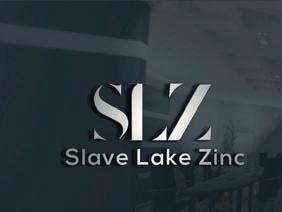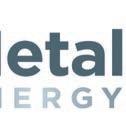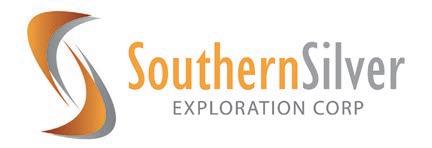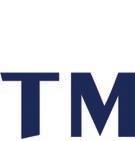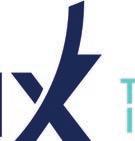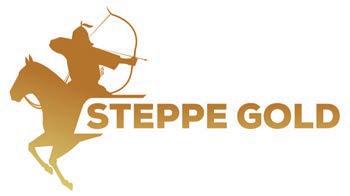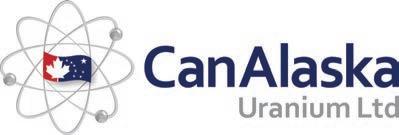SOUTHWEST US



Engaging in the global critical minerals market means fac ing up to the huge challenge presented by China, says Neo Per formance Materials’ (TSX: NEO) CEO and president Constantine Karayannopoulos.
Speaking during an exclusive Q&A session at the Critical Minerals Summit 2022, held at the National Club in downtown Toronto on Nov. 9, Karayannopoulos outlined the task ahead for Western countries and companies.
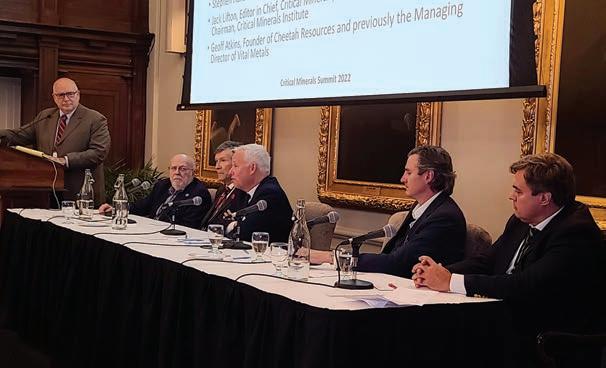
“We should do a session just on that alone,” the CEO told moder ator and summit organizer Tracy Weslosky, who is also the CEO of InvestorIntel.
China poorly understood While the CEO said that Neo has four plants, including two rare earth refineries in China, many West erners have failed to understand the how and why of the east Asian country’s industrial development.
“For the last 20 years there has been a very rational, deliberate industrial strategy that would have been very easy to predict today if you had been following how each successive five-year plan plays into that industrial strategy,” he said.
“They’re absolutely determined to dominate the electric vehicle market [and] 34% of all EVs are made and sold in China…in order to achieve that they need raw mate rial security.”
For China to achieve its decar bonization and electrification tar gets will require trillions of dollars of investment, as it will for the rest of the world, Karayannopoulos explained.
“That’s mind boggling. There’s a massive task ahead of us and I don’t think governments around the world really appreciate how complex this is. I consider myself an environmentalist. [But] you can’t have your cake and eat it too. If you want to decarbonize…we need more factories to take what ever comes out of the mines and make them into the products that will allow us to decarbonize.”
But such enormous industrial development in the West will have to be done by skilled profession als, and Weslosky asked Karayan nopoulos where they would come from.
“It has taken two decades for the supply chains to migrate from North America to Asia,” he said. “It will take at least as long for them to come back. And it starts with edu cation. China graduates more engi neers than in North America we’re graduating graduates!”
Diversify supply, but wisely
The Neo president also touched on where critical minerals might be mined in the coming years, and gave the example of his company’s efforts to source rare earths from Greenland.
In August, it announced it had secured a licence from Hudson Resources (TSXV: HUD) for its Sarfartoq Carbonatite Complex to explore for neodymium and pra seodymium at relatively high ratios of 25%-40% total rare earth oxides, according to a 2011 preliminary economic assessment.

He acknowledged that the largely undeveloped country guards its resources closely, and permits no oil and gas development and no uranium mining.
But he added that Neo took the time to consult properly with the Greenlandic government.
“We really need to understand the lay of the land, to make sure that you’ve done all the right things. Don’t walk into people’s geography and expect to be in business just like that,” he said.
Karayannopoulos spoke at the summit just hours after it was announced that his company was awarded a grant of up to €18.7 mil lion ($25.3 million) from the Esto
nian government under Europe’s Just Transition Fund for its rare earth permanent magnet manu facturing plant in the Baltic state. It was reportedly the first ever grant given out to a critical minerals company in the European Union.
Both that facility and its Green land project are part of the Toron to-based company’s aim to diversify rare earth sources and expand sup ply chains.
Karayannopoulos’ talk was among several presentations and panel discussions held at the sum mit where the subject of China was prominent.
Beijing’s top-down advantage
Of the many ways by which China has climbed to the top of the crit ical minerals market, its political system — unburdened by electoral mandates — is a major factor.
“[China] has a longer term out look than we do in the U.S. and we teeter totter more than China because of the political structure,” said Jacob Koelsch, a research asso ciate at government relations firm J.A. Green, on a panel about gov ernment investment in critical minerals.
“We can’t match their continu ity of planning and development,” he said.
And China’s massive criti cal minerals development can be organized through longer plan ning periods than in democratic countries, explained Alastair Neill, director of the Critical Minerals
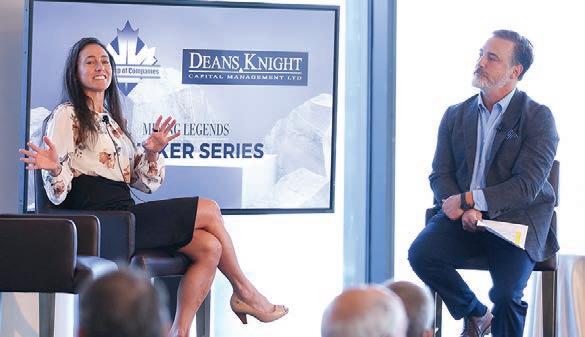
At the most recent Mining Legends Speaker Series event at the Fairmont Pacific Rim in Vancouver, guest speaker Andrée St-Germain, CFO of Integra Resources (TSXV: ITR; NYSE-AM: ITRG) and the 2018 recipient of the Young Mining Professionals’ Eira Thomas Award, spoke candidly about her career pivot from investment banking into mining and why it was the ‘scariest decision’ of her life.
Organized by The Northern Miner, the Canadian Mining Hall of Fame and Young Mining Professionals, the Mining Leg ends Speaker Series pairs CMHF inductees (in this case Bob Quar termain) with accomplished young talent and gives the audi ence a chance to ask questions to bridge the knowledge gap in the industry and discuss the oppor tunities and challenges inherent to the future of mining.
St-Germain holds an MBA in Finance from York University and began her career in invest ment banking at Dundee Capi tal markets, working with mining companies on M&A advisory and financing. In 2013 she joined Golden Queen Mining as CFO, and then moved to Integra Gold as CFO in early 2017 and helped oversee its sale to Eldorado Gold that same year for $590 million. She is also a director of Osisko Metals (TSXV: OM) and an advi sor at Wyloo Metals, which took over Ontario-focused Noront
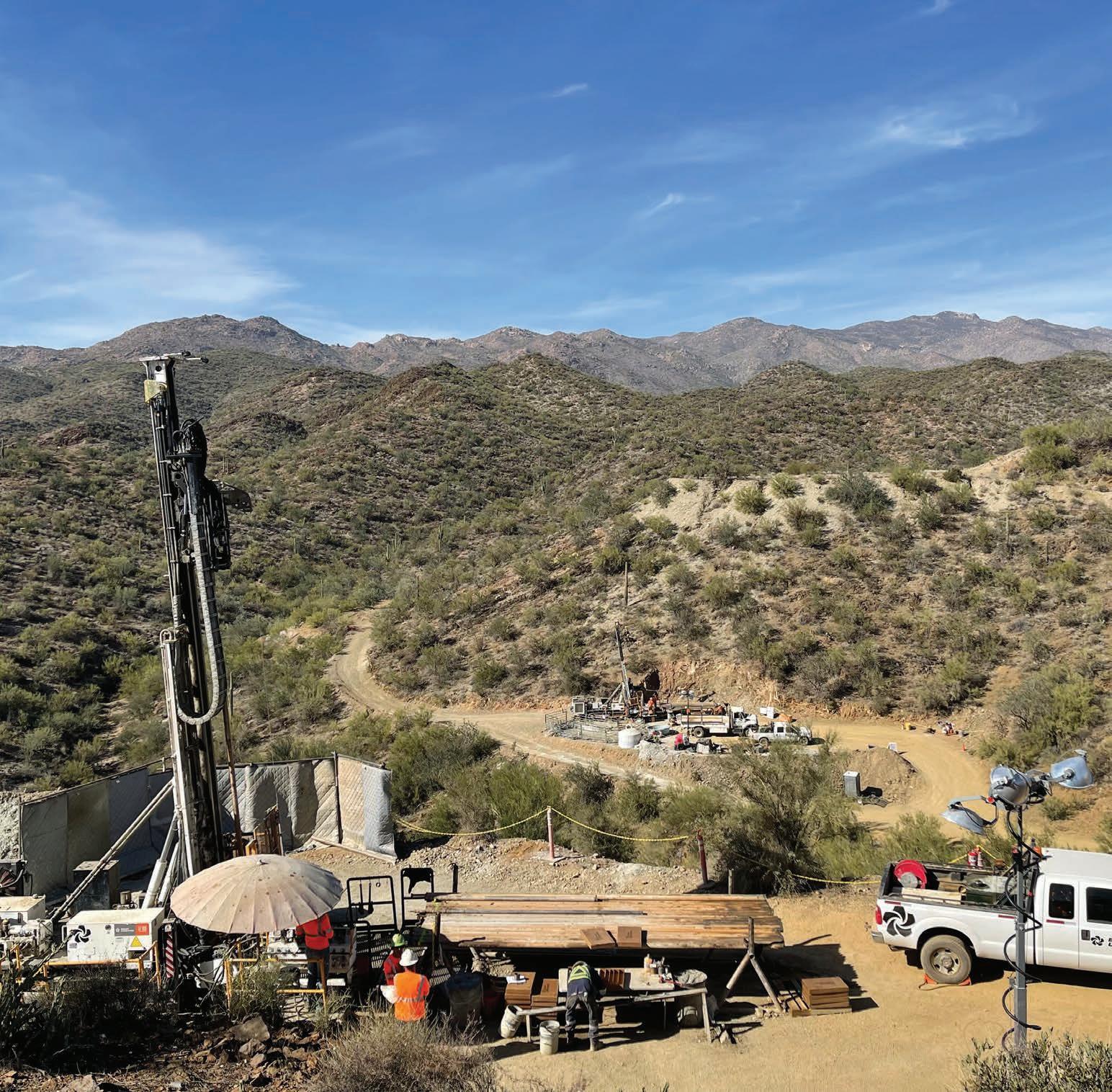

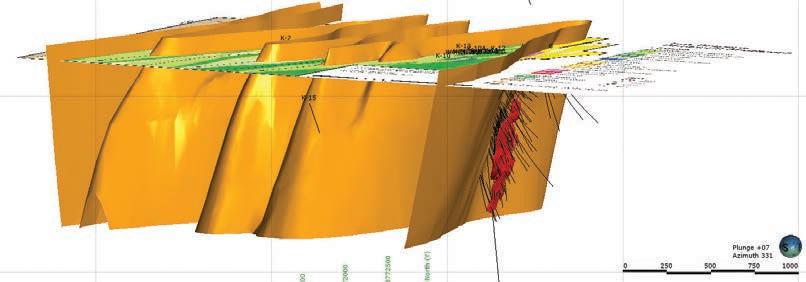
Metal Energy Corp. (TSXV: MERG; US-OTC: MEEEF) a Toronto-based battery metal exploration company, is actively expanding high-grade nickel sulphide mineralization at the pastproducing Manibridge mine in the world-class Thompson Nickel Belt of northern Manitoba.

The company is expecting to complete a 10,000-metre diamond drill program in December at Manibridge, a former Falconbridge operation that produced 1.3 million tonnes at 2.55% nickel and 0.27% copper from 1971 to 1977.
Metal Energy completed its first drill program on the project last winter. Highlights include hole No. 4, which intercepted 0.92% nickel over 33 metres starting at a depth of 150.5 metres, including 1.24% nickel over 11.5 metres. Hole No. 3 cut 0.81% nickel over 13.5 metres starting at 337.5 metres; and hole No. 6 yielded 1.13% nickel over 9 metres starting at 700 metres, including 1.62% nickel over 5 metres.
Pleased with the winter results, the company completed 5,331 metres of drilling in 19 holes this summer from June to July. Sixteen holes reached bedrock, each intersecting nickel-copper-cobalt sulphide mineralization verified by X-ray fluorescence. Sulphide-rich zones range from 1 metre to 55 metres thick, the company says, with an average thickness exceeding 15 metres at depths between 150 metres and 300 metres. The zones may be amenable to open pit mining, said James Sykes, CEO of Metal Energy. All of these assay results are pending.

“Combined with the six drill holes from our winter program, we have a 100% nickel-sulphide intersection success rate in all of our completed drill holes at Manibridge,” he said. “We’ve drilled wide and tight-spaced holes across a kilometre strike length as deep as 700 metres. Mineralization is robust and open in all directions, especially at depth beyond the current scope of drilling, which has identified structurally-controlled highgrade mineralization potential.”
The company benefits from extensive exploration data at Manibridge, in addition to its mining history. The mine, 32 km southwest of the community of Wabowden, last operated in the 1990s in a lower nickel price environment, said Sykes, adding the company is one to two years from having calculated resources.
“The logistics are all here,” he said. “It has easy access. We didn’t have to prep the ground for anything. We can drive up right to where we want to go and that’s exactly where we are drilling. It’s been super simplistic that way.”
The company’s recent option agreement with Mistango River Resources (CSE: MIS) provides a unique opportunity to continue exploration with minimal dilution, greater insider ownership aligning with shareholders, and capital preservation, said Sykes.
Mistango can spend $1.5 million to earn 15% of the 43.7-sq.-km Manibridge project. Metal Energy holds a 70% interest, while CanAlaska Uranium (TSXV: CVV) holds the remaining share. The company can buy back the Mistango interest for $2.25 million with a 2024 deadline.
“We are excited to renew our Phase 2 drill program and complete the remaining 4,669 metres as we progress southwest along this fertile
Of the holes drilled to date, surface coordinates were within 300 metres to 600 metres of the Manibridge mine, said Sykes. The remaining holes are moving to within 150 metres to 300 metres of the workings to depths between 225 metres to 400 metres.
“Really, having the drill density from historic drill holes hasn’t provided us with too much information because they didn’t sample as much,” he said. “We sample more than they used to, and we’re showing there are more nickel sulphides in the ground than were originally recognized.”
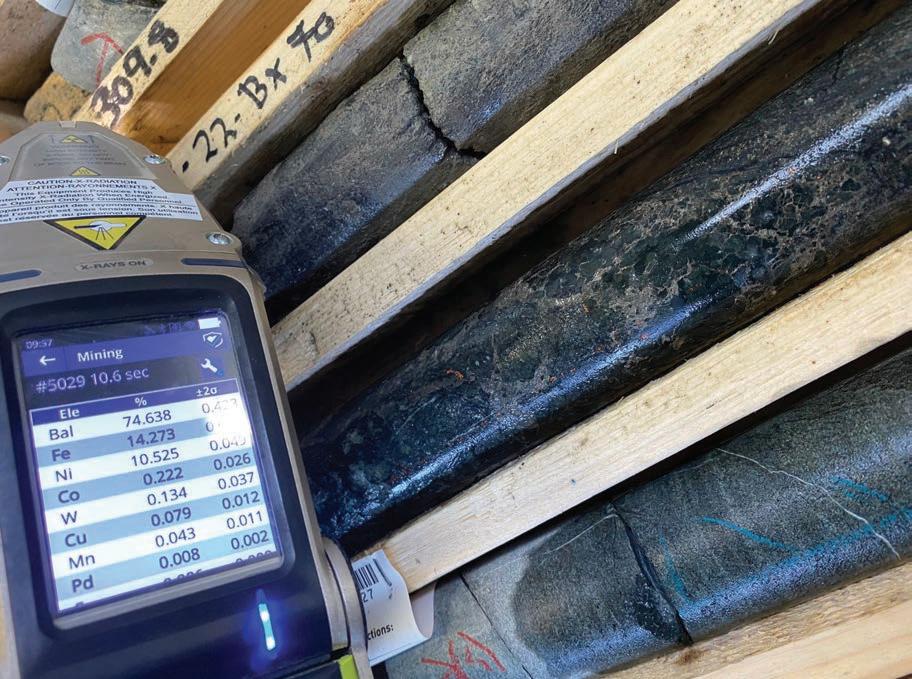
Despite a lack of geochemical data in some cases, historic drilling is guiding exploration at Manibridge, said Sykes. Historic intercepts include 8.7 metres of 4.5% nickel at a depth of 203 metres, 24.08 metres of 2.93 % nickel at 186 metres, and 16.77 metres of 2.67% nickel at 245 metres. The company has also stepped out and drilled sulphide intercepts in areas with no previous drilling.
“This is following a particular trend
that goes for at least three kilometres, and everywhere along this trend is continuously mineralized,” said Sykes. “To the northeast of the trend, near the end of the three kilometres, is another high-grade nickel discovery that occurs near surface.”
Previous operator drill results have returned intercepts upwards of 12% nickel, he added. “It’s a zone that remains quite open and we’re putting more effort into understanding the geology of this area.”
Geology at Manibridge is a metamorphosed ultramafic package, said Sykes. Sulphide deposits are stratiform or controlled by folds and shear systems.
“It’s predominantly nickel,” he said. “There’s a little bit of copper. It’s enriched in chromium of all things. So, that tells me it’s a very hot system with more primordial metal elements. It’s highly enriched in magnesium. As we drill, we drill through into this magnesium-rich ultramafic package that includes a considerable number of nickel-sulphide zones. A lot of these new discoveries are outside of what was previously defined.”
Sykes wants to find ore clusters and substantial grades over substantial widths.
“That’s always objective number one,” he said. “Any sniff of higher grades requires more attention because they may be offshoots of something much larger. Number two, we stick to the geology because we know it’s tried, tested, and proven.”
Exploration in northern Manitoba, a region replete with overburden, means relying on geophysics and diamond drilling, said Sykes, although geophysics doesn’t answer every question.
“We are progressing towards the old mine workings, and the idea behind that is hopefully the mineralization gets better as we go that way,” he said. “But as we head in that direction, we learn more about the structural controls of the system. We do think there is a depth component to this whole system — plunging downwards that nobody has ever explored.”
Using tighter drill-hole spacing means Metal Energy may be able to build tonnage while at the same time exploring for high-grade zones connected to the Manibridge mine, said Sykes.
Northern Manitoba is a minefriendly jurisdiction with excellent infrastructure and an experienced workforce, said Sykes, adding the government of Manitoba supports exploration and development.
“They have accommodated some of our requests, and they’ve also been very strict and thorough too,” he said. “They have travelled out and completed site visits. It’s not like they’re just rubber-stamping things.”
The Thompson Nickel Belt hosts multiple nickel deposits with estimated production of 5 billion lb. of nickel since the early ‘60s, said Sykes.
Regional exploration began in 1946 with a 10-year geophysical
and geological exploration program culminating in the discovery of the Thompson deposit in 1956 by Inco, according to the Manitoba Geological Survey.
A historical resource for Vale’s mining operations in the Thompson region is listed by the Manitoba Geological Survey as 150 million tonnes grading 2.32% nickel and 0.16% copper. Total reserves for the Thompson operation as of 2017 were 27.5 million tonnes at 1.75% nickel.
“The Thompson Nickel Belt is still vastly underexplored,” said Sykes.
“In the right nickel price environment, the region has a heck of a lot of potential. The demand for nickel is at all time world highs. So, we need to incentivize lower-scale operations where grades of approximately 1% nickel or higher are lucrative and economic. That opens up the Thompson Nickel Belt dramatically.”
In November, Metal Energy began trading on the OTCQB Venture market with the symbol MEEEF in the United States, in addition to its TSX Venture Exchange listing.
“It was a big day for the company, expanding our investor outreach and developing a broader shareholder base within the United States,” said Sykes in a November news release.
Demand for Nickel and other battery metals should remain strong due to growing demand for electric vehicles and renewable energy storage technology, said Sykes.
“We continue advancing our flagship Manibridge project as we believe it has the size and scope to be recognized by the American investment community during this commodity supercycle,” he added.
The preceding Joint Venture Article is PROMOTED CONTENT sponsored by Metal Energy Corp. and produced in co-operation with The Northern Miner. Visit www.metalenergy.ca for more information.
GLOBAL
www.northernminer.com
There’s got to be a sense of schadenfreude in some circles of the mining business watching the implosion of FTX this month.
PRESIDENT THE NORTHERN MINER GROUP: Anthony Vaccaro, CFA, MBA avaccaro@northernminer.com

EDITOR-IN-CHIEF: Alisha Hiyate, BA (Poli Sci, Hist) ahiyate@northernminer.com
MULTIMEDIA SPECIALIST: Henry Lazenby hlazenby@northernminer.com
STAFF WRITER: Colin McClelland cmcclelland@northernminer.com
COPY EDITOR AND PRODUCTION EDITOR: Blair McBride bmcbride@northernminer.com
PHOTO EDITOR AND PODCAST HOST: Adrian Pocobelli, MA (ENGL) apocobelli@northernminer.com
ADVERTISING: Robert Hertzman (416) 898-6654 rhertzman@northernminer.com Michael Winter (416) 510-6772 mwinter@northernminer.com
SUBSCRIPTION SALES/ APPOINTMENT NOTICES/
CAREER ADS George Agelopoulos (416) 510-5104 (Toll free) 1-888-502-3456, ext. 43702 gagelopoulos@northernminer.com
PRODUCTION MANAGER: Jessica Jubb (416) 510-5213 jjubb@northernminer.com
CIRCULATION/CUSTOMER SERVICE: (416) 510-6789 | 1-888-502-3456 northernminer2@northernminer.com
REPUBLISHING: (416) 510-6768 moliveira@northernminer.com
ADDRESS: Toronto Head Office 225 Duncan Mill Road, Suite 320 Toronto, ON, M3B 3K9 (416) 510-6789 tnm@northernminer.com
SUBSCRIPTION RATES: Canada: C$130.00 one year; 5% G.S.T. to CDN orders. 7% P.S.T. to BC orders 13% H.S.T. to ON, NL orders 14% H.S.T. to PEI orders 15% H.S.T. to NB, NS orders U.S.A.: C$172.00 one year Foreign: C$222.00 one year GST Registration # 809744071RT001 (ISSN 0029-3164)
CANADA POST: Return undeliverable Canadian addresses to Circulation Dept. c/o The Northern Miner 225 Duncan Mill Road, Suite 320 Toronto, ON M3B 3K9 Publication Mail Agreement #40069240 Periodicals Postage Rates paid at Niagara Falls, NY, 14304. U.S. office of publication 2424 Niagara Falls Blvd, Niagara Falls, N.Y.
COLUMN
BY DR CHRIS HINDE Special to The Northern Miner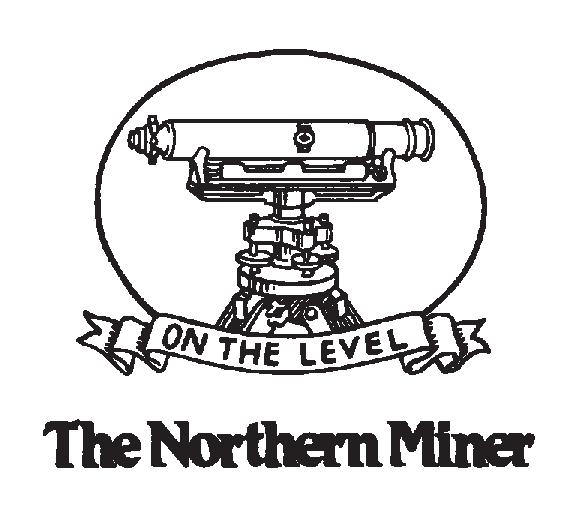
Somehow, cryptocurrencies have competed with the mining sector as both a speculative investment — squeezing out speculative money that might oth erwise be directed to junior miners — and as a store of wealth and inflation hedge, competing with pre cious metals.
BY ALISHA HIYATEWhile some have called crypto “digital gold,” the limits of that analogy became clear this month.
The first two weeks of November saw the sudden and dramatic collapse of the cryptocurrency exchange only five years after it was founded by 30-year-old wunderkind Sam Bankman-Fried.
Concerns about FTX’s balance sheet were first raised in early Novem ber. Those concerns were validated when a competitor, Binance, came in to buy the company, then cancelled the deal.
“As a result of corporate due diligence, as well as the latest news reports regarding mishandled customer funds and alleged US agency investiga tions, we have decided that we will not pursue the potential acquisition of FTX.com,” Binance said on Nov. 9.
Investors pulled their money out and regulators in the Bahamas — where FTX and Bankman-Fried are based — moved to freeze the compa ny’s assets.
FTX, which was worth US$32 billion in February, filed for bankruptcy protection on Nov. 11. Reports have emerged that FTX transferred at least US$1 billion in clients’ funds (without their knowledge and through a “back door” software program to keep the manoeuvre on the down low) to Alameda Research, a company controlled by Bankman-Fried.
In response to the FTX scandal, total market cap in the crypto sector declined by 11.3% in the first 24 hours to $848 billion, according to Canac cord. Bitcoin, which peaked at US$68,000 in November 2021, was already having a terrible year before the FTX news, dipping below US$19,000 in late September. At press time it was at about US$16,000.
While exactly just what happened with FTX is still being investigated and no charges have yet been laid, analysts at Canaccord Genuity described it in a Nov. 10 report as the “digital currency equivalent of a run on a bank.”
It’s also reminiscent of the biggest black eye to date in mining – the Bre-X Minerals fraud of the 1990s.
While Bre-X was just one company, investors worldwide lost some $3 billion in the scam. It also destroyed confidence in the mining sector and led both regulators and the industry to cooperate on creating new stan dards to protect investors.
The crypto space is subject to fraud and theft: the U.S. Federal Trade Commission estimates that U.S. investors lost US$1B in crypto scams last year.
It’s safe to say that the FTX fiasco is likely to bring more regulation –finally — to the crypto space.

‘Hands-off’
Before its fall, FTX was considered a leading exchange in the crypto indus try — and above-board enough to attract risk-averse funds such as the Ontario Teachers Pension Plan, which has now written off its $95 million investment in FTX. (Notably, in August, Caisse de depot et placement du Quebec wrote off a US$150-million investment in Celsius Network — a cryptocurrency lending company that filed for bankruptcy protection in July.)
In a Nov. 17 video titled “Cryptos are not precious — gold and silver are,” Jeffrey Christian, managing director of New York-based commodi ties research and consulting firm CMP Group, predicted further trouble for crypto investors.
“Private cryptocurrencies are likely to disappear, and they’re going to likely disappear in ugly fashion that’s going to cost investors a lot of money,” he said.
Christian noted that regulators have mostly taken a “hands-off” approach to crypto since it first emerged in 2009.
While they believed there would be big losses in this unregulated mar ket, they didn’t want to be the catalyst for such a collapse by stepping in to regulate.
However, that’s starting to change now with fears of financial contagion becoming a real concern as the crypto market has grown to around US$3 trillion from US$500 billion over the past few years.
In the meantime, Christian predicts that the FTX mess could spark a bit of a revival for precious metals, which have mostly languished this year as central banks continue to jack up interest rates.
“In the long run, our view is that cryptocurrencies will implode — there’ll be bigger issues, there’ll be more thefts… Larger investors will lose more money and that will refocus investors’ attention on the values of owning some gold and silver – real tangible assets that are the antithesis of cryptocurrencies.” TNM
One-hundred years ago a five-year search culminat ed in arguably the world’s greatest ever exploration suc cess. No, not a mineral deposit (although lots of gold was found), rather the almost intact tomb of an Egyptian pharaoh.
The ancient burial site in the Valley of the Kings outside Luxor (formerly Thebes) had been widely assumed to be fully explored, and it was only the persistence of a 48-year-old British archaeologist, Howard Carter (1874-1939), that exposed the entrance to the val ley’s 62nd royal tomb.
The burial site was, of course, that of Tutankhamun (1341-1323 BC). Although the first step lead ing to his tomb’s entrance portal was found on Nov. 4, the outer door was only breached 20 days later (awaiting the arrival from Great Britain of the explora tion sponsor Lord Carnarvon). Famously, after a further two days, Carter made a small hole in the inner, tomb door (on Nov. 26, 1922) and, on being asked what he saw, said “wonderful things.”
These wonderful things were fashioned from local gold, with Egypt being a major producer of precious metals for over 2,000 years. In addition to vast mineral resources in the Eastern Desert, the pharaohs had access to the riches of Nubia (a region stretching south from Aswan in Egypt to the conflu ence of the Blue and White Niles at Khartoum in Sudan).
Gold mining (initially from alluvial deposits) on these Pre cambrian rocks of the Arabi an-Nubian shield dates back to almost 2500 BC, and some 250 ancient gold mines have been identified (including sites at Abu Marawat, Abu Zawal, Barramiya, Sir Bakis and Wadi Hammamat in the Eastern Desert). Current gold mines in the area include the Sukari open-pit operation.
The 100th anniversary of the discovery of Tutankhamun’s tomb reminds us of the need in explora tion for finance, expertise and per severance, and of the significant rewards for success.
The need for success in min eral exploration was high lighted recently by analysis from S&P Global Market Intelligence (SPGMI), as reported in The North ern Miner. The report, ‘The Big Pic ture: Metals and Mining, notes that global efforts to decarbonize are driving the rollout of metals-inten sive technologies, bringing about near-term challenges in the com
modities sector. SPGMI analysts say that increasing consumption will “outstrip the mining industry’s ability to ramp up supply, result ing in commodity deficits as early as 2024.”
SPGMI also expects deteriorat ing global macroeconomic con ditions to persist into early 2023, representing a downside risk to the metals and mining sector. Producers will be hit by “narrow ing margins,” while “exploration activity next year will slow amid tighter financing conditions.”
While SPGMI sees a bumpy road ahead, the International Energy Agency reports that to meet the goals of the Paris Agreement, sectors contributing to the green energy transition will be responsi ble for over 45% of the total copper demand, 61% of the nickel demand, 69% of the cobalt demand, and a staggering 92% of lithium demand by 2040. This dramatic increase in consumption poses a massive chal lenge for miners. Although explo ration expenditure is expected to decline next year, SPGMI has reported that commercial explora tion budgets for non-ferrous met als are 16% higher this year than in 2021, at US$13 billion. This is based on SPGMI’s survey of 2,200 companies with a published explo ration budget of over US$100,000 and follows a 35% exploration hike last year.
Gold accounts for over 53% of this year’s exploration spending, with copper accounting for nearly 22%. Regionally, Canada (21%), Australia (18%) and the U.S. (12%) account for the lion’s share, with Latin America attracting 25% and Africa only 10%.
The total is still well short of the almost US$21 billion spent on exploration in 2012, and there are 300 fewer companies with significant exploration bud gets. Worryingly, the industry is also increasingly risk averse, with grassroots exploration account ing for only 25% of the total, com pared with a 50% share at the turn of the millennium. In contrast, the spending proportion for mine site exploration remains near an alltime high of 38%, compared with a share of barely 20% only 22 years ago.
Carter’s search was focussed on a single brownfield site, but the Pharaohs explored across the Arabian-Nubian shield. Modern explorers could do worse than emulate their ancient efforts. TNM
—Dr. Chris Hinde is a mining engineer and the director of Pick and Pen Ltd., a U.K.-based consulting firm. He previously worked for S&P Global Market Intelligence’s Metals and Mining division.
| Exploration lessons from the pharaohs
Canadian battery mineral miners and explorers are sniffing around hundreds of millions of dollars in potential funding from the United States military, but there are no firm deals yet to take advantage of an alliance dating back to the Second World War.
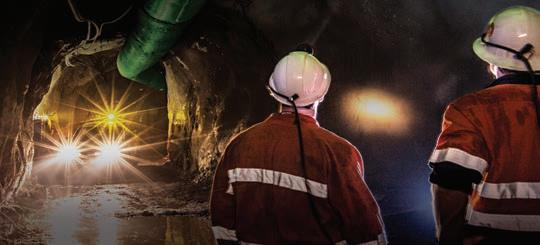
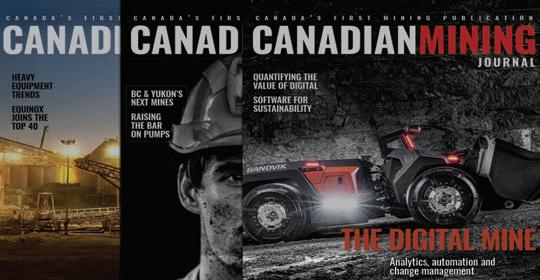
The concept of the U.S. funding projects in Canada to help side step China’s control over lithium and rare earth element (REE) pro cessing broke into the open this month at a conference in Wash ington, D.C. However, some com panies say they’ve been aware of the initiative for years.
“Canada is a resource-based economy, whereas the U.S. is a manufacturing-based economy,” Christopher Grove, president of Commerce Resources (TSXV: CCE), which operates the Ashram REE project in northern Quebec, said by email. “This should be a perfect marriage.”
There appears to be a new urgency under the Biden admin istration as it says it faces loom ing national security threats from China due to the geopolitical lever age Beijing has in its control of most global critical minerals mar kets. Those minerals are needed for green energy and the wider econ omy. In March, the administration used the 1950 Defense Produc tion Act (DPA) Title III to give the Department of Defense increased powers to help miners and explor ers secure supplies of battery min erals such as lithium, nickel, cobalt, graphite and manganese. They’re also seeking REEs used in much modern technology, from weap ons to mobile phones.
The DPA has US$750 million to fund projects after measures approved in a law passed in August for tax breaks on electric vehi cles made in North America, and from a provision in a Ukraine aid package in May, Lieutenant-Com mander Tim Gorman, a spokes man for the Secretary of Defense, said in an email on Nov. 16.
The Ukraine assistance ties into the concerns about Russian control over resources like natu ral gas supplies for Europe, and how China supplies up to 80% of critical metals to the global mar ket, according to analysts’ esti mates. They forecast the demand for critical minerals needed for the global transition to clean energy will expand massively. The cost is
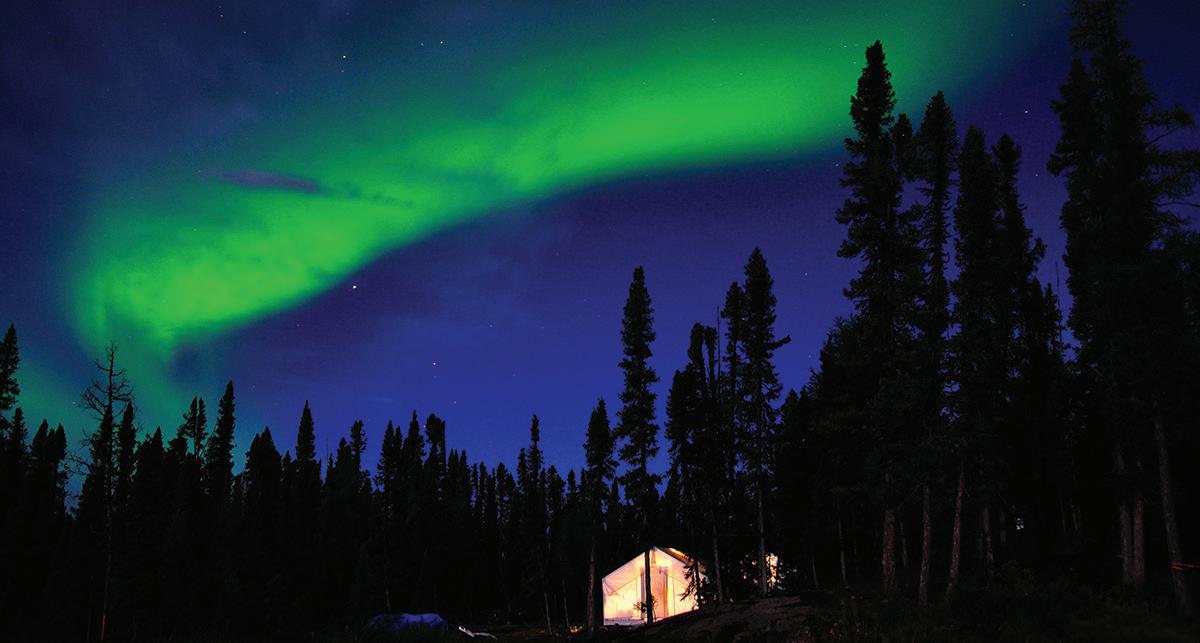
measured in trillions of dollars.
Canada’s federal Natural Resources ministry gave the DPA a list of 70 projects in Canada that might be suitable for fund ing. Ontario added several projects to the list, including Ring of Fire Metals’ (TSXV: ROF) Eagle’s Nest project, located 540 km northeast of Thunder Bay, a spokesperson for the provincial mines ministry said.
Luca Giacovazzi, chief execu tive officer of Ring of Fire parent Wyloo Metals, says it has had ini tial talks with the U.S. Department of Defense, but not about dollar amounts.
Eagle’s Nest is the “best undevel oped high-grade nickel project in Canada,” Giacovazzi said by email.
“We’re already studying options to build Ontario’s only battery nickel sulphate plant,” Giacovazzi said. “Our chrome projects are also very interesting as the only source in the Western Hemisphere that’s large scale and very high quality.”
Still, Canadian resources in bat tery and critical minerals are low by global comparisons. Canada has less than 3% of world cobalt reserves while the Democratic Republic of the Congo has nearly half; Canada has 2.5% of man ganese reserves compared with South Africa’s 43%, according to the U.S. Geological Survey.
Commerce Resources applied for funding under the DPA Title III program a few years ago, but has “seen little so far stemming from it of any substance,” Grove said.
The DPA hasn’t awarded any funds yet, but could fast-track some projects to decisions in a month if they meet an “urgent and compelling need” after filing a detailed submission, Lt.-Cmdr. Gorman said. Unfortunately, only 1% of filings so far come close to meeting criteria, he said.
The criteria concern how the project expands the industrial base and output of critical mate rials for emerging technologies and national defence; a techni cal description of the proposed work; bios of key personnel; and rough cost estimates, Gor man said. The program may ask some companies to submit tech nical and cost reports in a process that takes six to nine months for approval, he said.
Ottawa took steps this month to protect its critical minerals indus try from Chinese control, barring foreign companies from investing
in three Canadian projects. They involve lithium, cesium and tan talum.
Canada announced a nearly $3.8-billion critical minerals strat egy in April to develop the indus try. In June, the U.S. and Canada joined with other major Western economies in a Minerals Security Partnership to catalyze industry investment.
But cross-border funding of mining projects in Canada stretch es back decades to defence coop eration agreements during World War II. They helped develop Que bec’s aluminum industry and com panies such as Alcan.
After the war, the U.S. deemed Canada and other Western allies such as the United Kingdom and Australia as part of its National Technology and Industrial Base for defence and commercial indus try development. The designation opens projects in those countries to funding from the U.S. Depart ment of Defense.
Matthew Zolnowski, a portfo lio manager for DPA, told a Nov. 10 conference in Washington the current program is in its early stages but that it’s engaging Cana dian companies.
Commerce’s Grove says he’s known Zolnowski for a decade and been aware of the DPA pro gram for years.

“This specific initiative has had a lot of life breathed into it by the current administration,” Grove said. “We are very familiar with the process to apply for this capital.”
A spokesperson for Natu ral Resources Canada said staff couldn’t immediately reply to requests for comment.
The Ontario projects on the Natural Resources list to the U.S. are Rock Tech Lithium’s (TSXV: RCK) Georgia Lake, Ava lon Advanced Materials’ (TSX: AVL) Separation Rapids, Fron tier Lithium’s (TSXV: FL) PAK, Zentek’s (TSXV: ZEN; NASDAQ: ZTEK) Albany, Northern Graph ite’s (TSXV: NGC) Bissett Creek, Canada Nickel’s (TSXV: CNC) Crawford and Electra Battery Materials’ (TSXV: ELBM) First Cobalt refinery.
Ontario added Wyloo’s Eagles Nest, Generation Mining’s (TSX: GENM) Marathon, Clean Air Metals’ (TSXV: AIR) Thunder Bay North, Magna Mining’s (TSXV: NICU) Shakespeare, KGHM Inter national’s Victoria, and Green Technology Metals’ (ASX: GT1) Seymour. TNM
QUEBEC | Junior has completed nearly 40,000 metres of drilling in 2022 at past-producer
BY COLIN MCCLELLANDDoré Copper Mining (TSXV: DCMC; US-OTC: DRCMF) has finished drilling almost 40,000 metres this year at its Corner Bay copper project in Quebec, work that will help it expand the resource as it aims to complete a feasibility study in 2024.
The Corner Bay project is located about 500 km northwest of Quebec City.
Drilling highlights from the last dozen holes included 5.1 metres of 5.68% copper, 0.32 gram gold and 18.3 grams silver per tonne, and 510 parts per million molybde num in drill hole CB-22-86; and 2.6 metres of 3.69% copper, 10.3 grams silver per tonne and 414 parts per million molybdenum in drill hole CB-22-83.
“The results confirm the conti nuity of the copper mineralization in the deposit,” Ernest Mast, Doré Copper president and chief exec utive officer, said in the release. “We have also identified a num ber of holes from 2004 with highgrade copper mineralization in the upper portion of the deposit that were not incorporated in the min eral resource.”
The company intends to continue infill drilling at the site in 2023 fol lowing exploration drilling at the nearby Doré Ramp and Joe Mann projects, Mast said. There is also about 2,000 metres in infill drilling planned at the Devlin project in next year’s first quarter. Completing the feasibility study in 2024 depends on improved market conditions and additional funding, he said.
Doré wants to be Quebec’s next copper producer. Prices were at record highs earlier this year, but demand for copper is expected to be sustained for years during the global transition to green energy to fight climate change.
After reviewing drilling required for the feasibility study, Doré iden tified nine holes from 2004 that were excluded from the current mineral resource estimate. All holes intersected copper mineralization at a shallow depth in the two sub parallel veins above the dyke, the company said.
Significant high-grade inter cepts from those holes included 7.1 metres grading 10.09% copper and 0.61 gram gold per tonne in hole CB-04-13; and 13 metres grading 3.23% copper and 0.38 gram gold per tonne in hole CB-04-15.
The company envisions the Cor ner Bay project as a hub-and-spoke operation, with Corner Bay as the main feed for Doré’s centralized Copper Rand mill, supplemented by the Devlin and Joe Mann deposits.
Corner Bay, located on the south flank of the Lac Doré Com plex, was discovered in the early 1980s. A ramp running 115 metres underground was built in 2008 by Campbell Resources, but there was no production besides a devel opment sample of 36,000 tonnes. Doré began drilling in 2017 and has expanded the deposit along strike and down plunge, it said.
The site holds an indicated resource of 2.7 million tonnes grad ing 2.66% copper and 0.26 gram gold per tonne for contained metal of 157 million lb. copper and 22,000 oz. gold, according to a preliminary economic assessment released in May.
The inferred resource from the same study showed 5.9 million tonnes grading 3.43% copper and 0.27 gram gold per tonne for con tained metal of 443 million lb. cop per and 51,000 oz. gold, based on a cut-off grade of 1.3% copper and a copper price of US$3.75 per pound.
While the drilling results con firm continuity of copper mineral ization for the site’s Main Vein that straddles a dyke, they also defined the presence and continuity of a second vein located 50 metres east of the Main Vein above the dyke, the company said in a news release on Nov. 22. Mineralization in this area appears to be parallel and con trolled by mafic dykes, interpreted as originating from the Chibou gamau Pluton, Doré said. The Cor ner Bay camp is about 40 km by road from Chibougamau, Que.
Second vein intercepts included 2 metres grading 3.34% copper, 0.56 gram gold and 15.6 grams sil ver per tonne in hole CB-21-53; and 0.6 metre grading 0.9% copper in hole CB-21-58.
TNM
RESHORING
Cross-border funding of mining projects dates back to Second World WarCommerce Resources’ Ashram rare earths exploration camp in northern Quebec. COMMERCE RESOURCES
Increasing consumption will out strip the mining industry’s ability to ramp up supply, resulting in commodity deficits as early as 2024, a new analysis by S&P Global has found.
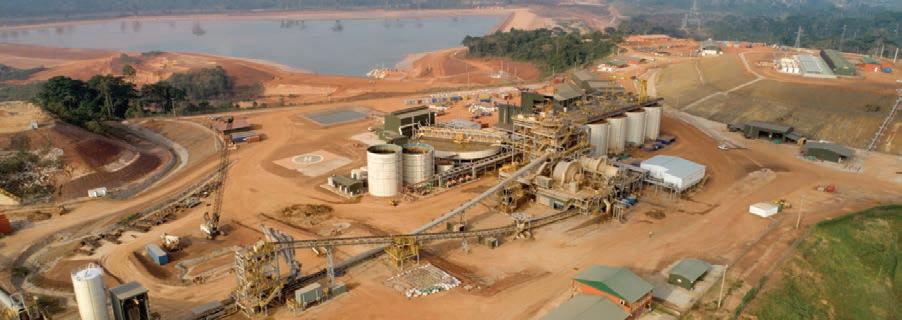
The report, ‘The big picture: Metals and Mining,’ says that global efforts to decarbonize are driving the rollout of metals-inten sive technologies, bringing about near-term challenges in the com modities sector.
On the battery metals side, gov ernment incentives and policy mandates will boost sales of pas senger plug-in electric vehicles by a 28.1% CAGR (compound annual growth rate) from 2021 through 2026. Battery component supply pipelines will struggle to keep up with such a sharp rise in demand.
“Our assessment of develop ing lithium assets foretells healthy growth in 2023, but a failure to meet demand expectations as early as 2024,” Mark Ferguson, S&P direc tor, wrote in the report released on Nov. 9.
According to Ferguson, cobalt faces similar challenges. Although output is forecast to rise into 2024, mainly from the Democratic Republic of the Congo, the metal is forecast to slip into a deficit start ing in 2025. Similarly, the antici pated growth in Indonesian pri mary nickel supply into 2025 will postpone a deficit until 2026, when battery-related demand for nickel is forecast to hit 17.6% of all nickel demand — up from 7.1% in 2021.
S&P expects deteriorating global macroeconomic conditions to per sist into early 2023, representing a downside risk to the metals and mining sector as many commod ity prices slide and equity markets weaken. Producers will be hit by narrowing margins, while explora tion activity will slow amid tighter financing conditions.
As the year progresses, analysts expect improving conditions once central banks gain the upper hand on inflation.
According to S&P, lower activ ity levels in the second half of 2022 and through 2023 will reinforce the metals and mining industry’s importance in the global energy transition.
Supply constraints across com modities deemed critical to the
effort are forecast to emerge as early as 2024, with demand expanding markedly on rising EV sales, the shift towards renewable energy technologies, and related transmis sion and distribution requirements.
As government policies increas ingly focus on meeting critical mate rials requirements through domes tic and regional supply chains, the mining sector should see additional support for developing projects in the near-to-medium term. Prices are expected to remain relatively high through 2026 compared with pre-pandemic levels.
Near-term headwinds
Macroeconomic events have dom inated commodities markets for most of 2022. With the increasing threat of a global recession, they
Endeavour Mining (TSX: EDV; LSE: EDV) said on Nov. 21 it had made a major greenfield gold discovery in Côte d’Ivoire, which has the poten tial to become a new flagship asset for the company.
The miner, which has several gold operations and projects in West Africa, has outlined a hefty initial resource at the Assafou target on its 100%-owned Tanda-Iguela property.
Indicated resources for Assafou sit at 14.9 million tonnes, at 2.33 grams gold per tonne for 1.1 million ounces. A further 32.9 million inferred tonnes grad ing 1.8 grams gold for 1.9 million oz. of gold.
“It ranks as one of the most significant discoveries made in West Africa over the last decade and shows potential to be another flagship asset for the com pany,” chief executive Sébastien de Montessus said in
a news release.
The site has a low discovery cost of less than US$10 for every indicated ounce of gold discovered and pre liminary tests show high gold recovery rates exceed ing 95%, he noted.
The company said the new discovery and explo ration success across its portfolio helps it to stay on track to achieve a discovering target of between 15 to 20 million oz. for the five-year period ending in 2025.
The announcement comes only a month after it announced the beginning of construction at its 2.7-mil lion-oz. Lafigué project, also in Côte d’Ivoire.
Endeavour has a large footprint in Burkina Faso, where it has been subject to a number of terrorist attacks in the past three years.
This year, the company expects to churn out between 1.3 million and 1.4 million oz. of gold at all-in sustaining costs of US$880 to US$930 per ounce.
are likely to weigh on fundamentals again in 2023, says associate analyst Aude Marjolin in the report.
In addition to the challenges of multi decade-high inflation driven by supply chain issues arising from the Covid-19 pandemic, the major economies have been grappling with other concerns that are not expected to ease into 2023.

Electric vehicle production has recently been one of the affected industries, tempering demand for battery metals such as nickel, cobalt and lithium despite the global push for electrification of the mobility sector.
“Governments have nevertheless been deploying efforts to secure local supply chains for these crit ical materials through legislation, although the resulting supply and demand trends will not materi alize in the short term,” Marjolin notes. “Instead, macroeconomic headwinds from energy inflation, raw material costs and parts short ages are expected to impact auto production and battery metals demand.”
Meanwhile, disrupted property markets have hampered copper and iron ore demand. Real estate data for the U.S. shows a downward trend in new construction and the potential for a general downturn in the hous ing market. In China, despite vari ous infrastructure grants from the government and a resumption of projects by developer China Ever grande, a lacklustre peak construc tion season, along with the ongo ing zero-Covid policy, is expected to limit any uptick in demand and prices in the first half of 2023.
With capital costs increasing, even renewable energy resource buildouts will be affected, further impacting steel and copper con sumption.
Despite muted demand in 2023, inflation is expected to pressure the metals markets. “We forecast 2023 prices to average lower than 2022 across the industrial commodities, with a year-over-year drop ranging from 7% for copper to 33% for lith ium,” Marjolin wrote.
The analyst also sees muted mergers and acquisitions activity in 2023. “The souring macroeco nomic environment and result ing market volatility will likely make for cautious buyers in 2023, although these same factors may expand the pool of assets available for purchase.”
Further, governments have begun implementing sourcing requirements, especially for bat tery metals, against the geopoliti cal backdrop of the Russia-Ukraine conflict, which has exposed supply chain issues and dependence on foreign sources of critical minerals. This may spur a different trend in M&A activity, focused on domestic industry consolidation and compa nies buying out small operations to
enter the playing field and capital ize on demand.
Meanwhile, data points to access to capital becoming even more constrained in 2023. S&P principal analyst Kevin Murphy points out financing raised by junior and inter mediate explorers totalled US$8.4 billion through August, down sig nificantly from the US$14.6 billion raised in 2021.
“Should this trend continue through the remainder of 2022 and into the first few months of 2023, we expect a 10-20% decrease in the global exploration budget for 2023,” Murphy said.
The decrease will not be felt evenly, however. Gold budgets should decrease more than energy transition metals copper, nickel and lithium.
While S&P sees a bumpy road ahead, the International Energy Agency data shows that to meet the goals of the Paris Agreement, sectors contributing to the green energy transition will be responsi ble for over 45% of the total copper demand, 61% of the nickel demand, 69% of the cobalt demand, and a staggering 92% of lithium demand by 2040.
Such a dramatic increase from 8-29% at the end of the last decade poses a massive challenge for the market’s supply side.
The IEA predicts that between 2020 and 2040, global demand for all energy transition minerals will need to quadruple from 7.1 mil lion tonnes to 27.4 million tonnes to meet the Paris Agreement goals. Under a more ambitious scenario of reaching net zero by 2050, demand for all energy transition minerals would increase sixfold to 43.1 mil lion tonnes by 2030 — including lithium, cobalt, nickel, manganese and graphite, which are crucial for widely used high-performance lith ium-ion batteries.
S&P estimates that, on average, it takes 17 years to progress a cop per mine from discovery to the first production — a timeframe that will most likely increase in the com ing years due to mounting project development barriers.
These include historically poor capital allocation and increasingly stringent ESG requirements, accord ing to Wood Mackenzie, which present challenges to the growth of copper mine projects. At the same time, it is currently estimated that the world would require an addi tional 500,000 tonnes of new copper supply annually for 20 years. This is roughly equivalent to building a new Escondida — the world’s larg est copper mine — every two years. By 2030, electric vehicles alone will require 1.6 million tonnes of copper, according to the IEA.
Meanwhile, signs are apparent that copper supplies are getting thin. At present, visible exchange inventories, including Shang hai bonded copper stocks, have recently slumped to the lowest level on record as of the end of Octo ber. Inventories are down by nearly 50% from a year ago and currently stand at less than a third of the average level observed in the pre ceding five years.
Imported copper cathode premi ums to China hit all-time highs last month. Year-to-date copper mine production in Chile, the world’s largest producer, is down by 7% year-on-year — on track for its fourth consecutive year of contrac tion. TNM
“OUR ASSESSMENT OF DEVELOPING LITHIUM ASSETS FORETELLS HEALTHY GROWTH IN 2023, BUT A FAILURE TO MEET DEMAND EXPECTATIONS AS EARLY AS 2024.”
MARK FERGUSON S&P GLOBAL DIRECTOR
 BY COLIN MCCLELLAND
BY COLIN MCCLELLAND
Our TNM Drill Down features highlights of the top gold assays of the past week. Drill holes are ranked by gold grade x width, as identified by our sister company Mining Intelligence (www.miningintelligence.com).
Results over the length of the Americas led the week. Wes dome Gold Mines (TSX: WDO), at its Kiena mine com plex in Quebec, scored the high est –width x grade result, followed by New Pacific Metals (TSX: NUAG) at its Carangas project in Bolivia and i-80 Gold (TSX: IAU; US-OTC: IAUCF) at Ruby Hill in Nevada.
Drill hole N103-6839W4 at Kiena near Val d’Or, Que., cut 1 metre grading 4,140 grams gold per tonne starting from 260.9 metres deep for a grade x width of 4,140. Hole 6796W6 also returned strong grades over a longer interval with 50.7 metres grading 92.11 grams gold starting from 94 metres.
Hole 6752W10 cut 83.2 metres grading 13.94 grams gold from 748.9 metres deep, showing new mineralization 100 metres below the known limit of the A zone resource, the company said. It also made a discovery in the south limb of the A zone, a lateral expansion of mineralization identified by multi ple intercepts.
“Discovering additional gold ounces near planned infrastruc ture in our view is a strong way to leverage the exploration potential at Kiena,” BMO


The project has proven and probable reserves of 1.8 million tonnes grading 11.1 grams gold per tonne for 651,000 oz. of contained gold. Based on a prefeasibility study completed in 2021, the project is expected to produce an average of 84,000 oz. gold annually over a mine life of seven years at an all-in sustaining cost of $894 per ounce.
The Kiena mine complex restarted production in May 2021 after declining gold prices and lack of developed reserves forced Wes dome to suspend operations in 2013. From 1981 until that time,
it had produced almost 1.8 million oz. gold.
In second place this week, New Pacific Metals reported 591.85 metres grading 1.03 grams gold per tonne from 176.3 metres in hole DCAr0049 for a grade x width of 609.61 at its Carangas project in the western Bolivian department of Oruro.
The diamond drill hole included higher grade intervals of 14.6 metres grading 2.16 grams gold from 412.1 metres; and 29.1 metres grading 2.76 grams gold from 446.63 metres.
The site is part of an area in the Andes which has seen large cop per-gold
ean side, but little exploration in Bolivia. New Pacific says it wants to publish its first resource estimate for Carangas by the middle of next year. The Canadian company is drilling in the project’s Central Val ley area under a silver zone, Alex Zhang, vice president of explora tion, told The Northern Miner on a recent site visit.
“Once we started drilling, we couldn’t stop because every hole hit a very long intercept of mineraliza tion,” Zhang said.

In third place this week is i-80 Gold, which intercepted 10 metres grading 60.2 grams gold per tonne from 199.4 metres in hole 1RH2255 for a grade x width of 602 at its Ruby Hill project in northern Nevada.
Another Ruby Hill hole cut 18.3 metres grading 1.9 grams gold and 631.3 grams silver per tonne, 33% lead and 7.4% zinc.
The site, part of a gold mining area dating to the 1860s, has indi cated mineral resources for an open pit operation of 220.8 million tonnes grading 0.54 gram gold per tonne for 3.7 million oz. contained gold. TNM
 BY ALISHA HIYATE IN BARTICA, GUYANA
BY ALISHA HIYATE IN BARTICA, GUYANA
On a 35-minute helicopter ride from Guyana’s capital of Georgetown to Reunion Gold’s (TSXV: RGD) Oko West proj ect in the Cuyuni mining district, it’s easy to see where the South Amer ican country got its nickname — the land of many waters. We fly over the Demerara River and the mighty Essequibo River which leads down to Bartica — a town of 20,000 that’s also a gold mining gateway and lies at the confluence of three rivers — Essequibo, Mazaruni and Cuyuni.
The bird’s-eye view also makes it easy to see that Reunion is in the right place to look for gold. As we get closer to the project, 95 km southwest of Georgetown, past and current artisanal mining operations come into view through the dense forest canopy.
Reunion has a long history exploring the 400,000sq.-km Gui ana Shield in Guyana and neigh bouring Suriname and French Guiana dating back to 2012. Its executive chairman David Fen nell has an even longer history in the region going back to the early 1980s. Fennell, a mining vet eran and founder of Golden Star Resources, which built and oper ated the Omai gold mine in Guyana with Cambior in the early 1990s, was also key in the discovery and development of the Gross Rosebel mine in Suriname (recently sold by Iamgold (TSX IMG; NYSE: IAG) to Zijin Mining).
Optioned in 2018, the Oko West claims are newer to Reunion’s port folio. But it didn’t take long before it made a promising discovery that it’s now quickly advancing towards a first resource.
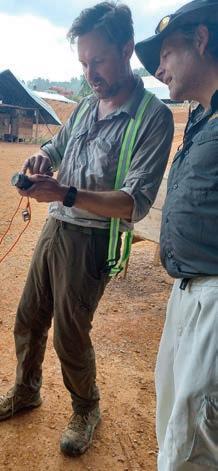
Despite the artisanal workings in the area, the company’s big find at Oko West – the Kairuni zone — was not discovered by small scale miners (although there is evidence of them throughout the concession), but through geochemical testing.
Soil sampling in early 2020 at the project, which is on strike with and adjacent to G2 Goldfields’ (TSXV: GTWO) separate Oko project to the north, outlined a 6-km goldin-soil anomaly while following up on a 2019 airborne magnetic geophysical survey. The discovery was confirmed by trenching in late 2020 that returned highlights of 69 metres of 5.98 grams gold per tonne and 34.5 metres of 5.5 grams gold.
The very first drill hole at the project, part of a preliminary, 1,000-metre drill program in early 2021, cut 9.1 metres of 1.74 grams gold per tonne from surface, fol lowed by 20.1 metres of 1.54 grams gold from 50 metres downhole.
Now, the company’s completing a 28,000-metre-plus diamond drill program, slated to be completed in early 2023, when Reunion plans to release an initial resource for the project. Drilling has so far out lined the Kairuni zone – the north ern 2.5 km of strike of a 6-km shear zone — across up to 100 metres in width and 600 metres depth. Drill ing has returned such positive results, Reunion announced in Sep tember that it would delay the initial resource from the third quarter as originally planned, since it would be “premature.”
At press time on Nov. 21, Reunion revealed that a new, high-profile president and CEO will take over from interim CEO Carlos Bertoni, who is retiring. Rick Howes, former chief execu
tive of Dundee Precious Metals, will join the company as of Jan. 1, 2023. Howes is a mining engineer with nearly 40 years of experience and a track record of overseeing on-schedule and on-budget capital projects and leading mining inno vation.
‘Rapidly evolving’
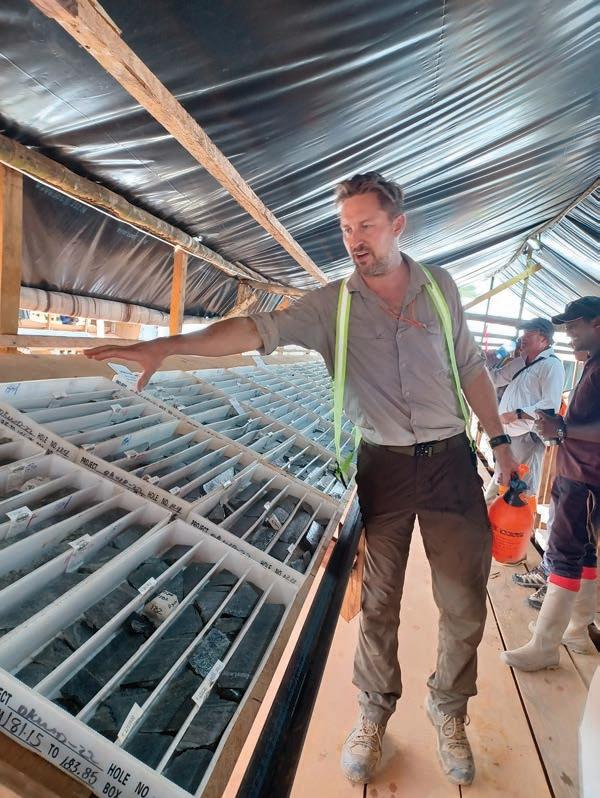

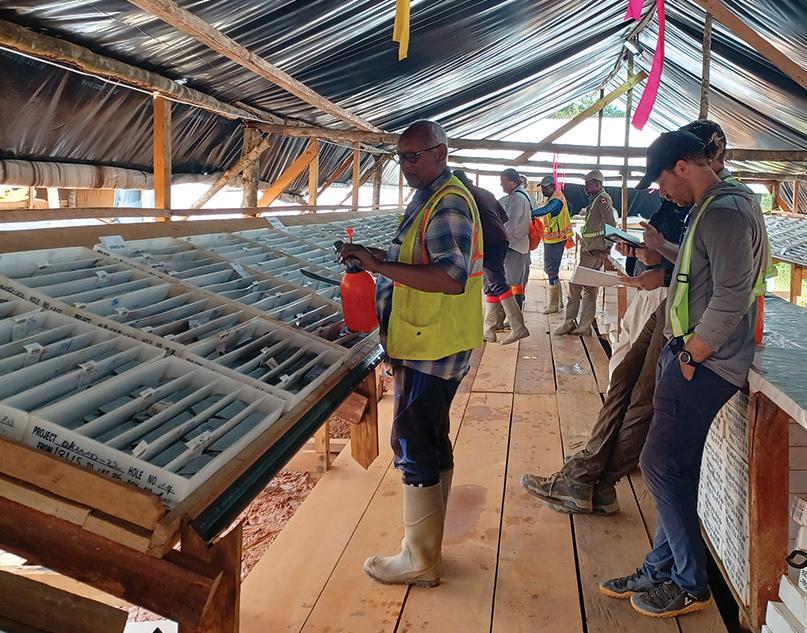
During the site visit in early Novem ber, Reunion Gold’s vice-president of exploration, Justin van der Toorn noted that the project has evolved at rapid pace since the start of the first major drill campaign in June 2021. The camp, which has grown from about 20 people in early 2020 to regularly accommodating up to 90, reflects the ramp-up in activity.
At the time of the visit, the com pany was in the midst of commis sioning a new fuel storage facil ity, building a new workshop, and planning to expand capacity fur ther to 120 people next year.
“It’s a very rapidly evolving camp, and it’s been quite an excit ing period to see the project go from those initial couple of holes to what we now have and the poten tial that we have here,” van der Toorn said.
Reunion had three core rigs turning at the time, with another two just-arrived rigs about to be put to work. Van der Toorn said
the five diamond drill rigs will give the exploration team capacity of about 7,000 metres per month. Having raised $36.8 million in June and $11.5 million in February, the company has around $50 million in its treasury — enough to fund work at that pace through the end of next year.
The company also recently con verted its option agreement with a local permit holder to a prospect ing licence, which is the first step to tenure for a foreign company. (Now that Reunion has the per mit, the last remaining small-scale miner on the concession was just packing up to leave in November.)
The first major drill program at Oko West began in June 2021, with early results that included 43.5 metres of 2.92 grams gold per tonne start ing from surface (hole 13) and 61 metres of 2.54 grams gold from sur face (hole 14).
“We started out looking at more of a shallow system, trying to develop the potential here within the saprolite,” van der Toorn said.
The saprolite layer extends to about 80 to 100 metres, and was untouched by artisanal miners — locally known as pork-knockers.
“We’ve got the entire saprolite profile preserved, which is obvi ously the easy win as a starter pit on these kinds of projects,” van der
Toorn noted.
More recent results reported in September included 52.5 metres of 5.19 grams gold from 4.5 metres depth in hole 135 and 49.8 metres of 4.12 grams gold from 221.7 metres in hole 124.
Though the strongest results have come from the Block 4 area of the Kairuni zone, Reunion has also hit nice grades and widths out side that block, including 37 metres of 2.99 grams gold in RC hole 205 in Block 6 to the south, and 67.6 metres of 1.21 grams gold in dia mond drill hole 166B in Block 1 to the north.
High-grade heart Mineralization at Oko West is hosted in a combination of volca nics and sediments in a north-south shear zone, along at a volcano/sed imentary-granitoid contact. The bulk of the mineralization in the orogenic gold system is in sedimen tary rock rather than granitoids, and shows excellent continuity from top to bottom.
“We do see a strong associa tion with quartz veining,” van der Toorn said. “That said, the majority of our mineralization (is in) brec cias, there’s sheared sediments with fractures well developed across them, and then foliation parallel quartz veins that also host gold,”
he said, adding that the system is complex.
“It’s not like one vein that’s sometimes quite typical in oro genic gold systems, but it’s really a well-developed deformation zone within which you’re then precipi tating gold through various mech anisms.”
The 2.5-km-long Kairuni zone has seen the bulk of drilling, with a 6,000-metre reverse-circulation drill program under way at the 3.5-km-long southern half of the system, dubbed the Takutu zone. There’s also further potential on the 44-sq.-km property in the Carol zone, a potential zone parallel to Kairuni, and the Bryan zone further west, which the company believes could be the hard rock source of downstream alluvial workings.
“Block four (part of the Kairuni zone) has really delivered the heart of the high-grade mineralization, the very thick grades that we’re see ing in that package of sediments,” van der Toorn said.
“We are still trying to under stand more of the geology here. Obviously, the drilling has gone very well and what that leads to is that you generally don’t actually spend much time thinking about the details of why and how it fits
 BY COLIN MCCLELLAND
BY COLIN MCCLELLAND
MATAGAMI, QUE. —
Maple Gold Mines (TSXV: MGM; US-OTC: MGMLF) is in “advanced and detailed” talks with three poten tial acquisitions as it seeks to nearly double its contained gold resources, chief executive officer Matthew Hornor says.
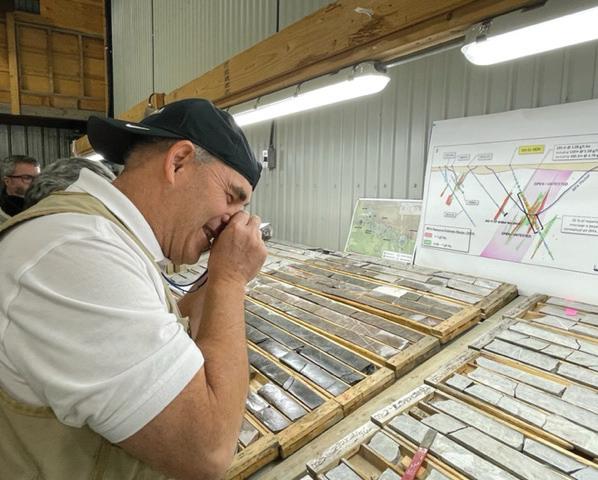
The Vancouver-based explorer wants to lift its total indicated and inferred contained metal resource to more than 5 million oz. gold from about 3 million oz., Hornor said in November at the camp for Maple’s adjacent Douay and Joutel projects, about 700 km northwest of Montreal. All of Douay and more than half of the Joutel property are a 50:50 venture with Agnico Eagle Mines (TSX: AEM; NYSE: AEM) in Quebec’s Abitibi gold belt.
Maple seeks to buy companies in the same region, which spans the Ontario-Quebec border south of James Bay and holds some of Cana da’s largest gold producers, Hornor said in an interview. He declined to name the companies involved in talks because of rules about stock price-moving news.
“It’s got to be something we get at a discount because we have a joint venture partnership and cash,” said Hornor, who used to work for bil lionaire entrepreneur Robert Fried land, the founder of Ivanhoe Mines (TSX: IVN), among other compa nies. “We’re opportunistic in find ing companies who would benefit from aligning with us.”
Maple wants the advantages of a larger resource base and a re-rating of its stock to secure better financ ing for development as it pro gresses through an agreement with Agnico that increases Maple’s share of expenses. It is also keen to buy companies while stock market val uations are relatively low and gold prices are generally high historically.
The Abitibi belt, known for the Canadian Malartic open pit mine run jointly by Agnico Eagle and Yamana Gold (TSX: YRI; NYSE: AUY; LSE: AUY), and Kirkland Lake Gold’s (TSX: KL; NYSE: KL; ASX: KLA) Detour Lake mine, also
hosts many smaller projects that show resources and potential, but would benefit from consolidation, Hornor said. Some may lack fund ing or others may be in a distressed situation, he added.
“Given the challenges in the cap ital markets, talented geologists are often frustrated with the lack of budget to execute projects,” he said. “Our interest is in projects with smart people attached to them so we wouldn’t dilute the focus of our team here.”
Maple has $15.3 million in cash. Its shares were trading at 16¢ apiece in Toronto at press time, valuing the company at $54 million. Ana lysts said the company would likely use some cash and sell shares to pay for the acquisitions.
The explorer’s potential acqui sitions are part of a dual-track strategy to dramatically expand its resources by January 2025. The other track is drilling. The company is adding two rigs this month for a total of five engaged at Douay and drilling as much as 1,800 metres underneath and beside former mines at Eagle and Telbel, which form the Joutel project.
“The fastest way to increase resources is this acquisition plan,” Mark Reichman, an analyst based in St. Louis for Noble Capital Mar kets, who covers Maple and vis ited the site this month, said in an interview. “If they were picking
resources from a company trad ing at a lower enterprise value to resources ratio, it could be positive. But longer term, the real value is going to be determined by the deep drilling program.”
Current indicated resources at Douay and Joutel are 10 million tonnes grading 1.59 grams gold per tonne for 511,000 oz. contained metal, according to an update in March. The inferred total is 76.7 mil lion tonnes grading 1.02 grams gold per tonne for 2.5 million ounces.
This year, Maple bought the underground Eagle mine, Agnico’s first mine which ran from 1974 to 1986, from Globex Mining Enter prises (TSX: GMX) for $2.4 mil lion. It is part of the Joutel project, but not in the joint venture with Agnico.
The rest of Joutel is mostly the Telbel property, which Agnico mined from 1983 to 1993. Telbel and Eagle together produced 1.1 million oz. of gold.
But getting the former mines at Eagle and Telbel into work ing order would require various preparations, such as draining their shafts and tunnels of water which has seeped in over the past 30 years. The company needs to con duct a prefeasibility study to see if the “expensive” process is worth it, CEO Hornor said.
Analysts also said the Harricana River’s proximity to Joutel means
restarting operations will need a water treatment plant that could easily cost tens of millions of dollars.
The 400-sq.-km Douay and Joutel properties straddle strikes along the Casa Berardi and Harricana/Jou tel deformation zones that formed about 2.7 billion years ago. Mul tiple events over succeeding eras, including volcanic activity, intru sions and shearing pushed gold closer to the surface.
Douay has the same sort of scale and geological formations found at Canadian Malartic and Detour, Fred Speidel, vice-president of exploration, said. The 2018 East Gouldie discovery at Canadian Malartic, which extends from 700 metres to 1,900 metres below sur face, is especially interesting, Spe idel said in an interview.
“The importance of that discov ery has had a huge influence on our thinking, in terms of our will ingness to pursue higher risk, but also potentially higher reward deep drilling,” Speidel said.
For winter 2022-23, Maple is seeking new discoveries in areas that haven’t been drilled before in 10,000 metres of drilling at Douay and 6,000 metres at Telbel. At Douay, the leading targets are below 1,000 metres where there has been almost no drilling deeper than 700 metres, he said.
At Joutel, targets are being drilled at depths of 1,400 to 1,800 metres, well below the deepest mine work ings at about 1,200 metres. At Eagle, where both lateral and depth exten sions are being tested, targets are continuing to be drilled at depths of between 200 and 1,300 metres. Eagle mine workings are between 65 and 800 metres deep, he said.
Even if Speidel’s drilling hits discoveries ballooning Maple’s resources, Hornor says his pur chasing plans won’t shrink.
“The acquisitions get even eas ier when we have more ounces because people will be more inter ested in doing a transaction with us because the platform will be stron ger,” the CEO said. “Consolidation in Abitibi should be done and we’re trying to make it happen.”
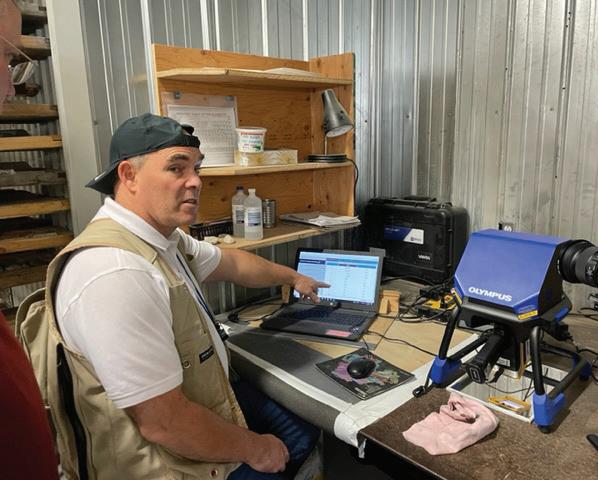
The next resource update for Douay and Joutel may come in 2024 after the current drilling pro gram, barring a large discovery that can significantly alter the resources total on its own, Speidel said.
Highlights so far this year include Eagle mine hole EM-22-005 which cut 7.5 metres grading 4 grams gold per tonne, including 3 metres of 6.4 grams. Hole EM-22-009 returned 3 metres of 11.4 grams gold, includ ing 1 metre at 24.4 grams.
In the 531 zone at Douay last year, drill hole DO-21-316 inter sected 32.2 metres of 1.54 grams gold per tonne from 430 metres downhole, including 6.7 metres of 4.63 grams gold.
Pierre Vaillancourt, a Toron to-based mining analyst with Hay wood Securities who doesn’t cover the company but visited the site, says the joint venture with Agnico shows the major’s confidence in Maple’s team and the potential for new drilling discoveries.
“There’s still a lot of work to be done to pull it all together into a cohesive system, but in the time they’ve been there they’ve made good progress,” Vaillancourt said. “It’s been 30 years since Eagle and Telbel closed, so the timing is right for them to come in and take a fresh approach, especially with a higher gold price. What’s old is new again.”
“CONSOLIDATION IN ABITIBI SHOULD BE DONE AND WE’RE TRYING TO MAKE IT HAPPEN.”
MATTHEW HORNOR, CEO OF MAPLE GOLDThe head frame at Maple Gold Mines’ Douay project. COLIN MCCLELLAND
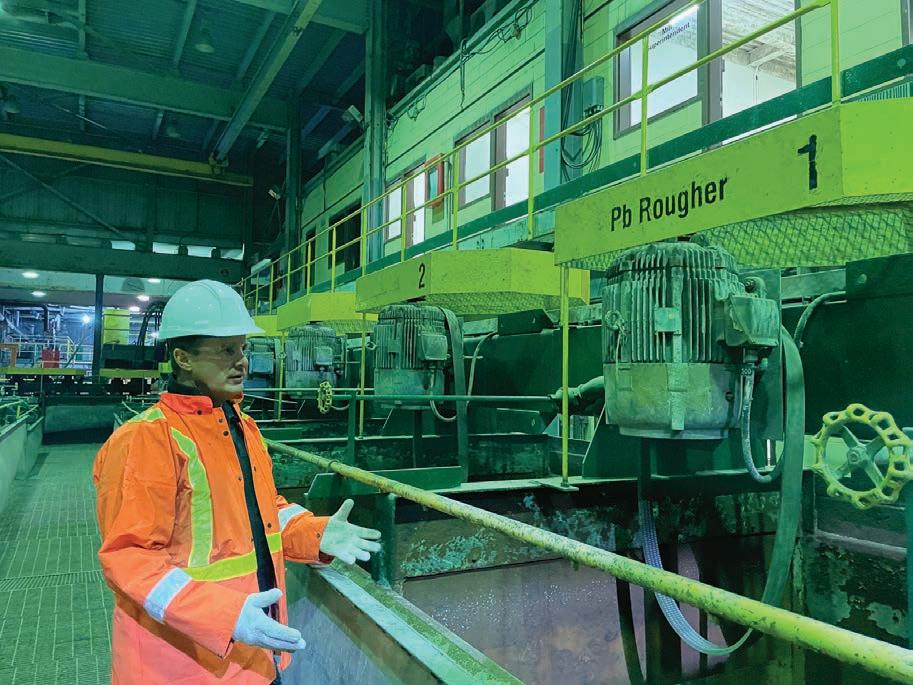 BY COLIN MCCLELLAND IN CARROLLS CORNER, NS
BY COLIN MCCLELLAND IN CARROLLS CORNER, NS
Secretariat won the Triple Crown that year, NASA launched Sky lab and Watergate intensified. It was 1973, the same year Esso Minerals and Cuvier Mines began developing the Gays River under ground zinc and lead project in Nova Scotia, 60 km northeast of Halifax.
The Gays River mill began pro cessing 900 tonnes per day in 1979 before underground flooding ham pered mining for the joint venture and subsequent owners. West ern Mining stopped operations in 1991, and Acadian Mining’s 2007 restart with open-pit operations ended two years later.
Now, EDM Resources (TSXV: EDM) wants to restart open pit mining once again, aiming for the end of next year. To get there, it will need to increase mill capacity to 2,700 from 2,500 tonnes per day at an estimated cost of $30.6 million, according to a November 2021 updated prefeasibility study (PFS). It calls the project Scotia mine.
“When you have this huge mill that’s been built, you have to take advantage of it,” EDM chief exec utive officer Mark Haywood said on a recent tour after running through modernizing plans. “If you line up those things then we can create enormous value for the stakeholders.”
The prefeasibility study outlined a 14.3-year mine life producing a total of about 445 million lb. zinc and 288 million lb. lead in concen trates, or 35 million lb. zinc and and 15 million lb. zinc in concen trate per year. All-in sustaining costs are projected at US52¢ per lb. zinc-equivalent. Total operating costs were forecast to run to $52.56 per tonne milled.
The study used base case metal prices of US$1.22 per lb. zinc and US$1.04 per lb. lead, and estimated the project would deliver an aftertax net present value of $128 mil lion at a discount rate of 8% and an internal rate of return of 65%.
Haywood, a veteran mining engineer who has worked at BHP’s (NYSE: BHP; LSE: BHP; ASX: BHP) Morinbah North coal mine, and for Gold Fields (NYSE: GFI) in Ghana and Iamgold (TSX: IMG; NYSE: IAG) in Burkina Faso, said he’s trying to counter inflationary pressures in diesel, reagents and wages by securing better deals on equipment in the mill and the pit.
Haywood’s reopening plan includes
more ore crushing outside the mill building to achieve proper ore size with less waste material and dust entering the mill. He plans to replace a re-grinder with a second ball mill, improve the conventional flotation circuit with automation and replace a kiln dewatering process with a fil ter press method. EDM will stream line the loading of zinc and lead into sealed shipping containers instead of open dump trucks.
The plant needs a new trans former and 4-megawatt natural gas backup generators, and the com pany is considering the installa tion of solar and wind power on the 6.6-sq.-km site, Haywood said.

The project has proven and prob able reserves of 13.7 million tonnes grading 2.03% zinc and 1.1% lead for 35 million lb. of contained zinc and 15 million lb. of contained lead.
Taylor Combaluzier, an analyst
with Toronto-based Red Cloud Securities, doesn’t cover the com pany, but has it on his watchlist after visiting the site in October.
“The recently completed and significantly improved mineral resource estimate and updated PFS, the large amount of infrastructure already in place and resultant mod est capex requirements, along with its recent debt financing to get the Scotia Mine into production should warrant attention from investors,” Combaluzier said in an email.
“With several zinc-lead mines coming offline and meager mine supply growth projected in the coming years, the restart of the Scotia Mine could potentially help meet the demand for those com modities.”
EDM updated the resource in December 2019, increasing the measured and indicated ton nage by 105% and the inferred by 7%. The measured and indicated resource now stands at 25.5 mil lion tonnes grading 1.89% zinc and 0.99% lead (2.84% zinc-equivalent) and the inferred resource at 5 mil lion tonnes grading 1.5% zinc and 0.66% lead (2.13% zinc-equivalent).
In March 2021, the company updated the resource estimate to include a gypsum resource for the first time of 5.2 million measured and indicated tonnes grading 91.8% gypsum and 790,000 inferred tonnes grading 91.2% gypsum.
In June, Geneva-based metals trader IXM, a unit of China’s CMOC Group, signed agreements to loan US$24 million to EDM for the proj ect and to buy all the project’s zinc and lead production for the first 10 years.
Other investors include Fan Camp Exploration (TSXV: FNC), an explorer with projects across Ontario and Quebec, which holds about 14% of EDM. Board mem bers and management hold some 30%, according to the company.
EDM is betting its zinc price forecast of as much as US$1.40 per lb. in the next two years and limited costs to restart the past producing mine will mean wide margins. (At press time zinc was US$1.38 per lb. and lead US$1 per pound.)
At the site, Jason Baker, who joined EDM in 2019 as mine man ager, stood overlooking the open pit filled with about 50 metres of water and described how stripping back the overburden will start by the third quarter of 2023 after the delivery of heavy earth-moving machinery. The company is await ing a final permit for sediment and erosion control, which Baker expects to receive within a month.
“There was always the stigma of flooding here with the under ground mine,” said Baker, a local who started his career more than 20 years ago in the coal mines of Penn
sylvania. “Open pit mining is less of a challenge with water.”
EDM plans to install perimeter wells to monitor and drain water from the pit — if needed — where there were none before. They’ll be inside the ring of birch trees around the property that contains the Mis sissippi Valley-type lead-zinc deposit. The orebody is in dolo mitized limestone that developed on an irregular pre-Carboniferous basement topographic high where coral reefs grew 300 million years ago. The strike runs some 4 km and the deposit extends to about 120 metres depth.
However, Acadian’s open-pit oper ation suffered a combination of problems before it was put on care and maintenance in 2009, said Baker, who worked for the now-de funct company at the time.
The financial crisis knocked met als prices lower while inadequate power supplies and poor crushing jammed the mill and raised operat ing costs, he said. The company also over-handled the ore and product with multiple dumping and haul ing steps instead of a more seamless process, he said.
“Acadian was trying to push too much ore — like 3,000 tonnes a day — through the mill,” Baker said. “They wanted to increase produc tion because the zinc price was fall ing but they didn’t have the power and the proper crushing so there were a lot of outages.”
Selwyn Resources bought the project in 2011 for $10 million, minus $2.5 million for an environ mental bond. Then Selwyn changed its management and name in 2019 to EDM Resources.
EDM shares had fallen 4% this month to 48¢ per share in Toronto at press time within a 52-week trad ing range of 75¢ and 44¢, valuing the company at $9.6 million.
“We’re trading at 10% of our net asset value, which is a significant opportunity for investors,” Hay wood said.
The year the project first began on the site, 1973, was also when the Montreal Canadiens defeated the Chicago Blackhawks for the Stan ley Cup. Haywood, a transplanted Australian, is a Canadiens fan.
“The Habs will be trying hard for the Stanley Cup in 2023,” he said. “EDM will also be pushing the game-changing start of commercial production
the Scotia mine.”
Vancouver-based Cypress Development (TSXV: CYP) says it has successfully tested the world’s first hydrochloric acid process to extract battery-grade lith ium carbonate from clay at its halfa-billion-dollar project in Nevada.
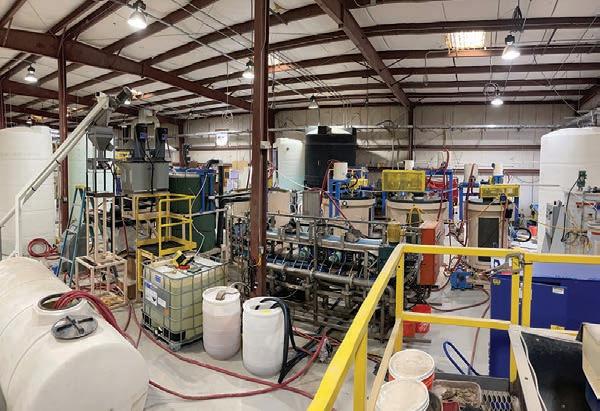
The Clayton Valley lithium proj ect, about 270 km northwest of Las Vegas is producing lithium car bonate at a 99.94% purity level, Cypress chief executive officer Bill Willoughby said in an interview in October. That purity exceeds bat tery grade which is 99.5%.
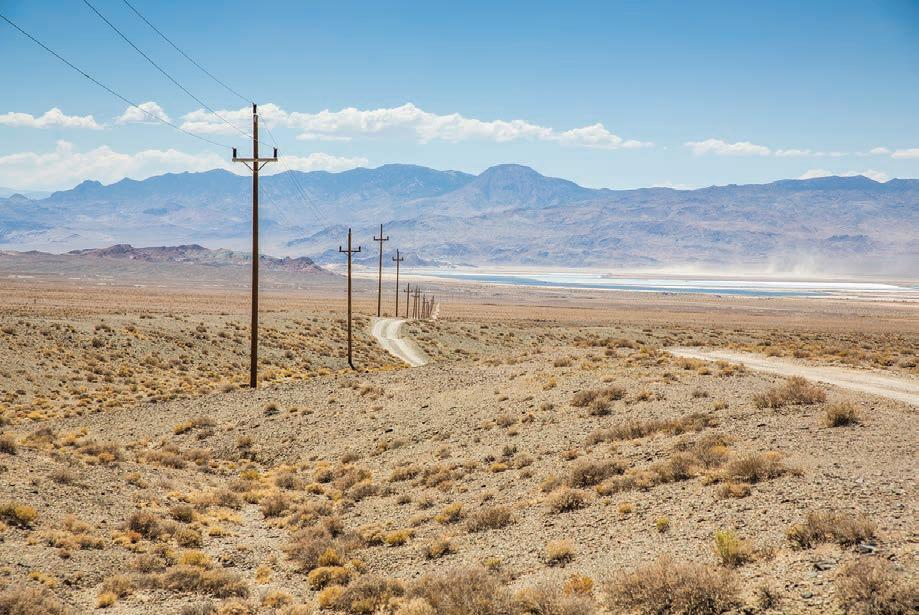
“What we want to do with clay is go all the way from ore in the ground to the finished product at the site and not have to look to any post-processing or refining to be able to finish it,” Willoughby said by phone from Twin Falls, ID. “That’s why the press release on the purity is important. It shows we can get to battery-grade on site at the mine.”
Mining companies are scram bling to meet demand for minerals such as lithium, cobalt, nickel and graphite used in electric vehicle batteries as fossil fuels are retired in transportation and for other power uses in favour of renewable energy.
Governments in various jurisdic tions are offering tax incentives to switch while ramping up laws to cut greenhouse gas emissions affecting the climate.
Traditionally, lithium carbon ate has been extracted from evap oration ponds after being pumped from brine reservoirs under salt flats, or mined from ore such as spodumene. Mining clay was con sidered too expensive, but miners have cut costs by using leaching, which is markedly faster than the brine evaporation route that can take months or years.

Hydrochloric acid is com monly used in mining operations such as tungsten, uranium, zirco nium, potash and rare earth ores for extraction, separation, purifica tion and water treatment, Cypress noted. Its process will apply acid leaching to lithium clay in a con ventional agitated tank followed by the production of lithium car bonate from concentrated lithium chloride solution.
There are several other projects in Nevada aiming to extract lith ium from clay for electric vehicle batteries.

Lithium Americas (TSX: LAC; NYSE: LAC) has secured most of its permits and is preparing a fea sibility study for its Thacker Pass project. Ioneer (ASX: INR) is advancing the Rhyolite Ridge proj ect, Noram Lithium (TSXV: NRM) is working on the Zeus lithium project and Spearmint Resources (CSE: SPMT) has the Green Clay and McGee Lithium Clay projects.
Hydrochloric acid vs sulphuric acid
But only Cypress is choosing the hydrochloric acid leaching process instead of the generally less expen sive sulphuric acid method. Koch Industries, which posted 2020 rev
enues of US$115 billion, in June bought the process Cypress is using from Pickering, Ont.-based Che mionex.
“We wanted to steer away from the sulphate side and go more to chlorides because it was more com patible with the environment of Clayton Valley,” Willoughby said. “We just felt there were fewer trans portation issues, fewer material han dling issues.”
The operation will mine the clay deposits like running ore through a conventional mill, the CEO said.
“You end up with a dry stack tailings facility and you’re conserv ing as much water as you can and you’re recycling that water through the process. There are environmen tal benefits that way if you don’t have to inject it or evaporate great quantities of it.”
Rob Bowell, a geochemistry expert for Cardiff, Wales-based SRK Consulting, said hydrochlo ric acid leaching will only become more widespread in the lithium industry if the cost drops.
“Hydrochloric acid will likely mobilize lithium from clays as it is aggressive and hence the desired use by Cypress, but I would imag ine the process has a focus on recovering unspent acid and recy cling as much as possible to avoid excessive costs,” Bowell said by
email. “It is more challenging to use safely as well.”
The Cypress extraction testing is part of a feasibility study due in the first quarter of 2023. It is using a pilot plant at Amargosa, NV, about
halfway to Las Vegas from the pro posed mine, where processing is being done by Saltworks Technol ogies, Willoughby said.
Cypress’s prefeasibility study for the Clayton Valley project forecast US$493 million in capital costs for an after-tax net present value of just over US$1 billion at an 8% discount rate.
The study estimated a process ing rate of 15,000 tonnes per day for annual production of 27,400 tonnes of lithium carbonate equiv alent over a 40-year mine life. It is derived from a probable mineral reserve of 213 million tonnes aver aging 1,129 parts per million (ppm) lithium (1.3 million tonnes lithium
carbonate equivalent) based on a cut-off grade of 900 ppm lithium, the company said.
Cypress hasn’t opted for off-take agreements because even though a large brand name might create some excitement, it is too early to commit to one company when there might be more competitive offers down the road, Willoughby said.
“It feels an awful lot like a futures contract, and I’ve never seen a futures contract come out nice for a metals company at an early stage. In fact, I’ve seen a couple compa nies go under because the futures contracts they had in place wound up torpedoing their finances.”
The project lies on some 27 sq. km near an outcrop of Paleozoic car bonates jutting up through lakebed sediments and next to North Amer ica’s only lithium brine operation, Albemarle’s (NYSE: ALB) Silver Peak mine, Cypress said.
The Cypress project’s lithium is found in montmorillonite clays to a depth of at least 150 metres, but it doesn’t contain hectorite that would require a higher concen tration of acid or roasting. That will help limit operating costs to US$3,387 per tonne, according to the prefeasibility study. Plus, the site is mostly flat, has minimal overburden, no interbedded waste and excavation requires no drilling or blasting, Cypress said.
“We’ve done a lot in the last year,” Willoughby said, checking off additional financing of US$18.1 million raised by Toronto-based PI Financial, acquiring water rights and working on the compa ny’s extraction technology. “We’ve got a functioning pilot plant right now and we’re definitely moving ourselves toward that production point.”
Cypress Development shares traded at $1.03 apiece at press time, within a 52-week range of 97¢$2.40. The company has a market cap of $150.9 million. TNM
first battery-grade lithium from hydrochloride process at Nevada plant
I-80 Gold (TSX: IAU; NYSE: IAUX) has received promising results from the first four holes drilled to follow up its recent Hill top zone discovery at the compa ny’s Ruby Hill project in Nevada, about 400 km east of Reno.
The drill holes, from the Upper Horizon area of the Hilltop tar get, all hit high-grade, polymetal lic CRD (carbonate replacement) mineralization.
Highlights include bonanza grades of 60.2 grams gold per tonne, 908.7 grams silver, 15.7% lead and 1.1% zinc over 10 metres (starting from 199.4 metres) in one hole; as well as 1.9 grams gold, 631.3 grams silver, 33% lead and 7.4% zinc over 18.3 metres (from 187.5 metres) in another. True widths are estimated at 70-90% of reported intercepts.
Previously, the discovery hole in the Upper Hilltop zone returned an impressive 515.3 grams silver, 28.9% lead, 10.5% zinc and 0.9 gram gold over 28.3 metres. I-80 plans addi tional step-out drilling at Hilltop to follow up on the positive results.
In addition to the Upper Hori zon, drilling is testing the Lower Horizon (assays pending), where the initial hole intersected multiple zones of mineralization including 238.8 grams silver, 11% zinc and 9% lead over 9.4 metres and 469.5 grams silver, 11.8% zinc and 18.2% lead over 2.1 metres.
“We believe that the grades of mineralization at Ruby Hill are truly world-class, and the Hilltop zone ranks amongst the highest-grade new discoveries being drilled any where on the planet,” said Ewan Downie, CEO of i-80 Gold, in a release.
Ruby Hill is one of i-80 Gold’s primary assets and is host to the core processing infrastructure within the Eureka district of the
Battle Mountain-Eureka trend including an idle leach plant and an active heap leach facility. It hosts multiple gold, gold-silver and poly metallic (base metal) deposits.
The Hilltop discovery is a new zone of mineralization located roughly 400 metres southwest of the polymetallic Blackjack zone, immediately south of the Archime des pit and near a portal the com pany is planning to build.
Mineralization at Hilltop con sists of polymetallic carbonate replacement in the form of mas sive and semi-massive sulphide and oxide mineralization contain ing high-grade precious metals and base metals. Continued definition and expansion drilling is under way, and the horizon remains open along strike and at depth.
“Given its proximity to the under ground infrastructure planned in 2023, the Hilltop zone, when com bined with the Blackjack deposit, is expected to be a major contributor to our future growth profile as we ultimately look to produce gold, sil
ver and base metals,” Downie added.
The drill results come about one week after i-80 released the find ings of a scoping study conducted by DRA Americas that looked into restarting the mill at Ruby Hill.
The study considered restart ing the existing facilities to process oxide material, as well as convert ing the facilities to a base metal flo tation plant that would produce lead-silver and zinc concentrates. According to the study, restarting the oxide plant would cost US$8.9 million, with annual operating costs estimated at US$9.22 per tonne of processed ore.
In addition to oxide mineraliza tion identified at Ruby Hill, it could also use the mill to process oxides from its advanced Granite Creek project, where it’s working on a fea sibility study.
Converting the mill to a flotation plant would cost about US$65.7 mil lion, including US$31.1 for the mill rebuild and US$6 million for a tail ings facility, among other expenses.
Canaccord Genuity mining ana
lyst Michael Fairbairn believes the potential conversion of the plant to process base metals offers “inter esting optionality” to i-80. He also highlighted potential future syner gies with its neighbour to the south, Paycore Minerals (TSXV: CORE), which is advancing its high-grade FAD CRD deposit, via a future toll processing agreement or possible combination of the two companies.
The Eureka (Ruby Hill) mining district has a history of high-grade polymetallic CRD production that began in the 1860s and lasted more than 100 years.
Historic mined grades rank amongst the highest for any CRD district in the world, but since the 1970s, the CRD potential of the Eureka district has been largely overlooked in favour of exploration for Carlin-type gold deposits.
The Hilltop discovery opens up a structural corridor measur ing greater than 1.5 km between the Archimedes pit and the orig
inal Ruby Hill mine, which was previously underexplored due to post-mineral alluvial cover. Min eralization in the upper horizon occurs immediately below alluvial cover at a depth of about 150 metres.
Infill and step-out drilling was also completed in 2022 in the Ruby Deeps (Carlin-type) gold deposit to advance it toward underground development via a ramp from the Archimedes open pit. Work is now progressing for the completion of updated mineral resource estimates (gold and polymetallic zones) and an initial economic study for the gold zones.
The current program at Ruby Hill is one of several drill programs on i-80 projects in 2022 that are collectively budgeted to comprise more than 50,000 metres.
Shares of i-80 Gold rose 6.1% in Toronto following the release of the Ruby Hill drill results. Its shares have traded in a 52-week win dow of $1.97 and $4.03. The com pany has a market capitalization of $802.8 million. TNM
Next year is looking to be a pivotal one for HeliosX Lithium & Technologies (TSXV: HX; US-OTC: HXLTF) as it plans to mobilize drills and equipment to its Nevada and Alberta-based assets. The Cal gary-based company is eager to collect some more concrete data on its portfolio of lithium brine projects.
In an interview with The North ern Miner, CEO Christopher Brown said HeliosX has been pre occupied with housekeeping since taking over Dajin Lithium, which closed in January. Following the closing of a $4.7-million financing currently underway, Brown said he expects HeliosX will be in a good position to get out in the field and drill during 2023.
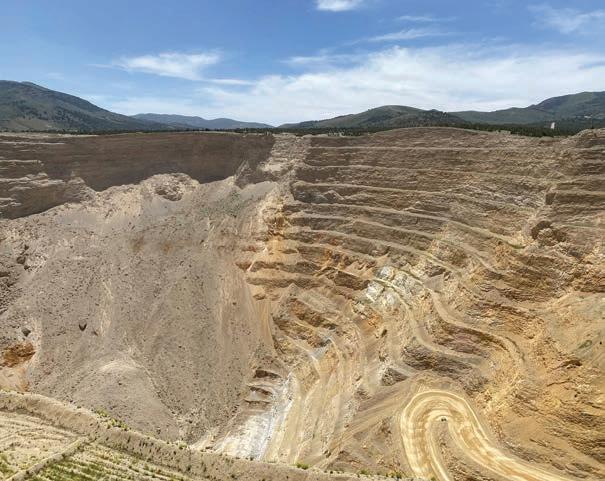
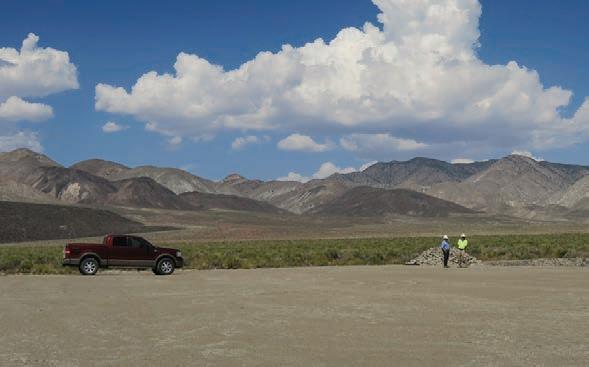
HeliosX holds a 100% interest in 403 placer mineral claims cov ering 32 sq. km of the Teels Marsh area in Nevada. The claims are near the Clayton Valley and Albe marle’s (NYSE: ALB) Silver Peak operations, the sole lithium pro ducer in the U.S.

This area of the Teels Marsh was extensively prospected by the
well-known prospector, ‘Borax’ Smith. In 1867, Smith began pro cessing borax and salt deposits. The property eventually became part of the early history of the giant borax producer, U.S. Borax, today a wholly owned subsidiary of one of the world’s largest min ing companies, Rio Tinto (NYSE: RIO; LSE: RIO; ASX: RIO).
With the discovery of lithium and boron in the Teels Marsh brines, it was concluded that these brines were formed by the evap oration of water leaching from volcanic ash originating from the ancient super eruption of nearby Long Valley Caldera, in Califor nia, says Brown. This is the same ash fall environment that contrib uted to the lithium brines of the nearby Clayton Valley.
“I think we’re in a very good position to likely drill in 2023,” Brown says. “It’s a matter of eval uating whether we drill it our selves or bring in other parties, depending on what they bring to the table.”
Brown says Teels Marsh entails a geothermally active complex, which could represent a new
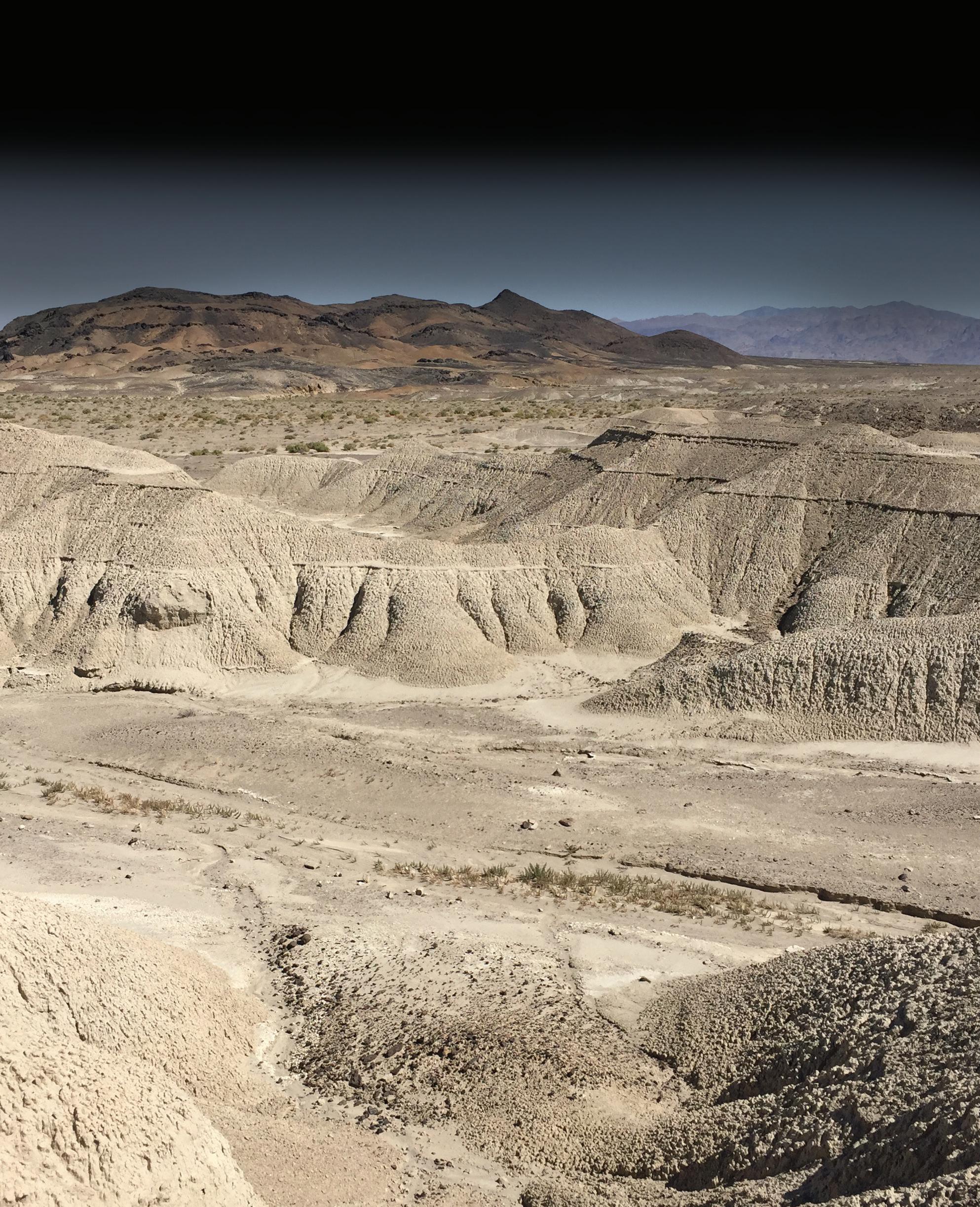

Two Vancouver-domiciled gold companies, Getchell Gold Corp. (CSE: GTCH; US-OTCQB: GGLDF) and Eleva tion Gold Mining (TSXV: ELVT; US-OTCQX: EVGDF), are mak ing gains in their respective Nevada and Arizona-focused exploration drilling programs.
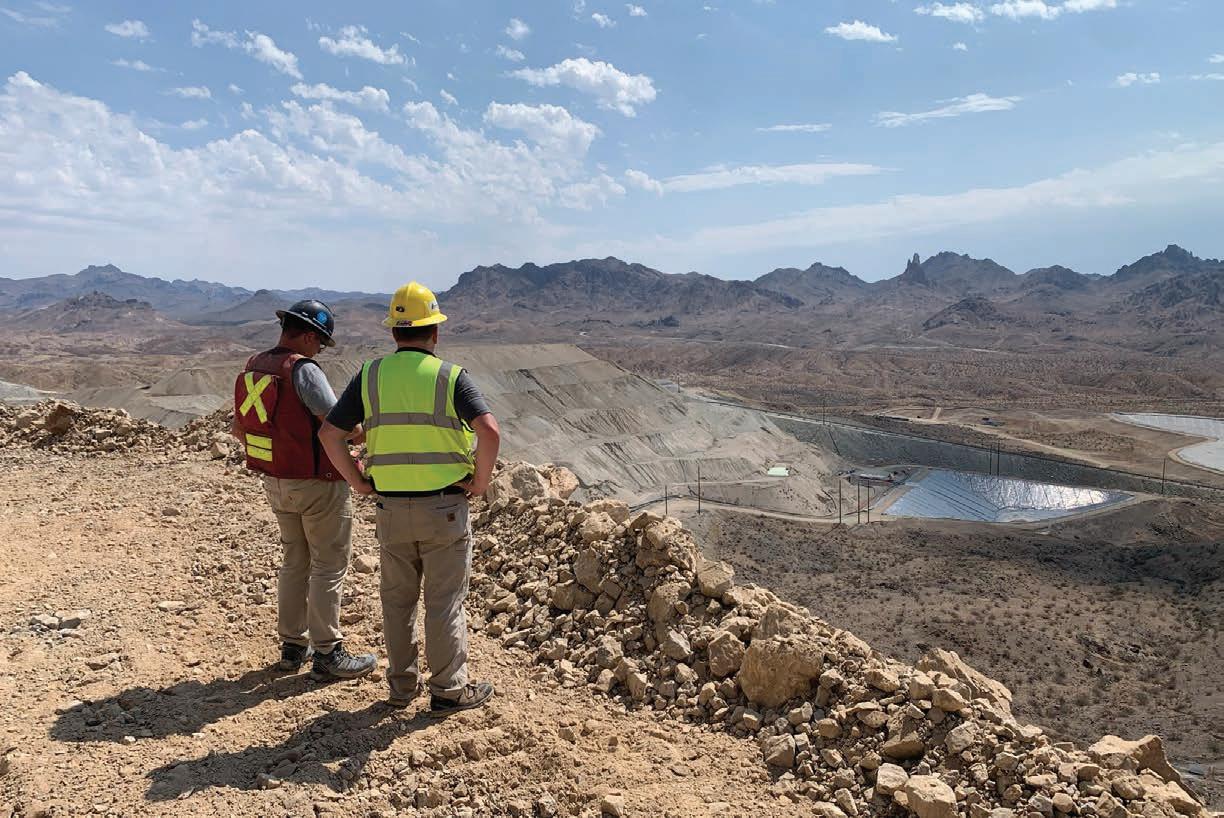

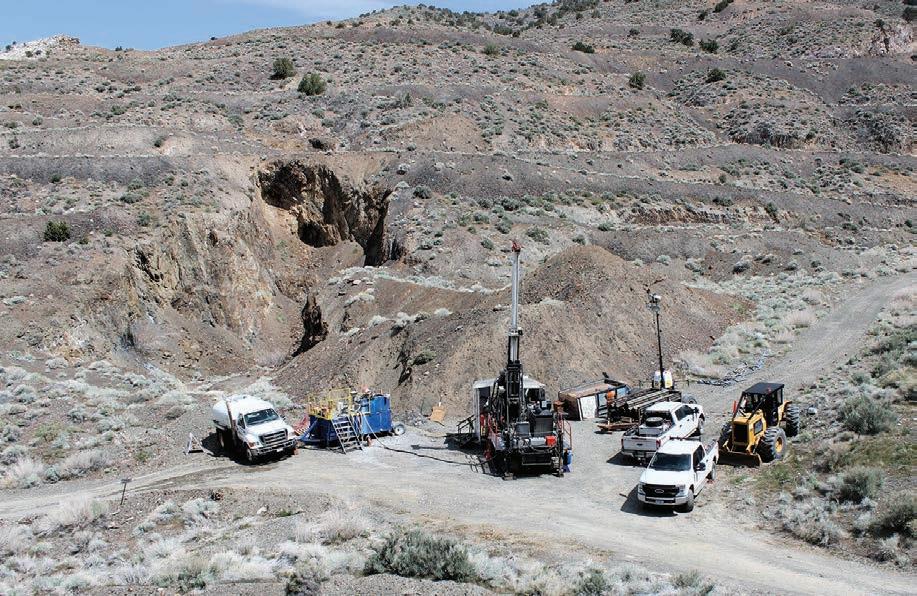
Getchell announced on Nov. 15 that the results from a single hole had intersected several significant intervals of gold mineralization at the North Fork zone in the Cen tral Area of the Fondaway Canyon project in Nevada.
Hole FCG22-22 intersected four notable gold intervals, including 8.1 metres of 8.8 grams gold per tonne from 159 metres depth, over a broader 56.6 metres interval grad ing 3 grams gold; and 21.7 metres of 2.4 grams.
Getchell said in a release that the results, from the fifth hole of the 2022 program, extend the emerg ing North Fork zone 50 metres to the south and east.
The 2022 drill program at Fondaway Canyon initially fol lowed up on last year’s high-grade gold discovery reporting 10.4 grams gold per tonne over 25 metres within a broader zone grading 6.3 grams gold over 50.7 metres.
“The North Fork zone drilling has consistently returned substan tial gold intercepts and extended the known mineralization well beyond last year’s high-grade dis covery,” said Getchell president Mike Sieb in a statement. “Better yet, North Fork remains open in all directions for further expansion.”
Getchell said it is awaiting the results of another six drill holes.
The company said holes FCG 22, 23, and 25 were also designed as step-outs to test the extent of two lower North Fork gold intervals dis covered in FCG22-18 that graded 2.1 grams gold over 43.4 metres and 1.9 grams over 72.6 metres.
The junior interprets the results as correlating well with the highgrade gold mineralization encoun tered in holes FCG21-16 and FCG22-17 that graded 6.3 grams gold per tonne over 50.7 metres and 3.8 grams gold over 85.9 metres, respectively.
Getchell says drilling has shown
the Upper North Fork gold zone as prominent across at least seven drill holes.
The lower three gold intervals encountered downhole indicate the strength and pervasiveness of the mineralizing system at North Fork. However, more drilling is needed to trace the extent of these lower prospective intervals.
The current drill program con sists of 6,000-8,000 metres, with results to date expanding the gold mineralized zones.
The company aims to further define mineralization in 2023 and complete a preliminary economic assessment by year-end.
Arizona optimism
Meanwhile, gold producer Ele vation has also reported positive visual observations in core from two holes drilled at the Florence Hill prospect in Mohave County, AZ, now sent off to the laboratory for assaying.
The first hole (FH22-001), drilled into the main Florence Hill explo ration target, intersected signifi cant structurally hosted epithermal veinlets at the top of the hole, along strike of the nearby Gold Road and West Oatman veins. The hole also intersected intensifying porphyrystyle alteration towards depth.
The second drill hole (HV22001) was drilled into the Hardy Vein target about 1,300 metres west of the main Florence Hill tar get. It returned a 3-metre-thick epi thermal quartz-calcite vein within a more than 90-metres thick zone of vein stockwork starting at 94 metres downhole. The company said the vein and vein stockwork intersected in this drill hole is like the Moss Vein and mineralized epi thermal veins historically mined in the Oatman District, such as the Ransome deposit in 1923.
A third drill hole (FH22-002)
underway on the main Florence Hill target is testing, at depth, the epithermal veining intersected at the top of FH22-001.
Elevation says the project bears geological similarities to Anglo Gold Ashanti’s (NYSE: AU; JSE: ANG) Silicon discovery in Nevada, which hosts about 3.4 million oz. oxide gold in 120 million tonnes grading 0.87 grams per tonne inferred, and Yamana Gold’s (TSX: YRI; NYSE: AUY) El Pinon mine.
Elevation, formerly Northern Vertex Mining, also suggests Flor ence Hill could host the high-grade mineralizing source for its produc ing Moss mine and the Oatman District, which has produced more than 2 million oz. to date.
The latest drill results are part of a 12-hole, 3,800-metre diamond drill program.
Getchell shares, which closed at 38¢ apiece on its latest results in mid-November, are down 42% over the last 12 months. The com pany has a market cap of $39.4 mil lion. Elevation shares closed down 3% at 14.5¢ each, down 88% over the past 12 months and 96% in the past 24 months. It has a market cap of $16 million.
URANIUM | Deal raises firm’s annual production capacity to 3.6M lb.
Anew financing pack age brings Nevada Cop per (TSX: NCU; US-OTC: NEVDF) closer to restarting and ramping-up its troubled Pumpkin Hollow underground copper mine in western Nevada, about 100 km southeast of Reno.
Pumpkin Hollow consists of two fully permitted projects — an underground mine and process ing facility, now in the produc tion stage, and an open-pit project, which the company is advancing towards a feasibility study.
Corpus Christi-based enCore Energy (TSXV: EU; OTCQB: ENCUF) is buying the past-producing Alta Mesa ura nium project in Texas from Energy Fuels (TSX: EFR) for US$120 mil lion in a deal boosting its capacity by more than 70%.
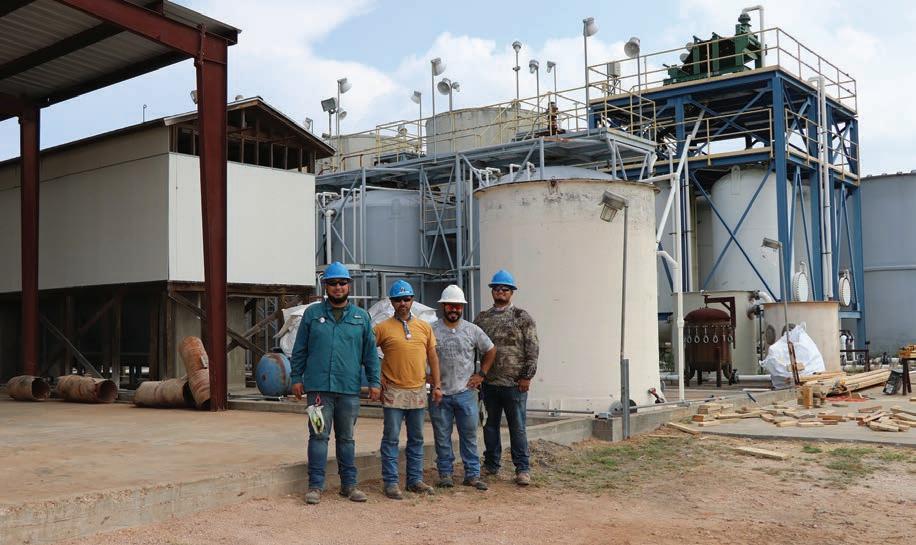
The Alta Mesa in-situ recov ery (ISR) plant, fully licenced and constructed, adds capacity of 1.5 million lb. of uranium per year to enCore, the company said in a Nov. 14 release.
The deal lifts enCore’s total pro duction capacity, including the Rosita and Kingsville Dome plants in Texas, to 3.6 million lb. per year with the goal of starting production at Rosita next year, it said.
The acquisition is being funded through a US$60 million bought deal with Canaccord Genuity as lead underwriter for 20 million shares at $3 each. The remaining US$60 million is a secured vendor take-back convertible promissory note allowing Energy Fuels two years to acquire shares and war rants of enCore at a 20% premium.
Shares in enCore Energy fell more than 10% in morning trad ing in Toronto on Nov. 14 to $2.91 apiece, and continued declining throughout the week to $2.84 at press time, its lowest price since Feb. 2021. The company has a mar ket cap of $306.4 million. Its stock has traded as high as $5.97 in the last 12 months.
Energy Fuels fell 2.6% to $9.95, then to $9.42 at press time, valu ing the company at $1.4 billion. It has traded in the range of $6.14 to $13.82 over the past 52 weeks.
Interest in nuclear rising EnCore chief executive officer Paul Goranson is a former vice-presi dent of Mesteña Uranium, which owned and operated Alta Mesa when it was in production. The plant produced 4.6 million lb. of uranium between October 2005 and November 2013, including a two-year period when it produced 1 million lb. per year.
“We generated substantial cash flow during the last cycle of elevated uranium prices and established the project as a leading United States ISR uranium producer,” Goranson said.
The company intends to ride the wave of resurging interest in nuclear energy as nations target net-zero carbon emissions to fight climate change. The global tran sition to clean energy in vehicles and power plants is expected to
cost trillions of dollars in the com ing decades. The U.S. has the most nuclear reactors with 92, while the most new constructions are under way in China with 15, according to Statista research.
Boosting enCore’s position
Alta Mesa can resume produc tion with “limited required capital” within 10 months of a produc tion decision, the company said.
EnCore said its mid- and longterm production potential is fur ther fueled by a pipeline of projects including Dewey-Burdock in South Dakota, Gas Hills in Wyoming and projects in New Mexico.
Alta Mesa has measured and indicated resources of 3.4 million lb. uranium oxide, in 1.6 million tons averaging 0.109% uranium oxide. Inferred resources add 16.8 million lb. uranium oxide in 7 mil lion tons at 0.12% uranium oxide.
The deal gives enCore three of only 11 licenced production facil ities in the United States. Alta Mesa’s 790-sq.-km property has 18.5 sq. km under lease and min ing permits and the rest under a lease-option and exploration/test ing permit, the company said.
“This transaction exceeds enCore’s long stated requirement for any major acquisition to be accretive to shareholders in not only production capacity but also cost and timelines to production,” enCore executive chairman Wil liam M. Sheriff said in the release.
Earlier this month, the com pany sold its uranium properties of Moonshine Springs in Arizona, and Kaycee and Bootheel in Wyoming to Nuclear Fuels of British Colum bia for about 20% of the shares in its potential initial public offering, several net smelter return royalties, and buy-back-in provisions. TNM
Nevada Copper suspended most mining activities in July after poor ground conditions were encoun tered in the main ramp to the East South Zone in May, requiring additional drilling and geotechni cal mitigation work.
Key components of the multipronged financing deal include equity investments of US$40 mil lion by Pala Investments, Nevada Copper’s largest shareholder, and an agreement with Triple Flag Precious Metals (TSX: TFPM) to increase its existing net smelter return royalty on the Pumpkin Hollow open-pit project from 0.7% to 2% for a purchase price of about US$26.2 million.
In addition, Triple Flag accel erated the roughly US$3.8 million remaining to be funded under the company’s existing metals pur chase and sale agreement. (Triple Flag will receive shares in satisfac tion of its reimbursable expenses.)
KfW IPEX-Bank GmbH also amended its senior credit facility to provide for a new tranche of up to US$25 million. Of that amount, Pala, Triple Flag and Mercuria,
another significant shareholder in the company, committed the first US$15 million as a backstop. The bank also deferred three interest payments (about US$13 million) under the facility.
Another element of the deal is a commitment from Pala to pro vide additional backstop support of about US$25 million (via shares, convertible and or non-convertible debt).

In an earlier press release on Oct. 25, Nevada Copper estimated ramp-up costs would be in the range of US$70 million to US$75 million, in addition to satisfying or deferring payments to vendors, which it then estimated at about US$24.5 million. At the time it also estimated it would need US$15.9 million for capital costs, US$35.9 million to fund operating costs, and US$4 million for general cor porate purposes and overhead.
Over the last year Nevada Cop per has traded in a range of 20¢ and 79¢, and at press time in Toronto was at 26¢.
The company has about 449 mil lion common shares outstanding for a market cap of roughly $171.2 million. TNM
NEVADA
MOST MINING
IN JULY AFTER POOR GROUND CONDITIONS WERE ENCOUNTERED IN THE MAIN RAMP.
 BY NORM TOLLINSKY
BY NORM TOLLINSKY
The Southwest United States is among the most prolific mining regions in North America, with mine operations dating back to the 19th century. Here’s a glimpse of eight companies exploring for precious metals, base metals and lithium in the states of Nevada, Arizona, California and New Mexico.
n
Vancouver-based Apollo Silver
APGO, US-OTC:
is working to upgrade and expand an initial inferred resource estimate for its Calico silver project in Cal ifornia’s San Bernadino County. To that end, the junior completed a 4,820-metre reverse-circulation (RC) drill program in November.
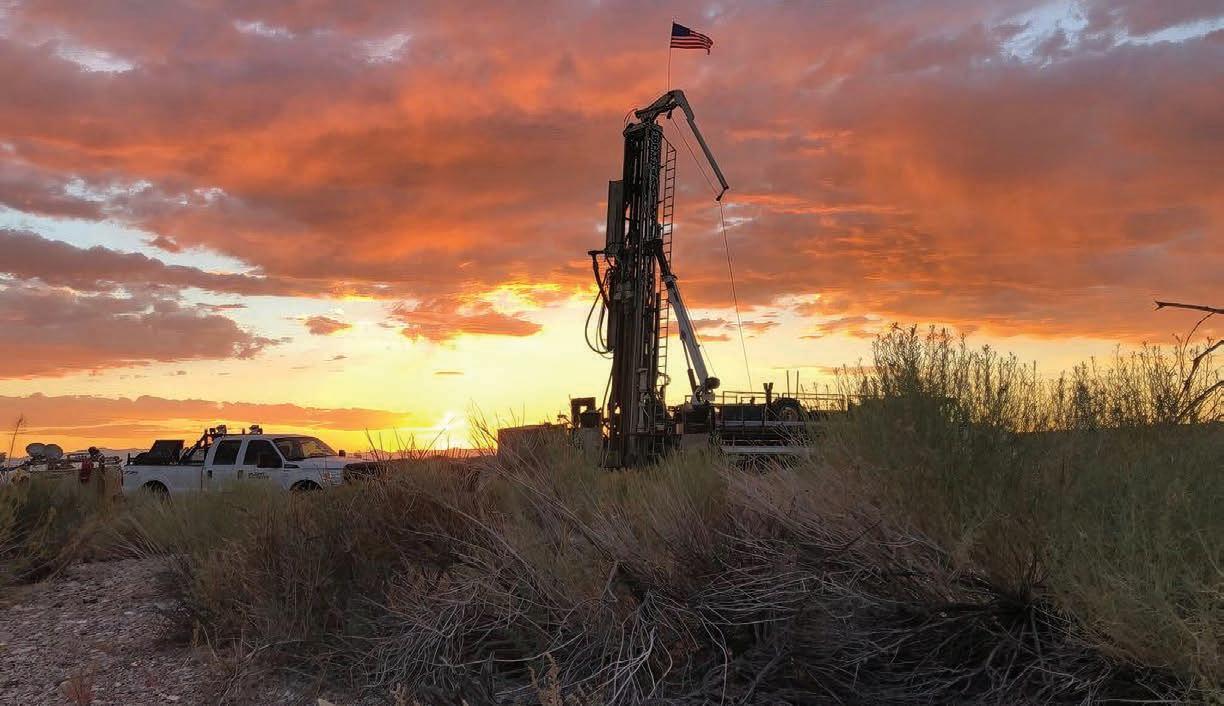
Announced in February, the inferred resource at Calico totals 166 million oz. of silver contained in 58.1 million tonnes grading 89 grams silver per tonne. The opti mized, pit-constrained estimate is based on 42,091 metres of historic drilling in 438 holes, with a cut-off grade of 50 grams silver per tonne. According to Apollo CEO Tom Peregoodoff, the estimate “con firms Calico as one of the largest undeveloped silver deposits in the U.S. and positions Calico as one of the largest globally.”

The most recent drill program, which began in September and
included 44 RC holes, followed a 5,021-metre, 44-hole reverse-circu lation drill program that the com pany says confirmed the grade, continuity and predictability of the current resource.
Apollo expects to release an updated resource estimate in the first quarter of 2023.
The Calico project, located 15 km east of the city of Barstow, com prises the adjacent Waterloo and Langtry properties covering 12 sq. km. Apollo controls approximately 6 km in mineralized strike length of a district-scale mineral system featuring low-sulphidation, sil ver-dominant epithermal vein-type
and disseminated-style deposits.
The Waterloo property was acquired in July 2021 through an asset purchase agreement between Apollo subsidiary Stronghold Sil ver USA and Pan American Miner als, a subsidiary of Pan American Silver (TSX: PAAS, NASDAQ: PAAS) with the latter retaining a 2% net smelter royalty. The Lang try property comprises 20 patented claims, and 38 unpatented lode mining claims are subject to option agreements with Athena Minerals and a private trust.
The Apollo subsidiary also has an option agreement with Gulf + Western Industries to earn a 100% interest in the 8.1-sq.-km Ari zona Silver District project 48 km north of the city of Yuma in La Paz County, AZ.
Apollo’s near-term exploration plan for the Arizona Silver District project includes a desktop review of historical data, surface geological investigation and compilation of all geological data into a preliminary 3-D geological model. The Arizona Silver District project was discov ered in 1862 and both mined and explored by a succession of compa nies over the following half century.
Apollo Silver has a market capi talization of $21.8 million.
Results from a magnetotelluric geophysical study at Ameriwest Lithium’s (CSE: AWLI, US-OTC: AWLIF) Edwards Creek Val ley property 193 km east of Reno, NV, delineated “a large near-sur face brine target that appears to be almost 20 sq. km in size,” according to an Oct. 5 press release issued by
the company.

High electrical conductivity revealed by the study is known to be caused by the presence of highly saline water within the pores of a host reservoir, prompting Van couver-based Ameriwest to follow up with permitting for a drill pro gram. The Edwards Creek property consists of 1,243 contiguous claims totalling 90 sq. km.

Ameriwest Lithium is also exploring three additional prop erties in Nevada, including the 62-sq.-km Railroad Valley lithium brine project, the 23.3-sq.-km Little Smoky Valley lithium clay project and the 30-sq.-km Deer Musk East lithium brine project.
Deer Musk East, which consists of 275 claims spanning 22.2 sq. km, is in Nevada’s Clayton Valley, 8 km east of Albemarle’s (NYSE: ALB) Silver Peak operation, North Amer ica’s only producing lithium mine. Other companies in the crowded Clayton Valley include Cypress Development (TSXV: CYP, US-OTC: CYDVF), Pure Energy Minerals (TSXV: PE, US-OTC: PEMIF), and Noram Lithium (TSXV: NRM, US-OTC: NRVTF).
Ameriwest is also exploring the 28-sq.-km Thompson Valley lith ium clay property in west-central Arizona, where it discovered sig nificant lithium concentrations as a result of a geologic mapping and initial surface sampling program initiated in June. Assay results from 44 grab samples showed lith ium content as high as 1,670 parts per million (ppm), and 12 samples with lithium content greater than
500 ppm.
A Sept. 7 press release issued by the company announced the receipt of six additional mineral exploration permits by the Arizona State Land Department to allow the company to expand its exploration for lithium deposits in and around the Thomp son Valley property.
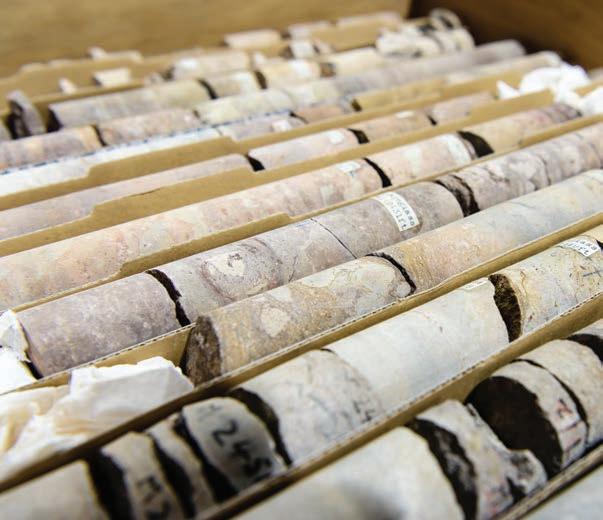
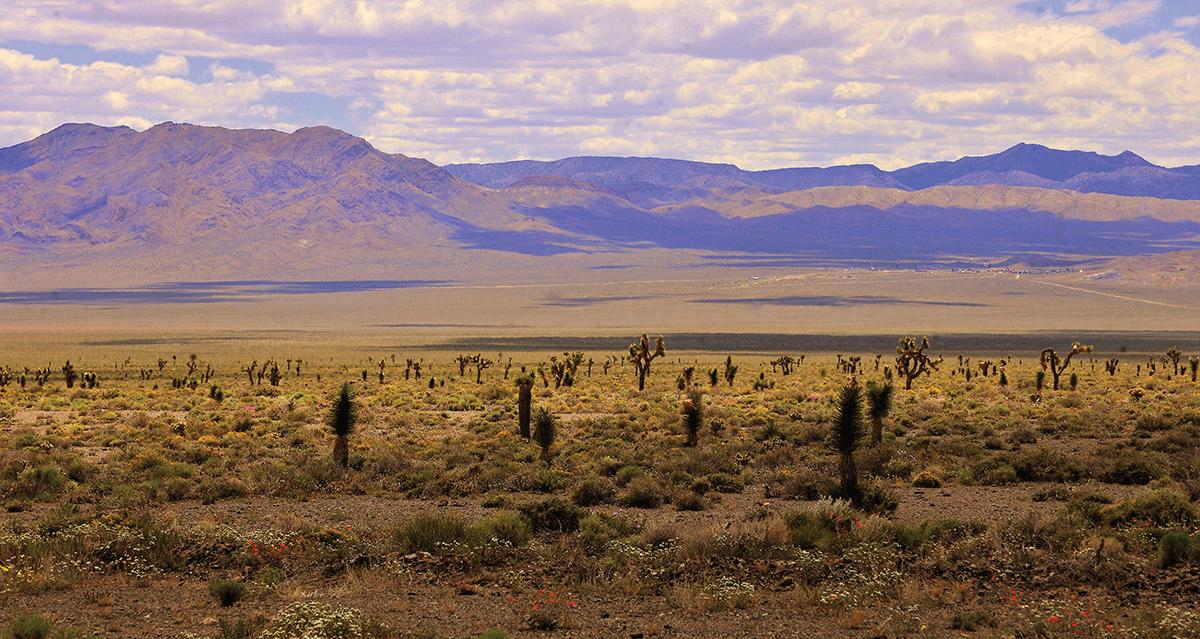
Ameriwest Lithium has a market capitalization of $22.6 million.
Toronto-based Arizona Metals (TSX: AMC, US-OTC: AZMCF) expects to begin a 76,000-metre drill program in next year’s first quarter to test the Western and Central targets of its Kay Mine project, located in Yavapai County, AZ. The steeply dipping gold-cop per-zinc VMS deposit lies about 74 km north of Phoenix. Two new drill pads 1.2 km from the his toric Kay Mine deposit have been approved by the Arizona Bureau of Land Management and a road to the site is under construction.
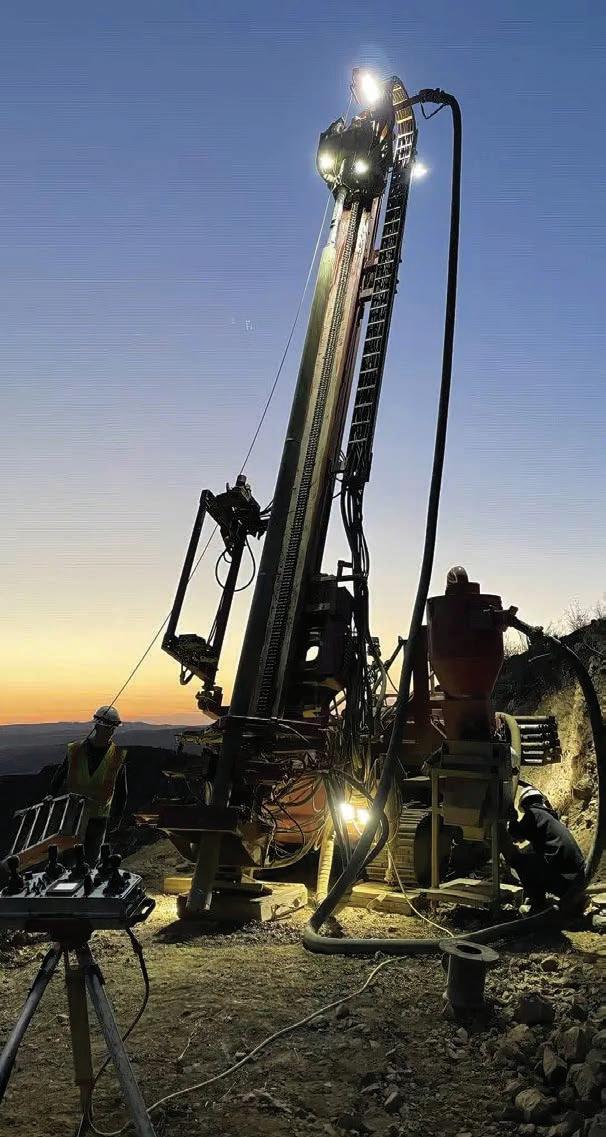
The company noted in an Oct. 31 press release that it had $60 million in cash to complete the remaining 18,000 metres of its second-phase drill program as well as the addi tional 76,000 metres of its $27 mil lion third-phase program.
Drill results reported earlier in October include 4.2 grams gold per tonne equivalent over 39 metres from a depth of 649 metres, includ ing higher grade intervals of 7.2 metres grading 6 grams gold per tonne equivalent and 9.8 metres grading 6.1 grams gold per tonne equivalent. Another hole intersected 7.9 metres grading 4% copper equiv alent from a depth of 682 metres.
The Kay Mine operated in the
early to mid 1900s, was explored by Exxon Minerals from 1972 to 1974 and changed hands several times from 1990 to September 2018, when Arizona Metals acquired the prop erty from Silver Spruce Resources (TSXV: SSE). Arizona Metals has a 100% interest in the project, which includes a combination of patented and Bureau of Land Management claims covering 5.3 sq. km.
An historic estimate (not com pliant with NI 43-101 standards) by Exxon claimed a proven and prob able reserve of 6.4 million short tons of ore grading 2.2% copper, 2.8 grams gold per tonne, 3.03% zinc and 55 grams silver.
Arizona Metals also has a 100% interest in the Sugarloaf Peak prop erty in La Paz County, AZ, 129 km west of Phoenix. A heap-leach open-pit target, Sugarloaf Peak has an unverified historic estimate of 100 million tons containing 1.5 million oz. of gold at a grade of 0.5 gram per ton.
Arizona Metals has a market capitalization of $477.5 million.
Arizona Sonoran Copper (TSX: ASCU; US-OTC: ASCUF) recently filed a resource estimate for its Cac tus project, 70 km south of Phoe nix, that included an initial resource for the nearby Parks/Salyer deposit. The combined resource pegs total indicated resources at 151.8 million tons grading 0.531% copper and inferred resources at 449.9 million tons grading 0.544% copper. (The figures include both leachable and primary material.) The Parks/Salyer deposit is located 2 km southwest of the 100%-owned Cactus project on the same privately held, 19.6-sq.-km property 70 km south of Phoenix.
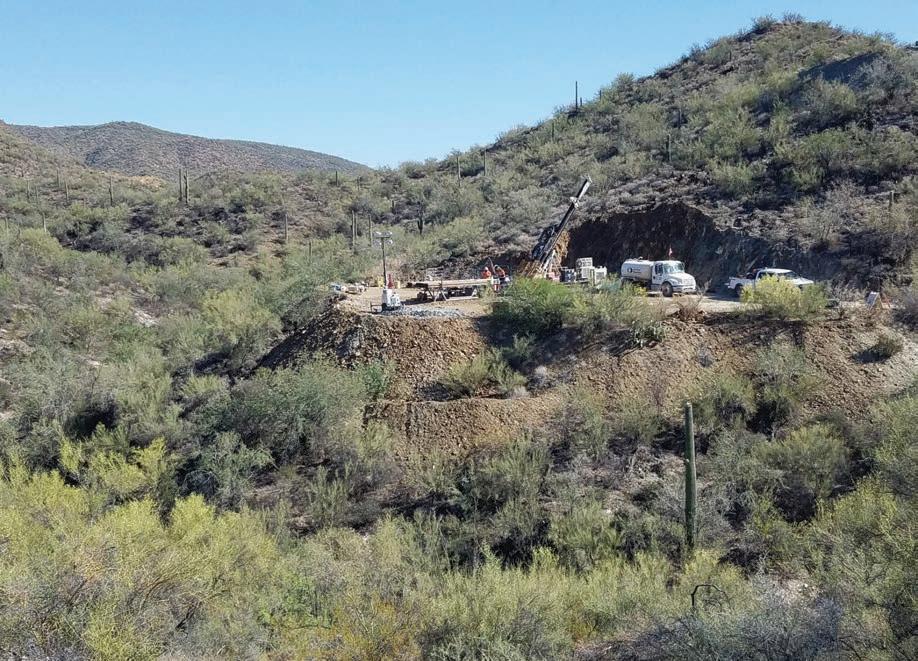
Arizona Sonoran acquired the Cactus project, formerly known as the Sacaton mine, from ASARCO Trust in July 2020 and began exploring the Parks/Salyer tar get in 2021. The Parks/Salyer ini tial resource of 143.6 million tons grading 1.015% copper was based on 31 drill holes totaling 20,271 metres at 152.4-metre spacings, but a follow-up, infill drill program of 32,000 metres is currently under way to upgrade the resource to the indicated category. The company is also working toward completing a prefeasibility study in late 2023 or the first half of 2024.
Initial assay results from the infill drill program, scheduled for com pletion by year end, include 217 metres at 1.01% total copper, 0.9% total soluble copper and 0.024% molybdenum (enriched).
“The recently issued maiden min eral resource estimate for Parks/ Salyer combined with the resource estimate at Cactus has now cata pulted the combined projects to a size that would make it the fourth largest independent copper deposit in the USA with a total copper resource of 4.9 billion lb. inferred and 1.6 billion lb. indicated,” said George Ogilvie, Arizona Sonoran president and CEO in a Nov. 2 press release. “The high-grade nature of the Parks/Salyer mineral resource inventory,” he added, “offers sig nificant potential to increase scale within an integrated operation.”
An earlier preliminary economic assessment (PEA) completed in the third quarter of 2021 for the Cactus project itself projected an 18-year mine life and the production of an estimated 56 million lb. of cop per annually from stockpiled ore, open pit and underground pro duction. The PEA contemplated
heap-leaching of the oxides and enriched material followed by sol vent extraction and electrowinning.
The Sacaton open pit was oper ated by ASARCO from 1972 to 1984, when it was shut down due to economic conditions.
Arizona Sonoran Copper has a market capitalization of $187.3 mil lion.
A 9,300-metre exploration drill pro gram at Vancouver-based Black rock Silver’s (TSXV: BRC, US-OTC: BKRRF) 21-sq.-km Tonopah North
project in west-central Nevada has revealed significant lithium poten tial to go along with its 42.6 mil lion oz. silver-equivalent inferred resource at its adjacent Tonopah West project.
The 20-hole, reverse-circulation drill program intersected values of up to 1,217 parts per million (ppm) lithium and broad zones of miner alization up to 56.4 metres thick, with lithium-bearing zones coming to within 8 metres from surface and down to a depth of 117 metres. In an
Oct. 25 press release, the company notes that the mineralization is sim ilar to American Lithium’s (TSXV: LI, OTC: LIACF) TLC deposit 3 km to the northeast.
“Blackrock’s project portfolio now consists of the highest-grade undeveloped silver project in the world in addition to what’s emerg ing as a potentially significant new lithium discovery right next door,” said Blackrock Silver president and CEO Andrew Pollard. “This posi tions Blackrock as one of the most unique companies in the emerging green metals space…”
The Tonopah West project hosts a stope optimized inferred resource estimate of 3 million tonnes at a block diluted grade of 208 grams silver per tonne and 2.5 grams gold for 19.9 million oz. of silver and 238,000 oz. of gold.
One drill hole from an ongoing 25,000-metre step-out and infill drill program reported on Oct. 18 intersected 0.91 metre of 37.86 grams gold per tonne and 2,740 grams silver (or 6,526.7 grams sil ver equivalent) within 1.5 metres grading 22.88 grams gold per tonne and 1,654 grams silver (3,942.2 grams silver equivalent) starting at 191.4 metres down hole.
The famed Tonopah Silver Dis trict produced more than 174 mil lion oz. of silver and 1.8 million oz. of gold from roughly 7.5 million tonnes of ore between 1901 and 1950.
Since 2020, Blackrock has com pleted more than 120,000 metres of drilling on the property.
The company also controls the 49-sq.-km Silver Cloud project in north-central Nevada with multi ple high-grade gold intercepts. The property is centred on the North ern Nevada Rift adjacent to Hecla Mining’s (NYSE: HL) operation.
Blackrock Silver has a market capitalization of $86.7 million.
Summa Silver (TSXV: SSVR, US-OTC: SSVRF) continues to report high-grade silver and gold intervals in drilling at its Mogollon and Hughes projects in New Mex ico and Nevada, respectively.
The Vancouver-based junior announced on Sept. 28 that it had started an 11 to 25-hole drill pro gram at Mogollon to test an area measuring 500 metres along strike and 350 metres up and down dip at a spacing it believes will sup port a potential resource estimate. Results from a six-hole drill pro
gram reported earlier this year included 129 grams silver per tonne and 3.88 grams gold over 31 metres in hole MOG22-05; and 220 grams silver and 2.7 grams gold over 11.6 metres in hole MOG21-04.
The Mogollon property is located 120 km from Silver City in south western New Mexico and is the site of the historic Consolidated mine, which shut down prematurely in 1942 due to the cessation of all gold and silver mining in the U.S. at that time. Summa Silver has an option to earn a 100% interest in the prop erty, which produced 16.4 million oz. of silver and 339,000 oz. of gold at grades of 298 grams silver per tonne and 6.16 grams gold (or 795 grams silver equivalent) between the 1880s and 1942.
Rock sampling by Summa Sil ver at Mogollon has also identi fied a number of vein extensions containing high-grade mineraliza tion, including one sample return ing 4,058 grams silver equivalent along the 2-km strike length of the Great Western Vein and another returning 2,116 grams silver equiv alent along a 1.5-km strike length of the Maud South Vein. The com pany notes that none of the identi fied vein extensions have been drill tested.
At its 100%-owned Hughes proj ect in Nevada’s Tonopah District, Summa Silver reported drill results
of 535 grams silver equivalent over 4.6 metres and 496 grams silver equivalent over 0.5 metre from an eight-hole drill program on Sept. 13. The Hughes project is host to the high-grade past producing Bel mont mine, one of the most pro lific silver producers in the U.S. between 1903 and 1929. Historical production from the Tonopah Dis trict totals 175 million oz. of silver and 1.9 million oz. of gold from 8.8 million tonnes grading 679 grams silver per tonne and 7.3 grams gold.
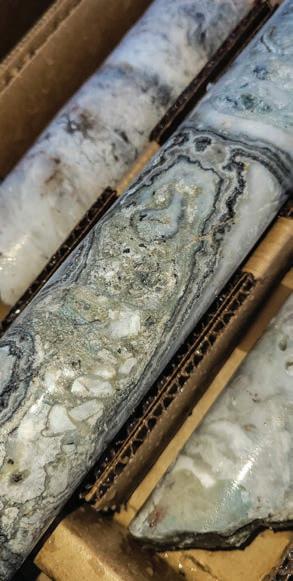
Summa Silver has a market capi talization of $54.1 million.
Nevada Sunrise Metals (TSXV: NEV, US-OTC: NVSGF) began a follow-up drill program of up to six holes at its 100%-owned Gemini lithium project in Esmer alda County, NV, in October. The 2,439-metre drill program will test lithium-bearing brine and sedi ments at depths beyond previous drilling and aid in determining the lateral extent of the mineralization.

Results from an initial, two-hole reverse-circulation drill program carried out in March and April at Gemini include a weighted average of 1,203.41 ppm lithium over 176.8 metres in borehole GEM22-01 and a weighted average of 1,101.73 ppm lithium over 222.56 metres in bore hole GEM22-02.
The Gemini project consists of 582 unpatented placer and lode claims covering 23 sq. km and is located 10 km east of Lida and 35 km southeast of Albemarle’s Silver Peak lithium mine.
The Vancouver-based company also has interests in several other properties in Nevada, including 100% of the Jackson Wash lithium
and Coronado VMS projects, 20% of the Kinsley Mountain gold proj ect, and a 15% interest in both the Lovelock Cobalt mine and Trea sure Box copper projects.
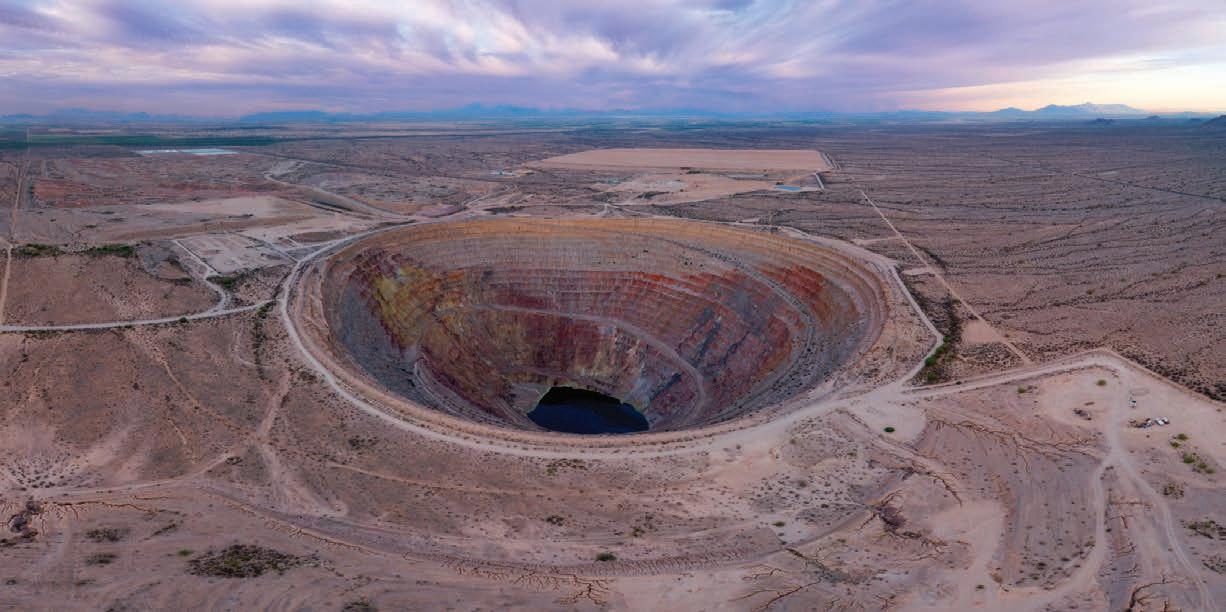
Jackson Wash, located in the Lida Valley, 30 km southeast of the Silver Peak mine, consists of 49 unpatented placer claims total ling around 4 sq. km. Coronado consists of 133 unpatented claims totalling 10.8 sq. km adjacent to the historic Big Mike open pit copper mine in Pershing County, 48 km southeast of Winnemucca.

Kinsley Mountain, located in Elko County and co-owned by Copaur Minerals (TSXV: CPAU, US-OTC: COPAF) has a February 2020 resource estimate of 5 million tonnes grading 2.63 grams gold per tonne for 418,000 oz. of gold. The deposit produced 138,000 oz. of gold in the early 1990s and a 28,000-metre drill program was carried out by previous owner Lib erty Gold (TSX: LGD, US-OTC: LGDTF) between 2011 and 2013.
Nevada Sunrise has a market capitalization of $23.1 million.
On Nov. 1, Nevada King Gold (TSXV: NKG, US-OTC: NKGFF) announced an extension of its definition drilling program at its wholly-owned Atlanta gold mine project in the prolific Battle Moun tain Trend, 246 km northeast of Las Vegas. Based on positive initial assay results, numerous high-pri ority targets still to be tested and the early completion of the 100hole, 13,100-metre program, the company elected to continue drill ing as long as the weather remains favourable. It now anticipates drill ing a total of 16,000 metres as part
of the program.
Early assay results at Atlanta include high-grade oxide-hosted intervals of 120.4 metres of 1.49 grams gold per tonne and 57.9 metres of 1.38 grams gold located south and southeast of the Atlanta pit, as well as 54.9 metres of 3.41 grams gold, 50.3 metres of 2.65 grams gold and 51.8 metres of 2.23 grams gold starting from surface at the bottom of the pit.
“Drill results continue to demon strate a strongly mineralized system that is open in all directions,” said exploration manager Cal Herron in a release. “With each drill hole, we are gaining a better understanding of the geology, controls on miner alization and grade distribution…”
The Atlanta mine is a former gold-silver producer with an Octo ber 2020, pit-constrained resource. The project hosts a measured and indicated resource of 460,000 oz. of gold in 11 million tonnes grading 1.3 grams gold per tonne. Inferred resources add 142,000 oz. of gold in 5.3 million tonnes grading 0.83 grams gold.
Nevada King is also drilling its 100%-owned Lewis and Iron Point gold projects. The company began a 4,500-metre drill program at Lewis, located 21 km south of Battle Moun tain, NV, in August, with results pending. It also conducted a 4,000metre deep-drilling program at Iron Point, 35 km east of Winnemucca, that confirmed Carlin-type gold mineralization hosted in Lower Plate carbonate rocks.
Nevada King, which claims to be the third biggest landholder in Nevada, also owns or controls eight other properties in the state.
Nevada King Gold has a market capitalization of $78 million. TNM

PRECIOUS METALS | Projects add 143.7 sq. km to AngloGold’s Beatty district portfolio

Coeur Mining (NYSE: CDE) shares shot up 12% on Nov. 4 after the company announced the sale of its southern Nevada projects to a subsidiary of AngloGold Ashanti (NYSE: AU) had closed.
Coeur’s southern Nevada port folio comprises the Sterling and Crown exploration properties, which cover a total of 143.7 sq. km of land adjacent to AngloGold’s existing gold projects in Beatty district.
The high-grade Sterling gold project hosts a past-producing open-pit and underground heap leach gold mine located in the southern portion of the land pack age, with major permits in place. The Crown block, which is located in the northern portion of the land
package, includes four heap-leach able deposits: Daisy, Secret Pass, SNA and the recently discovered C-Horst zone.
As detailed in a news release on Sept. 19, Coeur received US$150 million cash upfront for the sale, plus additional deferred cash consideration of US$50 million should the Sterling and Crown gold resource reach more than 3.5 million ounces.
On the deal’s closing, Coeur shares rose to $3.99.
“The divestiture of Crown Ster ling unlocks significant value for Coeur stockholders and demon strates our ongoing commitment to allocating capital into our exist ing portfolio of near-term core growth projects, highlighted by the Rochester expansion in north ern Nevada,” said Coeur’s presi dent and CEO Mitchell Krebs.
On AngloGold’s side, the move increases its foothold in Neva da’s Beatty district, where it earlier bought all projects held by Corvus Gold via a US$370-million acqui sition of the Canadian junior that closed in early 2022.
“Following its recent acquisi tion of Corvus Gold, AngloGold has consolidated a significant por tion of the Beatty district and is the logical operator of a future stand alone mining operation in the Beatty district,” Krebs noted.
Prior to this acquisition and pending permits and studies already underway, AngloGold had anticipated first production in the Beatty district by 2025, and said those assets would produce about 300,000 oz. of gold annually, with an all-in sustaining cost of less than US$1,000 per oz., by the end of the decade. TNM
BY JACKSON CHENRiley Gold (TSXV: RLYG; US-OTC: RLYGF) has received a US$2.6 million investment from Osisko Gold Royalties (TSX: OR; NYSE: OR) in exchange for royalties on two gold projects held by Riley Gold’s wholly owned Nevada subsidiary.
joint venture. Historical drilling on the property — which began in the early 1990s — returned results of 2.59 grams gold per tonne over 4.6 metres, including a high value of 3.84 grams gold.
replenishable source of lithium. “Geothermally based lithium brines could potentially be a new system of rechargeable lithium, which, if that’s the case, could be a game changer for the industry,” says Brown.
Meanwhile, just across a ridge from Albemarle’s Silver Peak operation is HeliosX’s 11.3-sq.-km Alkali Lake asset. The company has recently added more acreage around the acquired Dajin hold ings.
“On a geological basis, even though Dajin held the core of what they believed was the key compo nent of Alkali Lake, I believe the depositional environment is much larger,” says Brown. “The associa tion of a closed basin with an arid environment, a geothermal sys tem and plentiful sources of lith ium suggest that Alkali Lake valley may host significant lithium-rich brines.”
Diversified focus
HeliosX is also building a prospec tive lithium brines portfolio in Canada’s oilfields in Alberta.
Brown says the Fox Creek area, located about 260 km northwest of Edmonton has been identified as one of the most prospective regions in Alberta for higher con centration lithium brines and larger geological complexes. The lithium brine-bearing formations and carbonate units of interest
are the Leduc Formation of the Woodbend Group and the Swan Hills Formation of the Beaverhill Lake Group. To date, initial indi cations are that the highest con centrations tend to be associated with the Swan Hills carbonate complexes.
Brown says the region of inves tigation covers over 75,000 sq. km at prospective depths between 2,220 to 4,000 metres. Average thicknesses could range between 12 to 45 metres.
“The volumetric opportunities in this region are in the billions of barrels of lithium brine resource in place,” says Brown. “The focus is on identifying regions which combine the ‘complete picture’ of future commerciality, which includes surface access, infrastruc ture, Indigenous consultation, protected parks, species migration patterns, reservoir depth, and lith ium concentration.”
The company hopes to con clude drilling and pilot testing tri als in Alberta later in 2023.
Meanwhile, subsidiary Dajin Resources owns a significant land position in northwestern Argen tina, part of an area known as the ‘Lithium Triangle’ where it has been reported that 80% of the world’s supply of lithium is found in flat salt lake basins, also known as ‘salars’ or brines.
HeliosX controls about 930 sq. km in the Guayatoyoc basin.
“With our partner Pluspet rol Resources, next year, we were
hoping again to put down a couple of wells in the basin. Seismic test ing has been great. We clearly see a very thick section of sedimentary basin down to easily 1,800 metres. The Orocobre and Lithium Amer icas assets only go down to about 1,000 metres of sedimentary depth, so we have a much larger, thicker pay potential,” says Brown.
The success of emerging direct lith ium extraction technologies under pins HeliosX’s value strategy.
“Our partner in Argentina today has 12 independent technol ogies for lithium extraction in its research facilities. That gives you a sense that no one great solution will take over the industry anytime soon,” Brown says.
“Today’s young minds will con tinue to evolve direct extraction technologies to make it more effi cient.”
For now, HeliosX remains rel atively agnostic to the extraction technology itself. “We deal, for example, in Canada, working with a group based out of the Univer sity of Calgary working on lith ium extraction years before it was in fashion. And so that’s what I like about the university system, is that it encourages this out-of-box thinking,” says Brown.
At 49¢, the company’s shares are down 48% over the past 12 months, having tested a high and low of $1.31 and 42¢ per share. It has a market cap of $17.7 million. TNM
The agreement comprises a 2% net smelter return royalty on the Pipeline West/Clipper (PWC) gold project; a 0.5% NSR on the Tokop gold project, and an assignment of certain royalty buyback rights on PWC.
Proceeds from the investment will be used for exploration and development activities on these properties. According to Riley Gold, this investment would allow for various work streams including continued exploration at PWC.

Located in Lander County, about 80 km southwest of Elko, the PWC project includes 24.7 sq. km of unpatented mining claims and patented lands adjacent to properties controlled by Barrick Gold (TSX: ABX; NYSE: GOLD) and Newmont’s (TSX: NGT; NYSE: NEM) Nevada Gold Mines
The Tokop project is located on the prolific Walker Lane trend in Esmeralda County, about 80 km south of Tonopah. The land pack age encompasses more than 31 sq. km, with several deposits currently under development or mined nearby.
“We are extremely pleased to have Osisko endorse and support our work in Nevada, particularly at PWC, by way of the investment. We believe that this transaction delivers significant value to our shareholders through our ability to limit equity dilution given the current challenging state of the equity markets,” Todd Hilditch, CEO of Riley Gold, commented.
Shares of Riley Gold surged 35.7% in Toronto time following the investment announcement, and closed the day at 18¢ apiece. Its shares have traded in a 52-week window of 9¢ and 42¢. The com pany has a market capitalization of about $5.8 million. TNM
Institute, on a panel about critical mineral extraction and processing timelines.
“The Chinese don’t look at the next quarter. They look at the next decade. Two decades down the road.”
Even though China “dominates” the global market for mining nine out of 13 critical minerals, Neill said, the country also excels in the processing of cobalt and tin.
However, the summit speakers weren’t all rending their garments over the tough competition with China.
Some, like Kirl Mugerman, president and CEO of Geomega Resources (TSXV: GMA) noted some steps in the right direction in the West.
To begin to compete with China on mineral extraction and produc tion, Mugerman said North Amer ica companies have to find ways of making their processing more eco nomical.
“[With] production and process ing technologies, we need to make them 50% better [or] 75% bet ter. Change the rules of the game. Innovation,” he said.
“Universities have to be getting involved in research. There really has to be a different mentality going forward,” he said, noting that the
Saskatchewan Research Council (SRC) has been a strong player in driving innovation.
In 2020, the SRC signed a bind ing term sheet with Vital Metals (ASX: VML) to negotiate agree ments for the construction and operation of a rare earth extraction plant in Saskatoon, Sask. to pro duce mixed rare earth carbonate. Through its Canadian subsidiary Cheetah Resources, Vital operates Canada’s only rare earths mine, the Nechalacho project in the North west Territories.
In the U.S., the Critical Materi als Institute, founded in 2013 by the Department of Energy is work ing to help cultivate domestic skills to overcome what Marty Weems, president of American Rare Earths Limited called “a desert of talent in processing in America.”
The combination of investment in skills with political develop ments like the Inflation Reduction Act could lead to “one of the great est industrial actions since World War Two,” Weems said.
“Two words you will always see out of this [Biden] administration are ‘and allies.’ They’re not looking to do this alone. It is why we engage with SGS labs and… the Saskatch ewan Research Council. We know the talent is going to have to be global among the allies, especially to solve the processing piece. And we want to be a part of that in a disrup tive, environmentally friendlier way than the current tech sector.” TNM
together,” van der Toorn conceded. “There’s more work to be done here.”
Reunion is keen to delineate and grow the deposit, but also test its depth potential.
“We’re focusing on developing at an inferred drill spacing as we go deeper down at depth,” van der Toorn said.
A particular focus is filling in the space between current resource drilling and the company’s deepest hole (112), which extended miner alization to about 600 metres below surface.
Reported in June, hole 112 cut 71.2 metres of 3.68 grams gold per tonne ending at a vertical depth of 575 metres. It was a 226-metre step-out from the previous deepest hole, 63, which cut 67.3 metres of 1.5 grams gold to a vertical depth of 349 metres.

As it grows Oko West, Reunion is also busy with environmental
baseline work, a geotechnical study for the potential open pit, and a comprehensive bottle-roll test that will inform a large-scale metallur gical program to follow. (Prelimi nary bottle-roll tests indicated gold recoveries of 78-96%.)
The company’s discovery has not gone unnoticed. In September, BMO Capital Markets mining ana lyst Brian Quast initiated coverage of Reunion, calling Oko West “one of the most exciting discoveries in recent years.”
Quast, who believes the Kairuni zone’s near-surface high grades and “excellent widths” could make Reunion a takeover target, sees potential for a 2.2-million oz. resource in 38 million tonnes grading 1.8 grams gold per tonne when the company posts its first resource. Ultimately, the proj ect could evolve into a series of open pits with longer-term under ground production as well.
The analyst also points out that outside of power, infrastructure at Oko West is quite good. The road-accessible project is an eighthour drive from Georgetown or a four-hour journey by a combina tion of road and boat.
As luck would have it, Aris Min ing (TSX: ARIS) has been upgrad ing the local Puruni Road that runs past Oko West for all-season access to its development-stage Toroparu copper-gold project to the west.
“In the past all these roads in the interior were a bit problematic but this is now a good all-weather road,” van der Toorn said.
There’s also potential for hydro power within 100 km of Oko West from the proposed 165-megawatt Amaila Falls project, or within 30 km of the site with modular, runof-river hydro.
With 986.8 million shares out standing, Reunion Gold has a mar ket cap of $438 million. At press time, it traded at 40¢ in a 52-week range of 11¢ and 48¢. TNM
ST-GERMAIN from 1
Resources (now Ring of Fire Met als) earlier this year after winning a bidding war with BHP (NYSE: BHP; LSE: BHP; ASX:BHP).
St-Germain sat down in Sep tember with Anthony Vaccaro, president of The Northern Miner Group, to discuss her career thus far.
VACCARO: What are you enjoying about this phase of your career, and what are some of the challenges?
ST-GERMAIN: I’ve been on boards for the past five years — it’s a great experience because you are exposed to other companies — other man agement teams. You always learn from your experience with compa nies. It makes me a better CFO for Integra because you are connected in the industry. Every company has challenges — I think it’s the name of the game when you’re in min ing. With all the developments — I think it will be exciting years.
VACCARO: When it came to Wyloo, what made you take on that specific challenge?
ST-GERMAIN: I think it was the team. It was a very young, dynamic team, and their vision focused on green metals. And that’s the big push to promote the industry.
VACCARO: Why did you want to do an MBA in capital markets, and what made you specialize in mining?
ST-GERMAIN: During my MBA there were banking [recruiters] who came to the school — and I think that’s why outreach is so crit ical to the industry. And I think it was more following my guts.
VACCARO: You started at Dundee [Precious Metals] with the late Ned Dundee, another Canadian Mining Hall of Fame member. Do you have any experiences with Ned you could share?
ST-GERMAIN: Over the years, I would bump into Ned in the hall ways. He was on the top floor. I was at the bottom floor. He was always very kind. What I remember the most is my last day at Dundee — I was in Vancouver and flew back to Toronto just for the day and Ned said, “come see me in my office” and we sat down. He was very pas sionate about mining and shared some advice about the industry. I was very touched. It was just half an hour of his time, but it made a big impression on me.
VACCARO: What was the transition like, coming out of the investment banking world to Golden Queen? What were some of the key
ST-GERMAIN: It was probably one of the scariest decisions of my life. I almost said no. I don’t want to generalize, but often women, we think about our credentials more than our potential. I’m not a CA, so I didn’t think I could be a CFO. I thought about it, and called my boss, and he said “Andrée, you’re stupid if you say no. Just do it.” It was definitely a big switch. It came with challenges, the first one was my own insecurities. I think it’s normal to have insecurities, but they have to be short-lived.
VACCARO: How did you overcome those?
ST-GERMAIN: Working hard. I’m a big believer in paying your dues. I kept my same banking hours at Golden Queen. Also, throughout my career I’ve had a lot of great champions who have supported me. In the case of Golden Queen, I had a lot of support from the board and from the CEO. So that gives you confidence as well. At Golden Queen it was a pretty lean team, so you wear a lot of hats — not just budgeting and accounting, but project financing, HR and IT compliance all falls on you. I think one thing that helps is you need to be humble and understand that you can’t do everything. You can’t
be an expert at everything. You’re not expected to. I have my spe cific skill set, and the skills that I need help with — that’s where the team comes in. It’s about leveraging those resources.
VACCARO: What about leaving Golden Queen? How did the Integra opportunity come about and why was it appealing?
ST-GERMAIN: George Salamis, the CEO approached me, and it was at the stage where the project was ready to be financed. The project was in Quebec, so it was perfect. They brought me in, and I didn’t have a day off in between — it was from one office to the other. We were about a week from signing a term sheet on the project financ ing when the bid from Eldorado came in. To be involved with an M&A (deal) from that perspective, the company side, was really good. A lot of the work comes before the announcement — from the idea to the negotiation.
VACCARO: Talk to us about some of the best advice you’ve received over your career?
ST-GERMAIN: Some of the best was to enjoy the highs because the lows are quite brutal. Profession ally, some of the best advice I got was from a book by Sheryl Sand
berg, Lean In: Women, Work, and the Will to Lead where she refers to how in the past, you had to climb the corporate ladder if you want to make it to the top. But now, you have to see the workplace more as a jungle gym, where you’ll do lat eral moves. If you look back at my career — that’s really what hap pened.
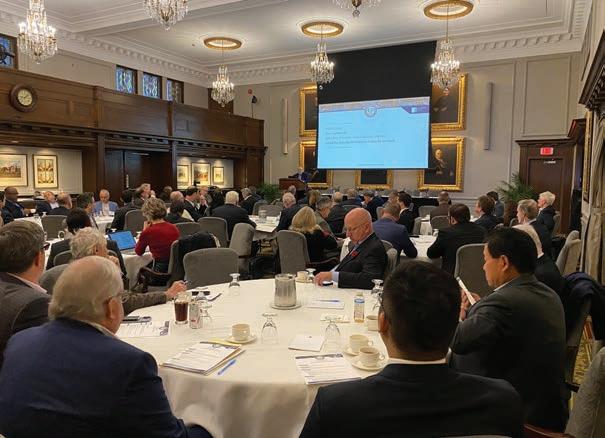
VACCARO: Given that the industry has been grappling with diversity in its history, how much progress has been made in the last five years? Has the pace changed fast enough?
ST-GERMAIN: I’m very impressed with the industry, genuinely. In my investment banking days, I didn’t meet too many women CEOs. CFOs, maybe. I went to countless board meetings and didn’t recall seeing many women. I would say the past five years have been a huge shift. Pretty much all boards I’m involved with have at least two women. Many companies are mov ing past the ‘just one woman’ on the board. And you see more women in the C-suite, which is great.
These changes take time. You need to have good retention plans in place, and training, and under stand that women need a different type of mentorship sometimes, so have programs more tailored for women.
TNM

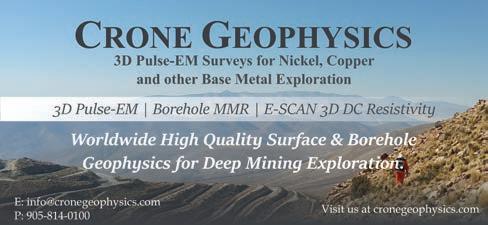

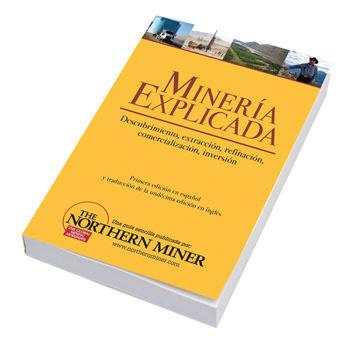
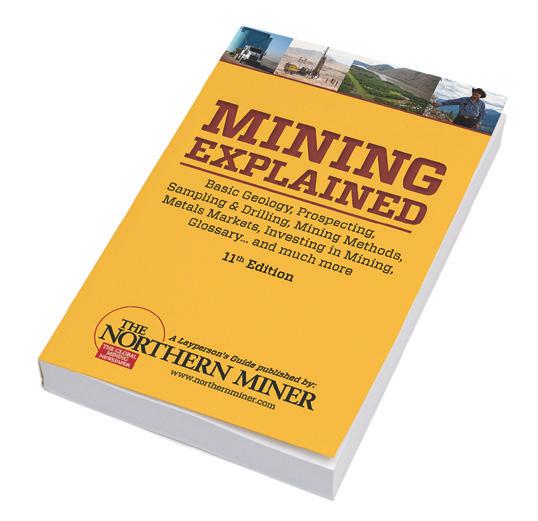
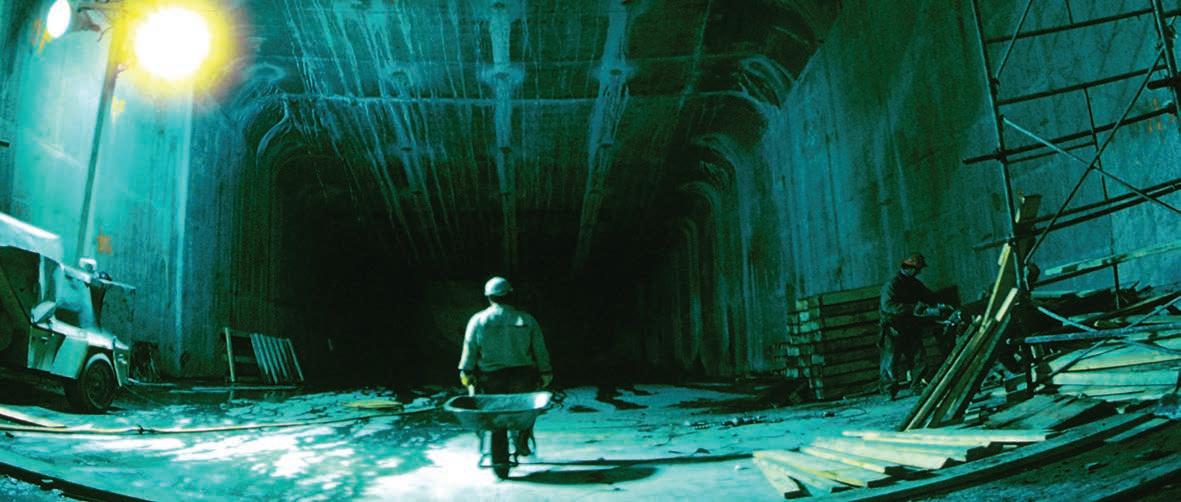



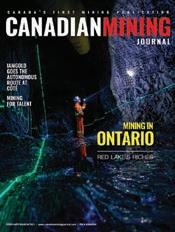



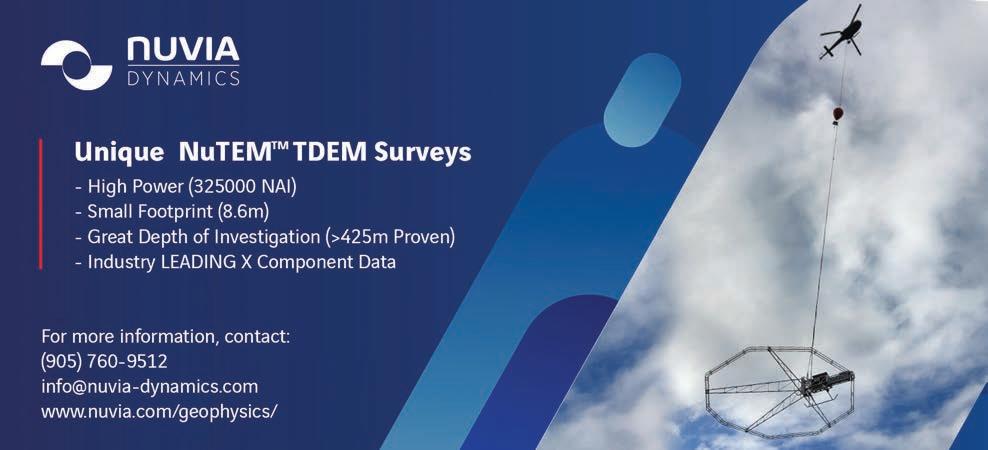
TORONTO STOCK EXCHANGE / NOVEMBER 14—18, 2022
Stocks fell slightly over the Nov. 11-18 trad ing period as energy stocks suffered from European oil and natural gas inventories approaching capacity.
The S&P/TSX Composite Index shed 130.6 points or 0.6% to 19,980.91. The S&P/TSX Global Mining Index decreased 1.52 points or 1.5% to 102.54, and the S&P/TSX Global Base Metals Index lost 7.98 points or 4.4% to 175.29. The S&P/TSX Global Gold Index fell 6.28 points or 2.4% to 260.39, and spot gold ended the week at US$7.75 per oz. or 0.4% lower at US$1,759.35 per ounce.
Potash fertilizer producer Verde Agritech was the second-largest loser in percentage terms over the week, falling by 22% to close at $5.71 after reporting third-quarter earnings.
“It was a pity that we could not fulfil all the orders placed in our books, having had to turn down so many orders because of the operational constraints then present,” Verde’s president and CEO Cristiano Veloso said in a Nov. 14 release.
The Brazil-focused company said last month it had solved water issues during the construction of access roads to its Plant 2. The plant achieved its targeted output rate of 1.2 million tonnes per year of the company’s multinutrient potassium products in Octo
ber. It’s continuing a plan to double Plant 2’s production to 2.4 million tonnes a year. Plant 1 is producing at its capacity of 600,000 tonnes a year. Verde, said net profits more than doubled to $6.5 million compared with $3.2 million in the same period a year ago.
International Tower Hill Mines shares lost 16% after saying in its third-quarter results on Nov. 10 that it “will require sig nificant additional financing to continue its operations” advancing the Livengood gold project in Alaska.
“There is significant uncertainty that the company will be able to secure any additional financing in the current or future equity markets,” International Tower Hill said. The
Suncor Energy SU 58573 49.37 46.45 47.66 1.11
Barrick Gold ABX 50513 21.86 20.51 20.91 0.90
Lundin Mng LUN 27056 8.50 7.66 7.68 0.55
Kinross Gold K 18871 5.74 5.36 5.48 0.22
Argonaut Gold AR 15616 0.41 0.33 0.35 0.06
Fission Uran FCU 14494 0.82 0.72 0.77 + 0.02
First Quantum FM 14368 34.00 29.06 29.51 4.05
B2Gold Corp BTO 11373 4.74 4.41 4.53 0.19
Yamana Gold YRI 8513 6.87 6.54 6.76 0.04
Copper Mtn Mng CMMC 8443 1.78 1.49 1.49 0.24
TSX VENTURE EXCHANGE / NOVEMBER 14—18, 2022
The S&P/TSX Venture Composite Index retreated by 23.9 points or 4% over the Nov. 14-18 trading session to end at 575.88.
Among only a handful of value gainers this week was Cornerstone Capital Resources, which added 42¢ to close at $4.25 per share. SolGold in October agreed to acquire all the outstanding shares of Cornerstone it does not already own by way of a court-approved plan of arrangement. The merger is expected to create value for shareholders by consolidating ownership of the Cascabel project in Ecuador and the combined company’s wider portfo lio. In April, a prefeasibility study indicated that Cascabel is expected to be a top 20 South American copper-gold mine.
Leading in losses this week was Sigma Lithium, which closed $6.70 lower at $39.49 per share. Lithium stocks were hit hard in the trading week. Goldman Sachs revised its lithium forecasts for the years ahead, and lithium spot prices fell slightly from slowing Chinese EV demand. Established lithium-fo cused companies suffered losses between 5% and 15% on the day before the report was released, all because EV sales slowed slightly earlier than expected as Chinese EV subsi dies approached completion. On Nov. 18, the company said it was accelerating con struction activities, including completing the
run of mine wall and structural steel for all four areas of the crushing plant for the Grota do Cirilo project in Brazil. The project rep resents one of the largest and highest-grade hard rock lithium spodumene deposits in the Americas. Sigma Lithium remains on track to begin commissioning of the crushing plant by year end, and commercial production in April 2023. The project is expected to gener ate significant free cash flows in next year’s second quarter, as one of the lowest-cost pro ducers of battery grade lithium concentrate.
PureGold Mining saw the most shares changing hands on the TSXV board this week with 39.7 million shares traded. The embattled company said on Nov. 14 it won’t complete a prefeasibility study on the Pure
VOLUME WEEK (OOOs) HIGH LOW CLOSE CHANGE
Pure Gold Mg PGM 39722 0.02 0.01 0.02 unch 0.00
X-Terra Res XTT 7807 0.08 0.04 0.06 + 0.02
Great Quest Fe GQ 7575 0.02 0.00 0.02 + 0.01
American Eagle AE 7556 0.34 0.23 0.30 + 0.02
Surge Battery NILI 7200 0.15 0.10 0.15 + 0.05
Opawica Expl OPW 6253 0.08 0.03 0.03 0.05
Tombill Mines TBLL 4536 0.02 0.01 0.02 unch 0.00
Jourdan Res JOR 4401 0.12 0.08 0.10 unch 0.00
Aurcana Silver AUN 4121 0.02 0.01 0.01 unch 0.00
Pacific Empire PEMC 3990 0.04 0.02 0.02 + 0.01
U.S. MARKETS / NOVEMBER 14—18, 2022
U.S. markets showed a modest decline over the Nov. 14-18 trading week as mixed data on inflation and retail sales were balanced by positive earnings in both the consumer cyclical and technology sectors. The Dow Jones Industrial Average fell 2.17 points to 33,745.69 and the S&P 500 dropped 27.59 points or 0.7% over the week to 3,965.34.
Shares of Gold Fields slipped 7% to US$10.58 as investors digested the aftermath of the company’s failed takeover of Yamana Gold. The previous week, the stock saw its biggest gain in two-and-a-half years on news the company was dropping its bid for Yamana, which instead signed an agreement with Agnico Eagle Mines and Pan American Silver for a cash-and-stock transaction worth close to US$5 billion. While Gold Fields was “disappointed” by the cancellation, it was “not prepared to be drawn into a bidding war” for a deal previously criticized by major shareholders. Gold Fields, which recently delivered stable financial guidance and gold production levels in its third quarter report, is now eligible for a US$300-million termina tion fee from Yamana.
Rio Tinto shares rose 48¢ to a six-month high of US$65.19 during the week. The min ing giant announced on Nov. 17 it had can celled a deal to tie up support for its proposed
US$3.3-billion acquisition of Turquoise Hill Resources after Quebec’s securities regula tor raised concerns about the side deals with Pentwater Capital Management and Sailing Stone Capital Partners. Rio has been seeking control of Turquoise Hill since March when it launched its initial bid. It already owns a 51% interest in Turquoise Hill, but owning the company outright would give it direct controlling ownership of the Oyu Tolgoi copper-gold mine in Mongolia. Sharehold ers are currently deciding whether to accept Rio’s all-cash offer of $43 per share, with the deal requiring two-thirds to vote in favour. In response, Turquoise Hill said it plans to apply for court action to set a new date for a special shareholder meeting to consider
Vancouver-based company reported US$5.5 million in cash on Sept. 30.
First Quantum Minerals lost the most by value over the period, dropping $4.05 to $29.51 after saying the government of Pan ama has set a deadline of Dec. 14 for the com pany to sign a contract allowing it to continue to run the Cobre Panama copper mine.
Nickel Creek NCP 1543 0.08 0.04 0.08 + 66.7
Talisker Res TSK 743 0.18 0.14 0.17 + 22.2
i-80 Gold IAU 3648 3.44 2.78 3.39 + 21.1
Orvana Mnrls ORV 99 0.22 0.19 0.22 + 16.2
Silver Eleph ELEF 164 0.63 0.51 0.61 + 15.1
Generation Min GENM 359 0.70 0.65 0.70 + 14.8
Serabi Gold SBI 15 0.40 0.00 0.40 + 14.3
SouthGobi Res SGQ 4 0.17 0.00 0.17 + 13.8
Western Potash WRX 39 0.27 0.23 0.27 + 12.8
Horizonte Mnls HZM 27 1.60 1.49 1.60 + 12.7
Northcliff Res NCF 364 0.04 0.00 0.03 25.0
Verde AgriTech NPK 1087 7.94 5.71 5.71 22.4
Candente Coppr DNT 405 0.18 0.15 0.15 18.9
Sabre Gold SGLD 376 0.22 0.17 0.18 18.2
Condor Gold COG 84 0.40 0.00 0.33 17.5
Wallbridge Mng WM 2112 0.23 0.19 0.19 17.4
Intl Tower Hil ITH 22 0.69 0.00 0.59 15.7
Aura Minerals ORA 353 9.33 7.30 7.79 14.9
Perpetua Res PPTA 39 3.54 2.90 2.90 14.7
Copper Mtn Mng CMMC 8443 1.78 1.49 1.49 13.9
Gold mine in Red Lake, Ont., by year-end as previously planned. PureGold had to place its namesake mine under care and mainte nance in October, as it failed to secure funds to keep operations going, despite increas ing production and cash flow. It has filed for creditor protection, having considered its cash position, debt repayments and fore casted revenue. While under creditor protec
Homerun Res HMR 282 0.13 0.00 0.13 + 225.0
District Mines DIG.H 53 0.10 0.00 0.08 + 200.0
Fredonia Mg FRED 267 0.13 0.00 0.12 + 100.0
Great Quest Fe GQ 7575 0.02 0.00 0.02 + 100.0
Silver Grail SVG 50 0.15 0.00 0.15 + 87.5
Odyssey Res ODX.H 48 0.03 0.00 0.03 + 66.7
Flying Nickel FLYN 666 0.20 0.13 0.20 + 60.0
Golden Pursuit GDP 41 0.19 0.00 0.19 + 52.0
Buffalo Coal BUF 1 0.02 0.00 0.02 + 50.0
Frontline Gold FGC 32 0.02 0.00 0.02 + 50.0
Opawica Expl OPW 6253 0.08 0.03 0.03 62.5
Ross River RRM.H 55 0.06 0.00 0.05 56.5
Jasper Mining TUK 692 0.13 0.08 0.08 50.0
Altan Nevada ANE 35 0.09 0.00 0.05 50.0
Deep-South Res DSM 1702 0.07 0.04 0.04 42.9
Balto Res BAL.H 5 0.03 0.00 0.03 37.5
Highwood Asset HAM 1 7.00 0.00 5.00 37.4
Volt Carbon VCT 297 0.11 0.08 0.08 36.0
Fremont Gold FRE 205 0.16 0.00 0.10 35.5
NuLegacy Gold NUG 3508 0.03 0.02 0.02 33.3
approval of the plan.
Shares of Lithium Americas nudged downwards 3.3% to US$25.04 amid wider discomfort with lithium stocks following a negative report from Goldman Sachs. While the bank’s analysts predict increasing profits for lithium miners in the near-term, rocket ing production levels are set to fill the current demand gap as early as next year. And by
Negotiations started more than a year ago. Draft agreements show the miner would start paying the government a 25% corpo ration tax and between 12% and 16% of its gross profit to replace a 2% revenue royalty. The government has said its revenue should be at least $400 million a year based on cop per prices. TNM
VOLUME WEEK (OOOs CLOSE CHANGE
Nutrien NTR 6066 104.11 + 2.35
i-80 Gold IAU 3648 3.39 + 0.59
Champion Iron CIA 3993 5.45 + 0.40
Aris Mining ARIS 1384 3.39 + 0.35
Solaris Res SLS 790 6.48 + 0.33
Largo Res LGO 791 6.90 + 0.26
Triple Flag TFPM 171 14.97 + 0.18
Horizonte Mnls HZM 27 1.60 + 0.18
Western Copper WRN 682 2.18 + 0.17
Mandalay Res MND 148 1.97 + 0.17
First Quantum FM 14368 29.51 4.05
Lithium Amer LAC 3321 33.57 4.00
Teck Res TECK.B 6114 43.97 2.46
Teck Res TECK.A 5 45.00 2.20
Franco-Nevada FNV 1866 185.68 2.10
Verde AgriTech NPK 1087 5.71 1.65
Ero Copper ERO 947 15.46 1.58
Aura Minerals ORA 353 7.79 1.36
Newmont Corp NGT 600 60.40 1.34
MAG Silver MAG 732 20.30 1.15
tion, PureGold would consider all available transactional and restructuring options with a goal of maximizing value for the company and its stakeholders, the TSXV and LSElisted company said. The PureGold mine will remain on care and maintenance and the management of the company will remain responsible for day-to-day operations, under the oversight of KSV. TNM
Cornerstone Ca CGP 253 4.25 + 0.42
Desert Mtn Egy DME 169 2.85 + 0.40
Nouveau Monde NOU 81 6.74 + 0.26
Foran Mining FOM 3849 2.96 + 0.24
NGEx Minerals NGEX 870 3.16 + 0.20
Emerita Res EMO 3041 1.06 + 0.16
CVW Cleantech CVW 111 1.30 + 0.13
Graphite One GPH 212 1.25 + 0.12
ML Gold Corp MT 11 0.39 + 0.11
Oroco Res OCO 503 1.14 + 0.10
Sigma Lithium SGML 189 39.49 6.70
Highwood Asset HAM 1 5.00 2.99
EnCore Energy EU 2339 2.84 0.41
Western Alaska WAM 101 2.31 0.39
Los Andes LA 39 13.50 0.35
Saturn Mnrls SOIL 934 2.64 0.32
Pac Booker Min BKM 35 0.82 0.31
Goliath Res GOT 613 1.27 0.28
Comet Inds CMU 1 4.50 0.25
Callinex Mines CNX 26 2.26 0.22
2025, the analysts forecast a glut of 400,000 tons of lithium in the market. On Nov. 14, Lithium Americas exercised common share warrants in Arena Minerals on Nov. 14, pay ing US$2.7 million to push its stake in the company up to 19.99% from 17%. Toron to-based Arena has a proprietary processing technology for extracting lithium from the salt flats in northern Argentina. TNM
Arch
Ero Copper* ERO 394 12.70 11.37 11.58 9.7
Gatos Silver* GATO 860 4.11 3.44 3.56 8.5
Mosaic* MOS 20813 54.19 48.35 48.97 7.2
Coeur Mng* CDE 27742 3.64 3.18 3.25 7.1
Gold Fields* GFI 52561 11.38 10.36 10.58 7.0
Teck Res* TECK 15797 34.88 32.07 32.84 6.2
Nexgen Energy* NXE 12624 4.76 4.23 4.34 5.7
McEwen Mng* MUX 1533 5.49 4.78 4.88 5.6
Cleveland-Clif* CLF 54504 15.93 14.14 14.33 5.2
0.25
0.10
0.04
0.03
Hecla Mining* HL 35600 4.93 0.01
MartinMarietta* MLM 1547 356.32 5.87
Mosaic* MOS 20813 48.97 3.82
Chevron Corp* CVX 39383 182.99 3.47
Lithium Amer* LAC 10968 25.04 3.28
Franco-Nevada* FNV 2343 138.79 2.86
Southern Copp* SCCO 6665 58.02 2.37
Teck Res* TECK 15797 32.84 2.18
Freeport McMoR* FCX 64244 36.34 1.70
Natural Res* NRP 99 43.82 1.45
Intrepid Pots* IPI 1068 35.00 1.41
Metal
Aluminium Alloy 2120 (0)
Aluminium 587,425 (19150)
Copper 119,375 (-17325)
Lead 28250 (-975)
Nickel 52884 (-1026)
Tin 4450 (-45)
Zinc 47400 (-3,525)
Coal: Central Appalachia, 12,500 Btu, 1.2 S02-R,W: US$187.70
Coal: Powder River Basin, 8,800 Btu, 0.8 S02-R, W: US$17.10
Cobalt: US$23.24/lb.
Copper: US$3.58/lb.
Copper: CME Group Futures December 2022: US$3.62/lb.; January 2023: US$3.62/lb.
Iridium: NY Dealer Mid-mkt US$3,940/tr oz.
Iron Ore 62% Fe CFR China-S: US$96.30
Lead: US$0.96/lb.
Rhodium: Mid-mkt US$13,240/tr. oz.
Ruthenium: Mid-mkt US$483 per oz.
Silver: Handy & Harman Base: US$20.70 per oz.; Handy & Harman
Fabricated: US$25.87 per oz.
Tin: US$9.82/lb.
Uranium: U3O8, Trading Economics spot price: US$50.50 per lb. U308
Zinc: US$1.33 per lb.
Prices current Nov. 22, 2022
Short positions outstanding as of October 31, 2022 (with changes from October 15, 2022)
Largest short positions
Largest
Ivanhoe Mines IVN 21510556 203124 10/15/2022
Suncor Energy SU 16053532 99678 10/15/2022
Kinross Gold K 13575708 -898939 10/15/2022
Copper Mtn Mng CMMC 11750152 1352874 10/15/2022
New Gold NGD 11331007 -579161 10/15/2022
Fortuna Silvr FVI 10832788 -70245 10/15/2022
First Quantum FM 10436904 390849 10/15/2022
IAMGOLD IMG 10400248 -1488847 10/15/2022
Barrick Gold ABX 10343262 -3219611 10/15/2022
Lundin Mng LUN 10071417 -874388 10/15/2022
Denison Mines DML 8736310 224264 10/15/2022
Nexgen Energy NXE 8295659 -447236 10/15/2022
Taseko Mines TKO 8241750 -503540 10/15/2022
HudBay Min HBM 7303472 1204071 10/15/2022
Sabina Gd&Slvr SBB 6430637 94183 10/15/2022
Largest increase in short position
i-80 Gold IAU 5028969 1907303 10/15/2022
Copper Mtn Mng CMMC 11750152 1352874 10/15/2022
HudBay Min HBM 7303472 1204071 10/15/2022
Nutrien NTR 4952766 947834 10/15/2022
Champion Iron CIA 1943445 936798 10/15/2022
Largest decrease in short position
Cameco Corp CCO 5175247 -15032417 10/15/2022
B2Gold Corp BTO 3084355 -6907836 10/15/2022
Barrick Gold ABX 10343262 -3219611 10/15/2022
Centerra Gold CG 2802577 -2222137 10/15/2022
IAMGOLD IMG 10400248 -1488847 10/15/2022
GoviEx Uranium GXU 4536202 -1077901 10/15/2022
Silver Mount AGMR 2748581 -5195 10/15/2022
Silver Tiger SLVR 2529667 927712 10/15/2022
Standard Uran STND 2377295 -79026 10/15/2022
Blackrock Silv BRC 2053249 -98381 10/15/2022
C3 Metals CCCM 2032000 831000 10/15/2022
Frontier Lith FL 1837425 994920 10/15/2022
Outcrop S&G OCG 1807760 1096862 10/15/2022
Vision Lithium VLI 1480181 1236186 10/15/2022
Silver X AGX 1365501 397640 10/15/2022
Santacruz Silv SCZ 1276630 1001321 10/15/2022
Giga Metals GIGA 1192941 13876 10/15/2022
Guanajuato Sil GSVR 1137411 -15470 10/15/2022
New Found Gold NFG 1088102 -164068 10/15/2022
Artemis Gold ARTG 1065061 -1270773 10/15/2022
Largest increase in short position
Vision Lithium VLI 1480181 1236186 10/15/2022
Outcrop S&G OCG 1807760 1096862 10/15/2022
Santacruz Silv SCZ 1276630 1001321 10/15/2022
Frontier Lith FL 1837425 994920 10/15/2022
Silver Tiger SLVR 2529667 927712 10/15/2022
Largest decrease in short position
Gabriel Res GBU 3369 -14780148 10/15/2022
Pure Gold Mg PGM 848739 -2147661 10/15/2022
Blue Sky Uran BSK 87575 -1967665 10/15/2022
Reunion Gold RGD 67134 -1774128 10/15/2022
Artemis Gold ARTG 1065061 -1270773 10/15/2022
Alio Gold Inc. (ALO.WT) - 10 Warrants to purchase one common share of the Issuer at $7.00 until expiry
Alio Gold Inc. J (ALO.WT.A) - One Warrant to purchase one common share of the Issuer at $8.00 until expiry
Aris Gold Corporation (ARIS.WT) - One Warrant to purchase one Common Share of the Issuer at $2.75 until expiry.
Aris Gold Corporation (ARIS.WT.A) - One Warrant to purchase 0.5 of one Common Share of the Issuer at $2.75 until expiry
Aris Gold Corporation (ARIS.WT.B) - One Warrant to purchase of one Common Share of the Issuer at $2.21 until expiry eCobalt Solutions Inc. J (ECS.WT) - One Warrant to purchase one common share of the Issuer at US$1.95 per share until expiry
Excellon Resources Inc (EXN.WT.A) - One warrant to purchase one common share of the Issuer at $2.80 until expiry
Excellon Resources Inc. (EXN.WT) - One Warrant to purchase one common share of the issuer at $1.40 per share until expiry
Excelsior Mining Corp. (MIN.WT) - One Warrant to purchase one Common Share of the Issuer at $1.25 until expiry.
ABE Resources Inc. (ABE.WT) - One warrant to purchase one common share at $0.15 per share.
Alpha Lithium Corporation (ALLI.WT) - One warrant to purchase one common share at $1.10 per share.
Alpha Lithium Corporation (ALLI.WT) - One warrant to purchase one common share at $1.10 per share.
American Cumo Mining Corp. (MLY.RT)2 rights and $0.07 are required to purchase one share
American Lithium Corp. (LI.WT) - One warrant to purchase one common share at $0.30 per share.
Antioquia Gold Inc. (AGD.RT) - One (1) Right and $0.042 are required to purchase one share.
Aurania Resources Ltd. (ARU.RT)Fourteen (14) Rights exercisable for one common share at $2.70 per common share.
Aurania Resources Ltd. (ARU.WT) - One warrant to purchase one common share at $5.50 per share.
Aurania Resources Ltd. (ARU.WT.A) - One warrant to purchase one common share at $4.25 per share.
Aurania Resources Ltd. (ARU.WT.B) - One warrant to purchase one common share at $2.20 per share.
Avidian Gold Corp. (AVG.RT) - Three rights and $0.11 are required to purchase one Share.
Boreal Metals Corp. (BMX.WT) - One warrant to purchase one common share at $0.50 per share.
Gran Colombia Gold (GCM.WT.B) - One warrant to purchase one common share of the Issuer at $2.21 until expiry.
Karora Resources Inc. (KRR.WT) - One Warrant to purchase one common share of the Issuer at $0.50 until expiry.
Liberty Gold Corp. Wt (LGD.WT) - One Warrant to purchase one common share of the Issuer at $0.90 until expiry may 16, 2019
Lithium Americas Corp (LAC.WT) - One Warrant to purchase one common share of the Issuer at $0.90 until expiry
Lydian International Limited (LYD.WT)One Warrant to purchase one additional ordinary share of the Issuer at $0.36 per share until expiry
Nevada Copper Corp. (NCU.WT) - One Warrant to purchase one common share of the Issuer at $0.20 until expiry
Nevada Copper Corp. (NCU.WT.A) - One Warrant to purchase one common share of the Issuer at $0.22 until expiry
Nomad Royalty Company Ltd. (NSR.WT)One Warrant to purchase one common share of the Issuer at $1.71 until expiry.
Novo Resources Corp. (NOVO.WT.A) - One Warrant to purchase one common share of
Equinox Gold Corp (EQX.WT) - One warrant to purchase one common share at $3.00 per share.
Eros Resources Corp. (ERC.WT) - One (1) Right exercisable for (1) Unit at $0.05 per Unit.
Falco Resources Ltd. (FPC.WT) - One warrant to purchase one common share at $1.70 per share.
Firefox Gold Corp. (FFOX.WT) - One warrant to purchase one common share at $0.60 per share.
Firefox Gold Corp. (FFOX.WT) - One warrant to purchase one common share at $3.00 per share.
Freeman Gold Corp (FMAN.WT.U) - One warrant to purchase one common share at US$0.65 per share.
Giga Metals Corporation (GIGA.WT) - One warrant to purchase one common share at $0.60 per share.
Giga Metals Corporation (GIGA.WT.A)One warrant to purchase one common share at $0.45 per share.
Giyani Metals Corp. (EMM.WT) - One warrant to purchase one common share at $0.60 per share.
Goldstar Minerals (GDM.RT) - One Right to purchase one common share at $0.03 per share.
Goldstar Minerals Inc. (GDM.RT) - One (1) Right and $0.05 are required to purchase one common share.
Hot Chili Limited (HCH.WT) - One warrant to purchase one common share at $2.50 per share.
the Issuer at $3.00 until expiry.
Novo Resources Corp. (NVO.WT.A) - One Warrant to purchase one common share of the Issuer at $3.00 until expiry.
Platinum Group Metals Ltd. (PTM.WT.U)One Warrant to purchase one common share of the Issuer at US$0.17 until expiry
Royal Nickel Corporation (RNX.WT) - One Warrant to purchase one common share of the Issuer at $0.50 until expiry.
Sandstorm Gold (SSL.WT.B) - One Warrant to purchase one common share of the Issuer at US $14.00 until expiry.
Sherritt International Corporation (S.WT)Each whole Warrant entitles the holder to acquire between 1.00 and 1.25 additional common shares (as bulletin 2018-0062 table ) determined based on the Applicable Reference Cobalt Price at an exercise price of $1.95 per Warrant at any time prior to the Expiry Date
Treasury Metals Inc. Wt (TML.WT) - One Warrant to purchase one common share of the Issuer at $1.50 until expiry.
Trevali Mining Corporation (TV.WT) - One Warrant to purchase one common share of the Issuer at $0.23 until expiry.
Millennial Lithium Corp. (ML.WT) - One warrant to purchase one common share at $4.25 per share.
Millennial Lithium Corp. (ML.WT) - One right to purchase one common share at $4.80 per share.
Millennial Precious Metals Corp. (MPM. WT) - One warrant to purchase one common share at $0.50 per share.
Mineworx Technologies Ltd. (MWX.RT)For every one (1) Share held, Shareholders will receive one (1) Right exercisable for One (1) Share at $0.015 per Share.
Mineworx Technologies Ltd. (MWX.RT)One right to purchase one common share at $0.015 per share.
Northern Vertex Mining Corp. (NEE.WT)One warrant to purchase one common share at $0.80 per share.
Novo Resources Corp. (NVO.WT) - One warrant to purchase one common share at $4.40 per share.
Orezone Gold Corporation (ORE.WT) - One warrant to purchase one common share at $0.80 per share.
Orezone Gold Corporation (ORE.WT) - One warrant to purchase one common share at $0.80 per share.
Osisko Development Corp. (ODV.WT) - One warrant to purchase one common share at $10.00 per share.
Rock Tech Lithium Inc. (RCK.WT) - One warrant to purchase one common share at $4.50 per share.
Al Alloy 1650/1650 1650/1650 1750/1750 1750/1750 1850/1850
Aluminum 2291.5/2301 2326.5/2338.5 2337.5/2354 2271.5/2283 2408/2425
Copper 7953.5/7935 7972/7966 8033/8010 8060/8045.5 8440/8435
Lead 2013/2008 2029/2033 2058/2052 2064/2057 2155.5/2156
Nickel 22900/23100 23405/23525 24090/24155 24410/24525 26000/26050
Tin 18800/18700 19525/19400 19850/19710 19650/19450 21145/20900
Zinc 2883/2861 2901/2889 2889.5/2875 2830/2812 3005.5/2988 PRECIOUS
Boreal Metals Corp. (BMX.WT) - One warrant to purchase one common share at $0.30 per share.
Cabral Gold Inc. (CBR.WT) - One warrant to purchase one common share at $0.80 per share.
Caldas Gold Corp. (CGC.WT) - One warrant to purchase one common share at $2.75 per share.
Cascadero Copper Corporation (CCD. RT) - One right and $0.015 are required to purchase one Share.
Cordoba Minerals Corp (CDB.WT) - One warrant to purchase one common share at $1.08 per share.
Cordoba Minerals Corp (CDB.WT) - One warrant to purchase one common share at $1.08 per share.
Cordoba Minerals Corp. (CDB.RT) - One (1) Right exercisable for One (1) Rights Share at $0.05 per Share.
Cordoba Minerals Corp. (CDB.RT) - One right to purchase one common share at $0.54 per share.
Denarius Silver Corp. (DSLV.WT) - One warrant to purchase one common share at $0.80 per share.
Elevation Gold Mining Corporation (ELVT. WT) - One warrant to purchase one common share at $4.80 per share.
Empress Royalty Corp. (EMPR.WT) - One warrant to purchase one common share at $0.75 per share.
Kaizen Discovery Inc. (KZD.RT) - One warrant to purchase one common share at $0.51 per share.
LaSalle Exploration Corp. (LSX.WT) - One warrant to purchase one common share at $0.15 per share.
Lion One Metals Limited (LIO.WT) - One warrant to purchase one common share at $2.75 per share.
LithiumBank Resources Corp. (LBNK.WT)One warrant to purchase one common share at $2.00 per share.
LSC Lithium Corporation (LSC.RT) - One (1) right exercisable for One (1) Unit at $0.40 per Unit.
Mako Mining Corp. (MKO.RT) - Rights exercisable for One (1) share at $0.10 per share.
Mako Mining Corp. (MKO.WT.A) - One warrant to purchase one common share at $0.60 per share.
Manganese X Energy Corp. (MN.WT) - One warrant to purchase one common share at $0.15 per share.
Maple Gold Mines Ltd. (MGM.WT) - One warrant to purchase one common share at $0.40 per share
Maple Gold Mines Ltd. (MGM.WT) - One warrant to purchase one common share at $0.40 per share
Mexican Gold Corp. (MEX.WT) - One warrant to purchase one common share at $0.12 per share.
Sandfire Resources America Inc. (SFR.RT)Forty one (41) Rights exercisable for One (1) Share at $0.15 per Share.
Sandfire Resources America Inc. (SFR. RT) - Eight (8) Rights exercisable for One (1) share at $0.06 per unit.
Silver Mountain Resources Inc. (AGMR. WT) - One warrant to purchase one common share at $0.70 per share.
Star Royalties Ltd. (STRR.WT) - One warrant to purchase one common share at $1.00 per share.
Three Valley Copper Corp. (TVC.WT) - 20 warrants to purchase one Class A common share at $6.66 per share.
Tintina Resources Inc. (TAU.RT) - Nine(9) Rights exercisable for one share at $0.06 per share.
Ucore Rare Metals Inc. (UCU.RT) - One (1) right exercisable for one share at $4.00 per share.
Vision Lithium Inc. (VLI.WT) - One warrant to purchase one common share at $0.15 per share.
Vizsla Silver Corp. (VZLA.WT) - One warrant to purchase one common share at $3.25 per share.
Westhaven Gold Corp. (WHN.WT) - One warrant to purchase one common share at $1.00 per share.
Yellowhead Mining Inc. (YMI.RT) - One (1) Right and $0.12 are required to prchase one Share

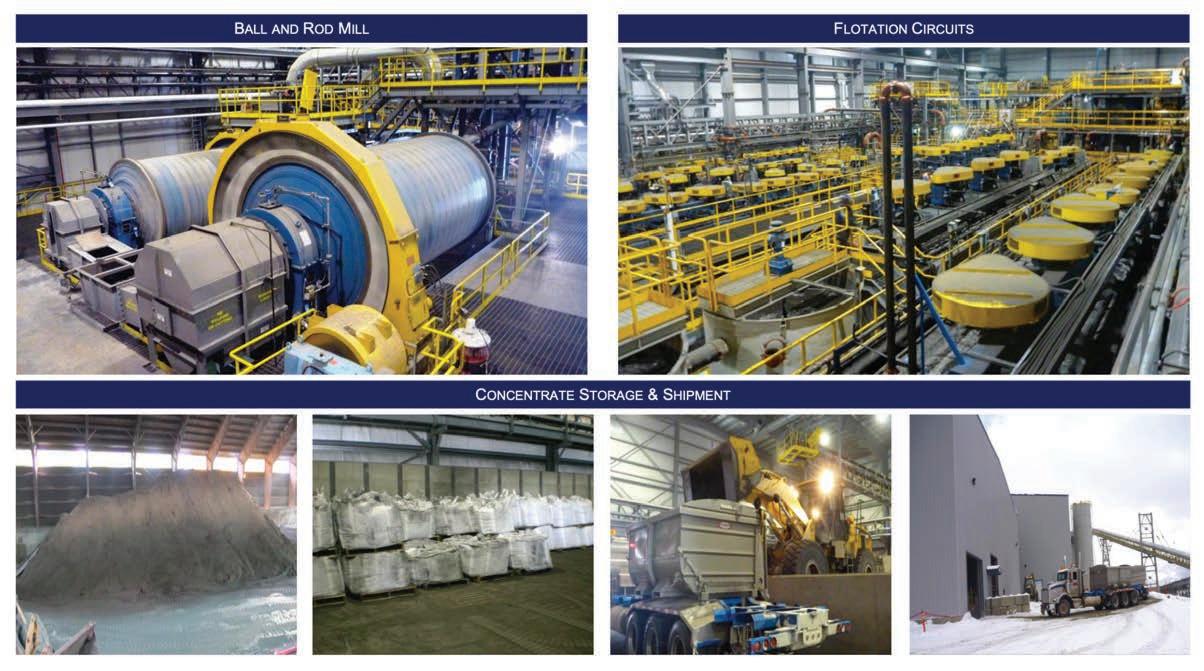
























































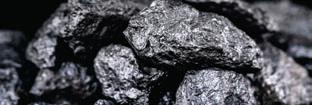

A er 2 years away, the Canadian Mining Symposium is back, and we are excited to have you join us for e Northern Miner’s agship mining and investment event.
e Canadian Mining Symposium is an ideal opportunity to discover compelling junior and mid-tier companies, but also gain a broader understanding of some of the macro issues a ecting the mining and metals markets. We’ve assembled an incredible line-up of mining industry leaders and innovators to tackle subjects like ESG, energy trends, digital transformation, cybersecurity and in many cases, provide a uniquely Canadian perspective.
Enjoy your time with us and ensure to network, join meetings, and engage. Welcome back!
Mr. Boyd serves as the Executive Chair of the Board of Agnico Eagle Mines Limited. Prior to this role, he was Vice Chairman and the Company’s Chief Executive O cer (CEO) from 1998 to 2022. Before his appointment as CEO, Mr. Boyd served as the Chief Financial O cer from 1990 to 1998 and Comptroller from 1985 to 1990. During Mr. Boyd’s tenure as CEO, Agnico Eagle grew from a small, single mine gold producer to a multi-mine international gold mining company. In December 2020, the Globe and Mail ROB Magazine recognized him as its Global Visionary of the Year CEO. He was recognized as e Northern Miner’s Mining Person of the Year in 2007 and 2017 and appeared on the list of e Best-Performing CEOs in the World in the Harvard Business Review in 2010, 2016 and 2017. In 2019, Mr. Boyd was recognized by the Chartered Professional Accountants of Ontario (CPA Ontario) as a Fellow, the highest honour bestowed upon a CPA within the accounting profession. Mr. Boyd also serves on the Board of Directors of e Princess Margaret Cancer Foundation. He has served on the Boards of the World Gold Council and the St. Francis Xavier University Board of Governors. Prior to joining Agnico Eagle in 1985, Mr. Boyd was a sta accountant with Clarkson Gordon (Ernst & Young). He is a Fellow Chartered Professional Accountant (FCPA, FCA) and a graduate of the University of Toronto (B.Comm.).

Phil



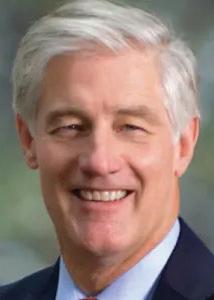







Hecla Mining Company, a 130-year-old company, is the United States largest silver producer, mining over 40% of that country’s silver. Phil has been its CEO for almost 20 years starting with the company when the price of silver was at its lowest price in the last 30 years. As a company with a long history, Hecla had signi cant legacy environmental liabilities which Phil made sure Hecla resolved with hundreds of millions of dollars of expenditures long before ESG became a thing. He sold Hecla’s mines in Venezuela where the company was the country’s largest gold producer using the proceeds to increase Hecla’s ownership to 100% of one the world’s best silver mines, Greens Creek. He has encouraged the development of a new mining method at the long-lived Lucky Friday mine which makes the next twenty years of the mine safer and more productive. He is a leading voice for the importance of silver as a metal necessary for renewable energy. He has seen the highs and lows of our industry.
•
•
•
•




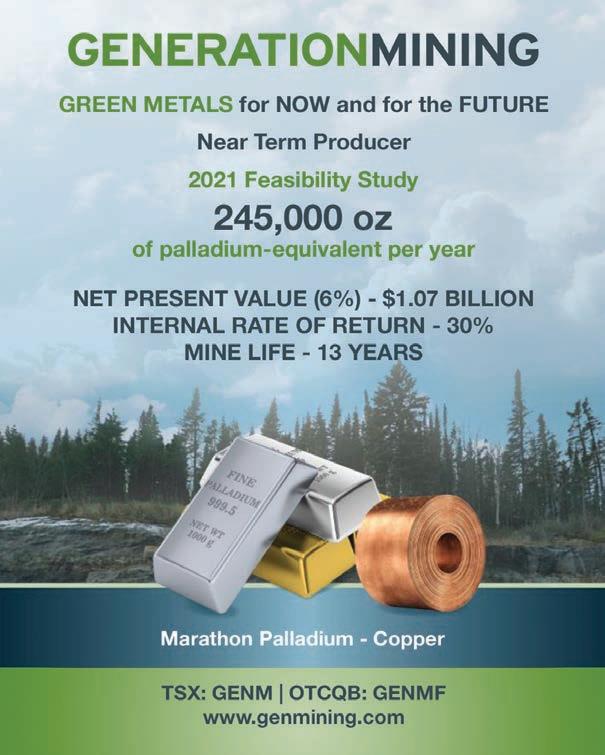

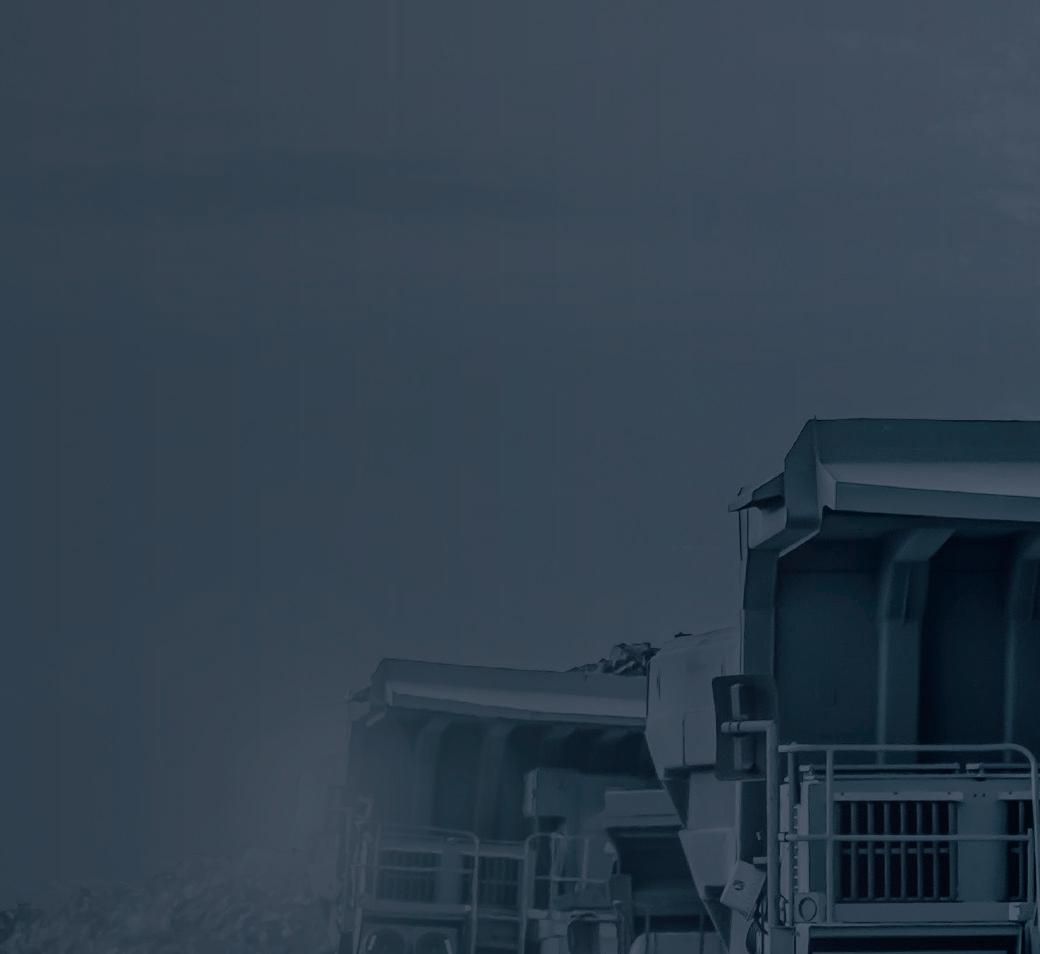

Ms. omas is a Canadian geologist with over twenty- ve years of experience in the Canadian mining industry, including her previous roles as Vice President, Aber Resources, now Dominion Diamond Corp., CEO of Stornoway Diamond Corp., and CEO of Kaminak Gold Corporation. In 2007, Ms. omas founded Lucara Diamond Corporation, with partners Lukas Lundin and Catherine McLeod Seltzer; since February 2018, Ms. omas is President and CEO of the company.
In 2008 Ms. omas is one of only four Canadians that year to be named to the “Young Global Leaders”, by the World Economic Forum, and in 2007 she was selected as one of ‘Top 100 Canada’s Most Powerful Women’. Ms. omas is currently a director of Suncor Energy Inc. and is Suncor’s Chair of the Governance Committee.
Ms. Miller is a professional engineer, executive, and corporate director with 20+ years of experience in engineering design and project management in the mining and transportation industries. Ms. Miller is currently the Vice President of Cybersecurity & Operational Technology at JDS Operational Technologies, part of the JDS Group of Companies. She also serves as an Independent Non-Executive Director for Wesdome Gold Mines and OMAI Gold Mines, Canadian gold mining companies, and a Strategic Advisor at Awz Ventures Inc., a venture capital fund focused on cybersecurity. As a practicing engineer Ms. Miller worked primarily on tailings projects before transitioning to business development. She led the Business Development departments for two of the world’s largest engineering consulting rms’ Toronto o ces: Bantrel with the backing of Bantrel’s parent company, Bechtel; and SNC-Lavalin’s Mining and Metallurgy. At JDS Ms. Miller has focused on building a team specialized in cybersecurity and operational technology and her team is providing these services to the resource industry.
She is a strong advocate on issues pertaining to women in engineering and received the 2017 Leading Women Building Communities Award for her work in this area.
Ms. Miller graduated from the University of Oxford, Saïd School of Business, with an MBA focused on nance and strategy; Massachusetts Institute of Technology (MIT) with a Master’s degree in Civil and Environmental Engineering (specializing in geotechnical engineering); and holds a Bachelor of Applied Science degree from the University of Toronto in Mineral and Geological Engineering. American Eagle Gold is our nal presenter for CMS. Please nd logos, headshot and bio all contained in this email. Please post to landing page and event guide.
Mr.
His


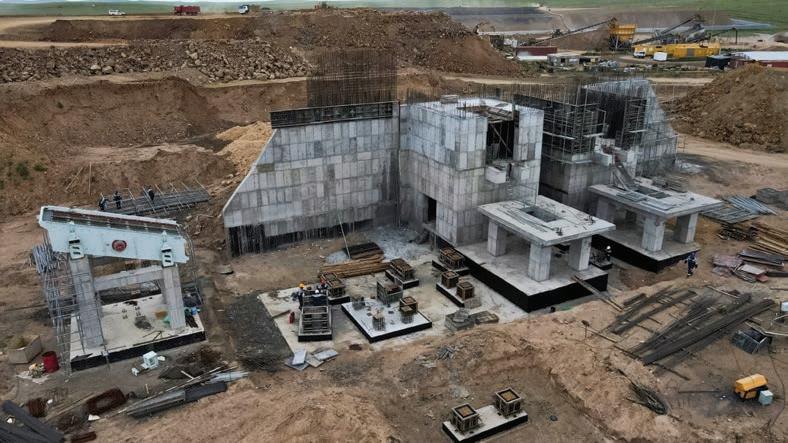



Mr.
With Cameco, his focus was on global activities related to Cameco’s project evaluation, business development, and international exploration activity with direct oversight and accountability for exploration o ces in Mongolia and Australia. He was a member of Cameco’s exploration management team during the recent Fox Lake and West McArthur uranium discoveries. Between 2019 and 2021, he was Chief Operating O cer for CanAlaska Uranium. Since 2021, he has been leading CanAlaska in the role of Executive VP and CEO. Mr. Belyk holds a Bachelor of Science degree in geology from the University of Saskatchewan and a Certi cate in Negotiation from Harvard Law School. He is a registered member of the Association of Professional Engineers and Geoscientists of Saskatchewan and British Columbia.
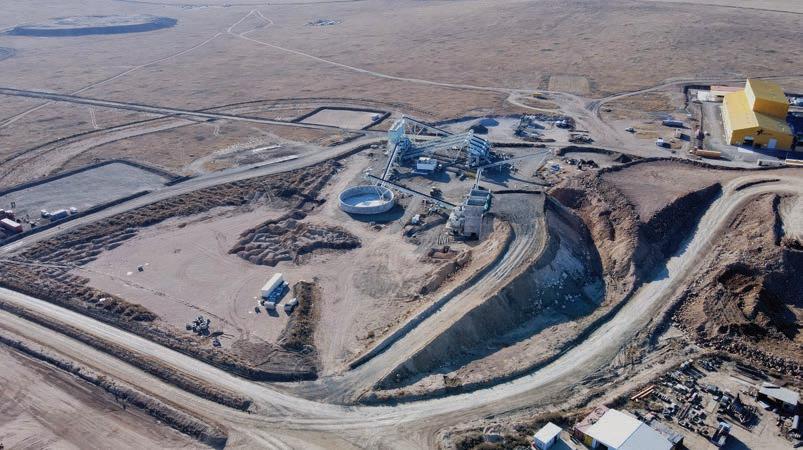

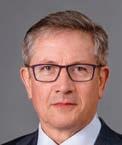

Nicole Brewster brings an early career in capital markets and a successful private practice as an exploration contractor, experienced in acquiring and leveraging data, to execute targeted exploration for clients. is supported a re-invigoration of Renforth, today with ve mineralized assets, including the Parbec open pit gold deposit on the Cadillac Break, adjacent to the Canadian Malartic Mine. Renforth’s Surimeau District Project is a 260 sq. Km land package south of the Cadillac Break which hosts 6 historic polymetallic mineral occurrences, speci cally nickel and copper, along with a handful of gold showings. Renforth just completed signi cant drill programs, at Parbec >15,000m to support an upcoming resource restatement and at Surimeau, on the Victoria West Target area, drilling 2.2 kms of strike within the 5 kms long target, with each of the 15 holes drilled returning nickel, copper and zinc visual mineralization in the core. Assay results for both programs are being released as received.
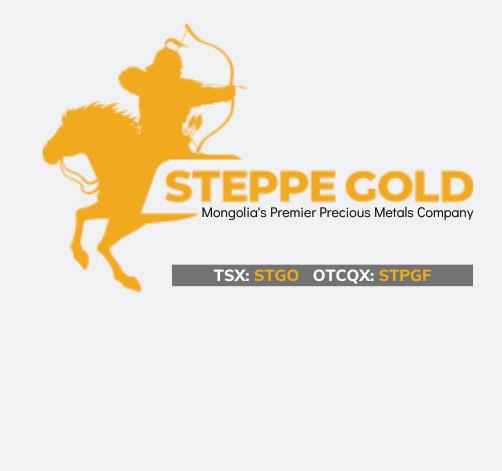
Mr. Frostad is a Founding Partner at Purepoint, bringing over 40 years of expertise to his position as President and CEO. Mr. Frostad has led public companies in both the technology and mining & metals industries. roughout his career, he has been instrumental in the development and building of a variety of high growth, early stage, public and private companies and served as Director for several mining and technology companies. Prior to Purepoint, he held numerous senior positions in the technology industry including CEO in Residence of a Toronto-based Venture Capital rm. Mr. Frostad is a Chartered Accountant and a Chartered Professional Accountant who began his career in International Taxation with Deloitte.


Mr. Halliday graduated from Dalhousie University in 2007 where he majored in Earth Sciences then spent the next 13 years in exploration and as a resource geologist with Kirkland Lake Gold, First Cobalt and SGS Geostat. Matt is a member of the PGO and is a Quali ed Person for Exploration and Resource Development. Matt is passionate about opportunities in the Cobalt Camp and is focussed on developing world class projects in the silver and battery metals space.
Mr. Macdonald is the Vice President of Geological Services
the Manex Resource Group of Companies and in such capacity has been the Vice President Exploration and Exploration Manager for several publically listed companies including Southern Silver Exploration Corp., Homestake Resource Corporation (formerly Bravo Gold Corp.), Valterra Resource Corporation, Duncastle Gold Corp. and Fortune River Gold Corporation.


Mr. Macdonald has overseen the exploration of many projects throughout North America including the discovery and delineation of the highgrade 1.2 million ounce Homestake Ridge Au-Ag deposit in northern British Columbia and is currently advancing Southern Silver’s 24 million tonne Cerro Las Minitas Ag-Pb-Zn project, Durango State, Mexico. Mr. Macdonald graduated with a B.Sc. (Hons) from Memorial University of Newfoundland in 1990 and earned a MSc. from the University of British Columbia in 1999. Over his career in the geosciences Mr. Macdonald’s work has focused on vein and intrusion-related gold systems, VMS and Skarn/CRD environments. Prior to joining Manex, Mr. Macdonald worked as a geologist with the British Columbia Geological Survey and Teck Exploration on projects in Alaska, Peru and British Columbia.
President & Chief Executive O cer, Alamos Gold




John McCluskey has been the President and Chief Executive O cer of Alamos Gold Inc. since 2003. Mr. McCluskey began his career with Glamis Gold Ltd. In 1996 he founded Grayd Resource Corporation, where he was CEO until 2003 and co-founded Alamos with mining hall of famer Chester Millar. Mr. McCluskey was named Ontario’s 2012 Ernst & Young Entrepreneur Of e Year, based on a judging panel’s assessment of nancial performance, vision, leadership, innovation, personal integrity and in uence, social responsibility, and entrepreneurial spirit. Today, Alamos is an established intermediate gold producer with three operating mines in North America and a portfolio of development stage projects in Mexico, Canada, Turkey and the United States.
CEO & Director, American Eagle Gold
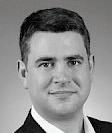

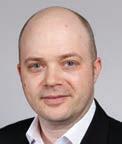

Anthony Moreau is the CEO and Director of American Eagle Gold. He is also a Director of QC Copper & Gold and Ore nders Resources, both TSXV listed companies. He previously worked with IAMGOLD comprising di erent roles within the organization, most recently Business Development and Innovation. He gained valuable experience working in a continuous improvement function at the Rosebel Gold Mine in Suriname. Tony has spearheaded many industry initiatives, one of them being an international co-op peer benchmarking program owned and run by the participating mining companies. He leads the Young Mining Professionals Toronto Chapter and is the Co-Chair of the YMP Scholarship Fund. A graduate of the Queen’s School of Business, Anthony is a Chartered Financial Analyst.
&
Stephen is the CEO & Chair of QC Copper & Gold, and the Founder and Chair of Ore Group, a private group, focused on natural resource discovery and development. Stephen is also Chair of the Young Mining Professionals Global Group and the Founder and Chairman of the Young Mining Professionals Scholarship Fund, the largest mining-focused charitable organization and fund supporting earth science education in Canada. Stephen holds a Bachelor of Arts from the University of Western Ontario, a Master of Business Administration from the University of Toronto, and a Master of Science from the University of Florida.
As the Company’s CEO, President & Director, James Sykes brings more than 15 years of Athabasca Basin uranium exploration experience and success to Baselode Energy Corp. (TSXV: FIND, OTCQB: BSENF), which formed in June, 2020. James has been directly and indirectly involved with the discovery of over 550 M lbs. of U3O8 in the Athabasca, including leading the discovery team for NexGen Energy’s Arrow deposit, having provided invaluable work on Hathor Exploration’s Roughrider deposits, and he was also a member of the Denison Mines exploration team that prioritized the targets that eventually became the Phoenix and Gryphon deposits. James and the Baselode team have demonstrated their understanding of Athabasca exploration by having achieved success in the Company’s rst drill program with a new uranium discovery called ACKIO.






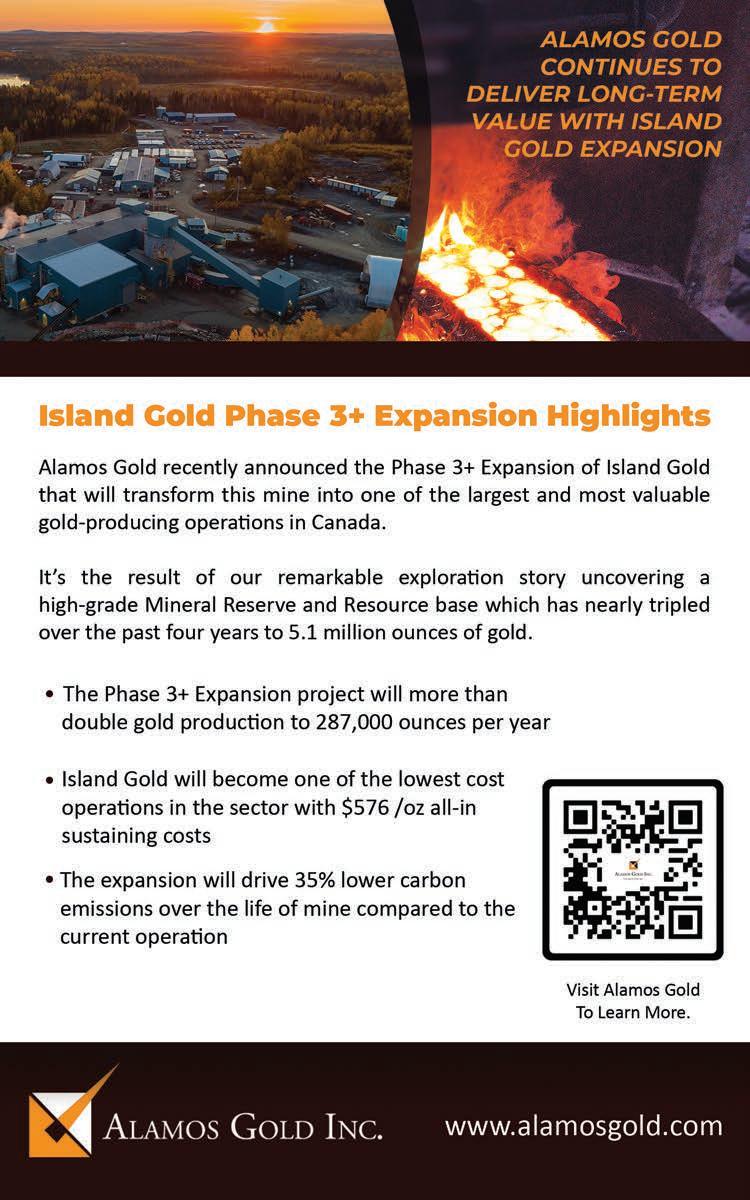

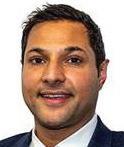
Aneel is EVP and Director of Steppe Gold, and a nancial services professional with 15 years of progressive experience in capital markets having worked on over $1B in deals. He is Founder and Managing Partner of ATMA Capital Markets, focusing on advising public and private companies in the Natural Resources sector. He also serves as a Director of ION Energy Limited and Antler Hill Mining Limited. Aneel received an MBA from the Goodman Institute of Investment Management at John Molson School of Business.

CEO & Director, Slave Lake Zinc
Ritch Wigham, was a registered investment advisor in British Columbia, Alberta, Ontario and Saskatchewan from 1979 to 2016 with Canarim (Canaccord Saskatchewan 1979 to 1984), Davidson Partners (Toronto, Ontario 1984 to 1989), Refco Futures (Vancouver, BC 1989 to 1992), C.M. Oliver (Vancouver, BC 1993 to 1999), Mackie Research Capital (Vancouver, BC 2000 to 2013) and with Global Securities Corporation (Vancouver, BC 2013 to 2016), specializing in commodities and commodity related securities. During the 1970s Mr. Wigham worked for public and government organization as a geological assistant and prospector and studied Geological Sciences for two years at the University of Saskatchewan

TIMEACTIVITY COMPANY
9:00
Registration opens Co ee Station, Sponsored by: Generation Mining
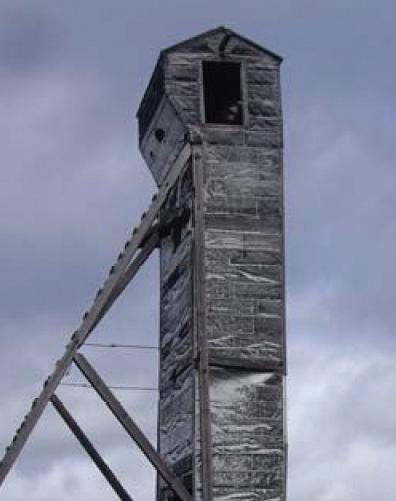
9:30 Opening remarks e Northern Miner Group, Anthony Vaccaro, President
9:40
Investor Presentation #1QC Copper & Gold, Stephen Stewart, CEO & Chair
10:00 Investor Presentation #2Metal Energy, James Sykes, CEO, President & Director
10:20 Investor Presentation #3Canada Silver Cobalt Works, Matthew Halliday, President, COO
10:40 Investor Presentation #4Purepoint Uranium Group Inc., Chris Frostad, President & CEO
11:00 Investor Presentation #5Southern Silver, Robert Macdonald, VP Exploration
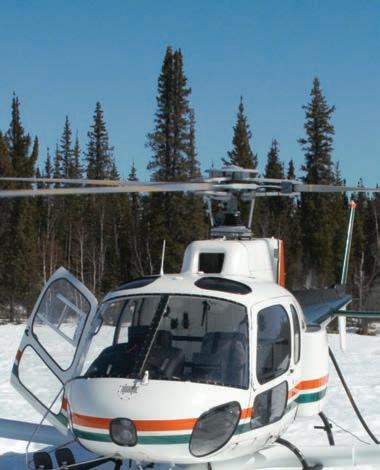

11:20 Featured Speaker Nadine Miller, VP Cyber Security, JDS Energy & Mining
11:50 Investor Presentation #6Alamos Gold Inc., John McCluskey, President, CEO & Director
12:10 Investor Presentation #7Slave Lake Zinc, Jas Rai, President & CEO
12:30LUNCH BREAK Bu et Lunch

1:05 Investor Presentation #8American Eagle Gold, Anthony Moreau, CEO & Director
1:20 Keynote Speaker Eira omas, President & CEO, Lucara Diamond

1:50 Investor Presentation #9CanAlaska Uranium Ltd., Cory Belyk, CEO & Executive VP
2:10 Investor Presentation #10Renforth Resources, Nicole Brewster, President & CEO
2:30 ought Leadership PanelGovernment of Quebec, “Quebec: Rich In Possibilities”
3:10 Investor Presentation #11Equity Metals, Robert Macdonald, VP Exploration
3:30 Keynote Speaker Phil Baker, President & CEO, Hecla Mining Company
4:00 Investor Presentation #12Steepe Gold, Aneel Waraich, President & CEO
4:20 Keynote Speaker Sean Boyd, Executive Chair of the Board, Agnico Eagle Mines Ltd.
4:50 Keynote Panel Panel of Featured Speakers - Sean Boyd, Eira omas, Phil Baker & Nadine Miller
5:20 Gold Sponsor RemarksPearTree Canada, Lisa Davis, CEO, PearTree Securities
5:35 - 6:30 Cocktail Reception Sponsored by TMX, Graham Dallas, Head of Business Development






















































Québec, rich in minerals and opportunities Québec, it’s more than 200 000 active mining titles, 22 active mines, 32 mining projects, 2.66G $ in private mining investments and 11.91G $ in shipment value. Québec has signi cant mining potential that accounts for one- h of Canada’s mineral production. e province produces and develops 17 metals and 12 non-metallic commodities, making it the most diverse resource base in Canada. Québec is the 1st Canadian province to adopt a plan for critical and strategic minerals and contributes to supplying these minerals, since it produces nickel, niobium and graphite, and mining projects are underway for lithium, vanadium, rare earths and tantalum. Québec is one of the most attractive mineral jurisdictions in the world with a stable business environment and favourable to investments. We assist companies at all stages in the development of their mining projects. anks to hydropower, roughly 99% of our energy is low-cost, stablypriced, clean and renewable and we have a vast infrastructure network including roads, railways, ports and airports. Québec is strategically located north-east of the United States with a year-long maritime access to Ontario and the american midwest through the St-Laurence Seaway. It is close to major population and industrial centres and has easy access to Europe and Asia thanks to its deep-water ports. Québec also works closely with associations representing the mining sector and with communities that host projects. These communities are natural project partners and work with the Government to develop the mining sector. The Government also promotes the mining sector by outlining the principles of sustainable development and best practices of social acceptability through initiatives such as the ECOLOGO certification.
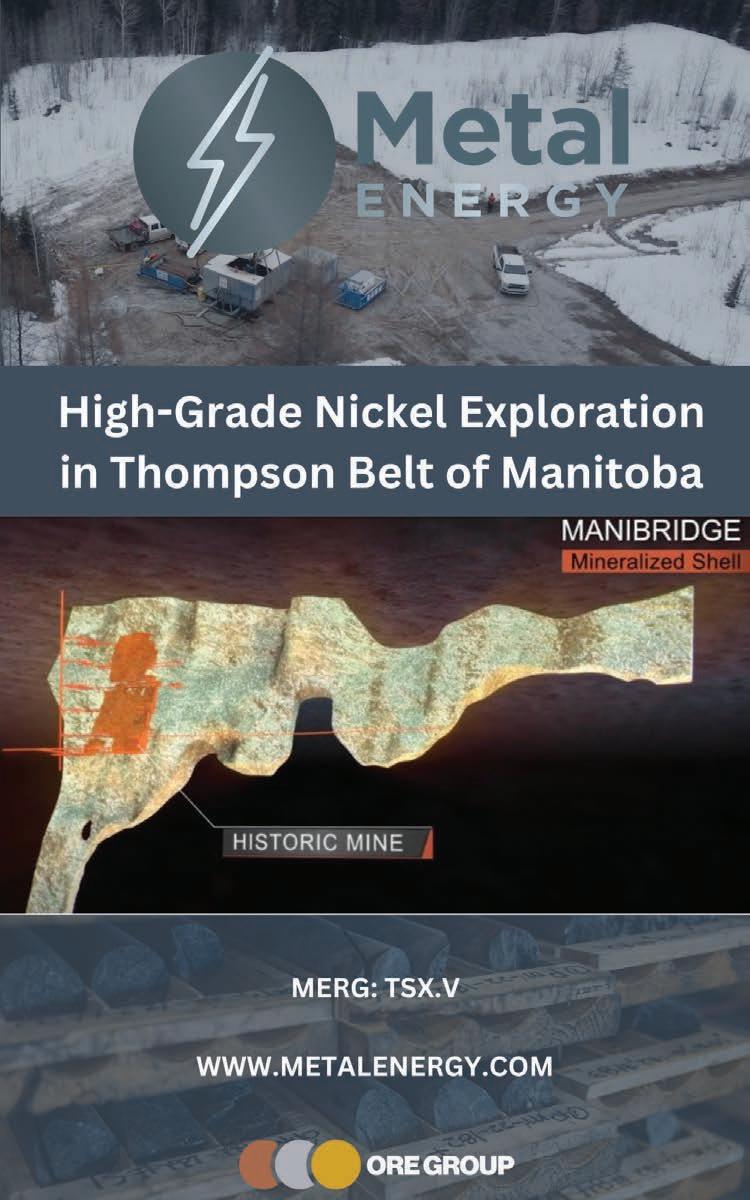

Associate Deputy Minister of Mines, Ministère de l’Énergie et des Ressources naturelles
Nathalie Camden has been Associate Deputy Minister of Mines at the Ministère de l’Énergie et des Ressources naturelles since June 2018. Ms. Camden began her career in the Québec public service in 1992 at the Ministère de l’Énergie et des Ressources naturelles, where she was promoted to Director of Aboriginal A airs in 1998. She has held several management positions in di erent sectors of this ministry (Forestry and Mining) and was Associate Deputy Minister of Wildlife from 2009 to 2014.
From 2015 to 2017, she served as Assistant Secretary to the Northern Development Secretariat and the Société du Plan Nord, where she actively participated in the creation of the latter as a strategic advisor to the President and Chief Executive O cer of the Société. From June 2017 to June 2018, she was Assistant Deputy Minister of Business Partnerships and Customer Services at the Ministère du Tourisme. She has been a member of the board of directors of the Agence de Revenu du Québec since 2017. Ms. Camden obtained her bachelor’s degree in political science from Université Laval in 1987, with a specialization in American politics and economics from Assumption College in Worcester, United States. She completed a certi cate in administration in 1995 at Université Laval.




From 2015 to 2021, he applied his management expertise in the cleantech sector as Vice-President, Strategy and Corporate A airs at General Fusion Inc., based in Vancouver, British Columbia. From 2007 to 2015, he was employed by AREVA S.A. in Paris and Toronto, chie y as Executive Vice-President of AREVA Canada Inc. Before he launched his career path in the private sector, Mr. Béland gained extensive experience in the Canadian civil service and in the O ce of the Prime Minister of Canada as an advisor on governance policies and the Treasury Board of Canada.Mr. Béland is a graduate of Université de Montréal (B.Sc.), École nationale d’administration publique (MPA and post-graduate diploma in public administration), École des hautes études commerciales (post-graduate diploma in management), Bordeaux École de Management (MBA), Université Paris IX Dauphine (M.Sc., strategic management) and University of British Columbia (project management certi cate). In 2014, he completed the Senior Nuclear Plant Management course (SNPM).
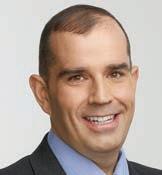
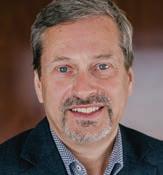
Mr. Béland is a Knight [Chevalier] of the National Order of the French Legion of Honour and a member of the Advisory Board of the Gina Cody School of Engineering and Computer Science, Concordia University.

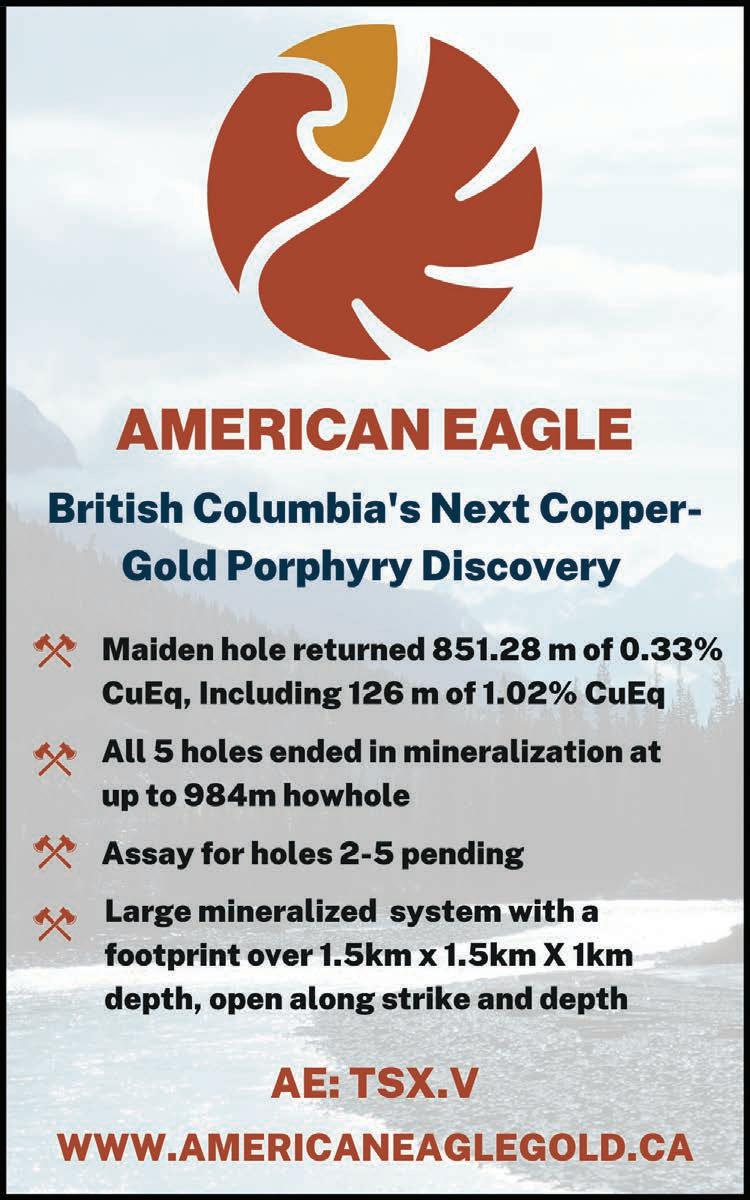


Mr. Brisson joined SOQUEM in January 2021. With a bachelor’s degree in geology from the Université du Québec à Chicoutimi, Mr. Brisson has held several senior positions with exploration and mining companies in Quebec, Ontario and North Africa. A member of the Order of Geologists of Quebec, Mr. Brisson has 30 years of experience in precious and base metal exploration, mine development and mining operations. He has worked for several public companies, notably Goldcorp, Iamgold, Breakwater Resources, Cambior, Focus Graphite and Cogitore Resources. Prior to join SOQUEM, he was an exploration consultant for junior and major mining companies in Quebec and Ontario since 2015. Mr. Brisson has served on the boards of directors for several junior exploration companies and the Quebec Mineral Exploration Association.
Mr. Jocelyn Douhéret joined the Société du Plan Nord in April 2016 as Director of the Business Development O ce. Previously, Mr. Douhéret had been involved in the mining industry for more than 10 years as business development director and then vice-president of a mining services company. From 1998 to 2006, he worked for Québec companies on industrial development projects in Eastern Europe, Latin America and Canada, particularly in the natural resources, energy and environment sectors. Mr. Douhéret began his career as scienti c attaché at the French Embassy in Slovakia in 1996. He holds a master’s degree in science from Laval University in Quebec (Canada – 1996) and an engineering degree from the National School of Agricultural Engineers of Dijon (France – 1994).

Québec, rich in minerals and opportunities Québec, it’s more than 200 000 active mining titles, 22 active mines, 32 mining projects, 2.66G $ in private mining investments and 11.91G $ in shipment value.

Québec has significant mining potential that accounts for one-fifth of Canada’s mineral production. The province produces and develops 17 metals and 12 non-metallic commodities, making it the most diverse resource base in Canada. Québec is the 1st Canadian province to adopt a plan for critical and strategic minerals and contributes to supplying these minerals, since it produces nickel, niobium and graphite, and mining projects are underway for lithium, vanadium, rare earths and tantalum. Québec is one of the most attractive mineral jurisdictions in the world with a stable business environment and favourable to investments. We assist companies at all stages in the development of their mining projects. Thanks to hydropower, roughly 99% of our energy is low-cost, stably-priced, clean and renewable and we have a vast infrastructure network including roads, railways, ports and airports.
Québec is strategically located north-east of the United States with a year-long maritime access to Ontario and the american midwest through the St-Laurence Seaway. It is close to major population and industrial centres and has easy access to Europe and Asia thanks to its deep-water ports. Québec also works closely with associations representing the mining sector and with communities that host projects. These communities are natural project partners and work with the Government to develop the mining sector. The Government also promotes the mining sector by outlining the principles of sustainable development and best practices of social acceptability through initiatives such as the ECOLOGO certification.


PearTree Securities is Canada’s leading source of flow-through capital for exploration and development financing. Working alongside global investors, PearTree provides over $500M annually in capital for the mineral exploration and development sector. Since 2007, the PearTree platform has provided exploration and development funding at a premium share price, reducing share dilution. Together with long-term investors globally, we create an opportunity for their involvement at discounted purchase prices, with no fees charged to market participants. PearTree’s platform “subsidizes” their cost of investment by capturing the value of tax deductions and credits available to initial Canadian subscribers for the benefit of issuers and global investors. The flow-through share donation platform has transformed equity raising for exploration in Canada, addressing ESG concerns - more charitable giving and better governance over corporate spending resulting in more projects progressing on time and on budget.
The TMX Group is a large Toronto-based financial services company that operates the Toronto Stock Exchange (TSX), TSX Venture Exchange, Montreal Exchange, and TSX Alpha Exchange. The group operates exchanges for derivatives, equity, and fixed income trades through trading, clearing, depository, and settlement services.


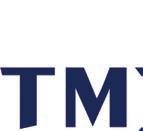
Generation Mining is developing its Marathon Project, a large undeveloped palladium-copper deposit in Northwestern Ontario, Canada. Generation Mining’s Feasibility Study, released in March 2021, estimated that at US$1,725/oz palladium, and US$3.20/lb copper, Marathon’s Net Present Value (at 6% discount rate) is approximately C$1.07 billion with a payback of 2.3 years and an Internal Rate of Return of 30%. Upfront capital costs were estimated at C$665 million, net of equipment financing and precompletion operating costs and revenues. The mine is expected to produce 245,000 palladium equivalent (PE) ounces per year over a 13-year mine life at an All-In Sustaining Cost of US$809 per PE ounce. Under a Precious Metal Purchase Agreement with Wheaton Precious Metals Corp, Wheaton will pay Generation Mining CAD$240 million in return for a stream on all gold production and 22% of the platinum production. Generation Mining has received the first two tranches of this financing for a total of CAD$40 million. Final Ministerial (Federal and Provincial) decisions in the Environmental Assessment process are expected by November 30, 2022. Upon receipt of favourable decisions and the required permits, the Company anticipates starting early construction activities late in the first quarter of 2023.


Canada Silver Cobalt Works is a dual-focus precious metals and battery metals junior mining company with a valuable portfolio of critical energy metals projects based in safe and ecologically responsible jurisdictions. Highgrade Silver deposits with Cobalt by-ptroduct. Battery Metals deposits with high-grade Nickel, Copper and Cobalt, as well as Platinum and Palladium. Re-2Ox processing technology for the environmentally compliant production of battery metals.
Purepoint Uranium Group Inc. (TSXV: PTU/ OTCQB: PTUUF) is actively advancing a carefully assembled portfolio of strategically situated, drill ready uranium projects in the Athabasca Basin, the world’s richest uranium region. In addition to its flagship joint venture project at Hook Lake with partners Cameco and Orano, and a second joint venture with Cameco at Smart Lake, Purepoint also holds ten, 100% owned projects with proven uranium rich targets. The company has aggressive exploration programs underway at multiple projects.
American Eagle recently made a new discovery on its NAK, a porphyry copper-gold project exhibiting many signs of a robust and large-scale system.
The discovery hole, drilled in November of 2022 has yielded exceptional results, helped define the geometry of the mineralizing system at depth and confirmed the geophysical interpretation.

American Eagle’s drill program on NAK is ongoing, and the Company trades under the symbol AE on the TSX Venture.
CanAlaska Uranium Ltd. is an explorer and project generator focused on uranium and nickel discoveries, with large land holdings in the Athabasca Basin of Saskatchewan and in the Thompson Nickel Belt in Manitoba. CanAlaska has a series of high-grade uranium discoveries, highlighted by a recently announced new discovery intersection of 9 metres at 2.4% U3O8, at its 79%-owned West McArthur project, under a JV with Cameco, new mineralized uranium intersections at its 25%-owned Moon Lake South project, under a joint venture agreement with Denison Mines, and a new polymetallic uranium discovery at its 100%-owned Waterbury South project.

Equity Metals Corporation is a Manex Resource Group Company. Manex provides exploration, administration, and corporate development services for Equity Metals’ two major mineral properties, the Silver Queen Au-Ag-Zn-Cu project, located in central B.C., and the Monument Diamond project, located in Lac De Gras, NWT. The Company also has a 1% royalty (Greenwood Royalty) and a 100% working interest in the La Ronge Silica Project. The Company owns 100% interest, with no underlying royalty, in the Silver Queen project, located along the Skeena Arch in the Omineca Mining Division, British Columbia. The property hosts high-grade, precious- and base-metal veins related to a buried porphyry system, which has been only partially delineated. The Company also has a controlling JV interest in the Monument Diamond project, NWT, strategically located in the Lac De Gras district within 40 km of both the Ekati and Diavik diamond mines. The project owners are Equity Metals Corporation (57.49%), Chris and Jeanne Jennings (22.11%); and Archon Minerals Ltd. (20.4%). Equity Metals is the operator of the project.

The 100% controlled La Ronge Silica Project is an historic sand quarry located in central Saskatchewan, approximately 60 kilometers south-southeast of La Ronge, Saskatchewan and 210 kilometers west of Flin Flon, Manitoba. Preliminary studies indicate the silica deposit may be developed into a simple and profitable, low-cost mining and washing operation to produce high-purity silica (>98% SiO2), a specialty product for the EV battery industry.
Southern Silver Exploration Corp. is an exploration and development company with a focus on the identification of world-class mineral deposits in major jurisdictions, advancing them either directly or through joint-venture relationships. Our specific emphasis is on advancing the 100% owned Cerro Las Minitas project, one of the world’s largest undeveloped silver-lead-zinc deposits, to a production decision. See below.
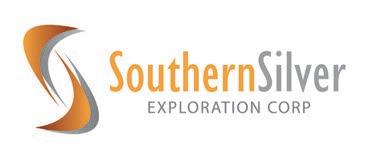
Southern has assembled a team of highly experienced technical, operational and transactional professionals to support our e orts in developing (recent robust PEA) the Cerro Las Minitas project into a premier, high-grade, silver-lead-zinc mine. Our property portfolio also includes the Oro porphyry copper-gold project where a diamond drill program is underway and the Hermanas goldsilver vein project where permitting applications for the conduct of a drill program is underway; both are located in southern New Mexico, USA. Cerro Las Minitas Project; Southern Silver continues to advance the Cerro Las Minitas project as one of the world’s largest undeveloped silver/lead/zinc resources, through advanced exploration, preproduction metallurgical and engineering work, and economic assessment. The CLM Ag-Pb-Zn-Cu Skarn system is well located in southern Durango, Mexico, in a safe jurisdiction, surrounded by producing mining companies, with easy access and strong community support. A total of 226 drill holes for 96,411 metres has been completed on the CLM Project with exploration expenditures of over US$35.0 million equating to exploration discovery costs of approximately C$0.09 per AgEq ounce.
Renforth Resources Inc. is engaged in developing its’ wholly owned 330 km2 Surimeau District Project, Quebec’s newest polymetallic battery minerals system with several areas of mineralization, including the nickel, cobalt, copper and zinc mineralized Victoria structure. Victoria boasts ~20km of strike with surface mineralization and limited drilling, road access and hydroelectric power. Nearby Renforth also holds Parbec, a gold deposit with an obsolete 2020 MRE, beside Canada’s largest open pit gold mine, which is undergoing a model update after the last round of successful drilling to expand the deposit. Renforth Resources Inc. is headquartered in Pickering, ON, Canada.
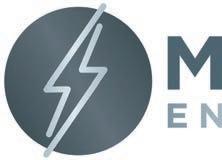

Metal Energy is a well-funded nickel and battery metal exploration company advancing its flagship Project, Manibridge. The Project encompasses the Manibridge Mine, a pastproducing Falconbridge mine where they produced 1.3M tonnes @ 2.55% Ni and 0.27% Cu. Metal Energy benefits from extensive previous exploration and mining knowledge as the past producing mine last operated in the 1970’s in a significantly lower nickel price environment. The Manibridge Mine trend includes a 3 km strike length of mineralization, including the highgrade Ni Manibridge North zone, that remains underexplored. The Project is located in the Thompson Nickel Belt, one of the richest nickel districts in the world, in the politically stable jurisdiction of Manitoba, Canada.

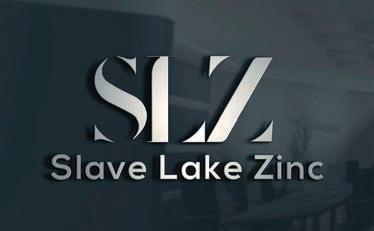
Steppe Gold is Mongolia’s premier precious metals company, with an action-packed expansion story. Steppe commenced production in 2020, and is projected to produce 90,000 ounces gold from the operational oxide zone of ATO Gold Mine in 2023/2024. The Company completed a feasibility study into expansion of its flagship ATO Gold Mine to approximately 90,000 –100,000 ounces of gold annually, from the development of underlying fresh rock ores.
Slave Lake Zinc has developed a significant land holding in the under-explored South Slave Region of the NWT. With the “Collaboration” of the Northwest Territory Métis Nation and the assistance of the other Indigenous groups representing the stake holders of the South Slave, the Historic O’Connor Lake Zinc, Lead, a Critical Metals deposits are ready to be expanded to the next phase of development. Slave Lake Zinc is a company that was set up as a public company, to explore and expand the historic O’Connor Lake Zinc, Lead, deposit first developed and subsequently closed do to poor economics in the early 1950,s. With having negotiated the withdrawal of an additional 18,841 acres surrounding the original grandfathered lease and with the blessing of all levels of government as well as the stake holders of the land, we (Slave Lake Zinc) are ready and prepared to develop this historic mine with modern techniques to fulfill the potential of the withdrawal for the benefit of the stake holders and shareholders of Slave Lake Zinc.
QC Copper is focused on growing and developing its Opemiska Copper Mine Complex, which hosts a maiden Resource Estimate of 81.7M tonnes @ 0.88% CuEq Measured and Indicated and 21.3M tonnes @ 0.73% CuEq of Inferred pit-constrained resources.
Alamos Gold is a Canadian-based gold producer with a long-term track record of creating value for all stakeholders through solid financial performance, low-cost production growth, and a company-wide commitment to social responsibility and environmental stewardship. We currently operate three mines – two in Canada and one in Mexico – and we have a strong portfolio of development stage projects. Our core values of safety, teamwork, environmental sustainability, integrity and commitment allow our more than 1,900 dedicated employees to thrive in their careers and to create a lasting legacy that benefits all Alamos stakeholders.

